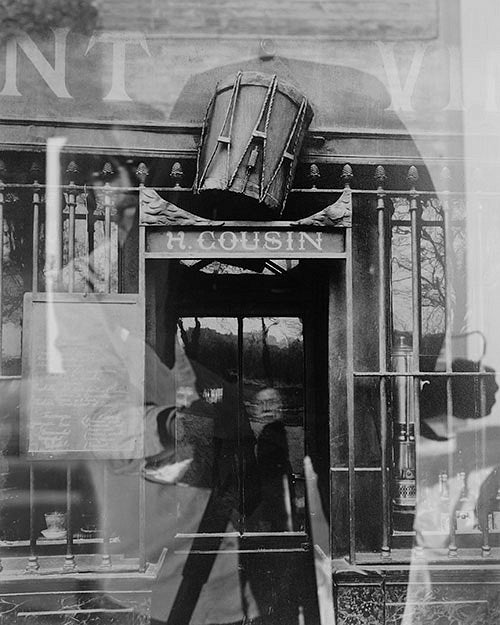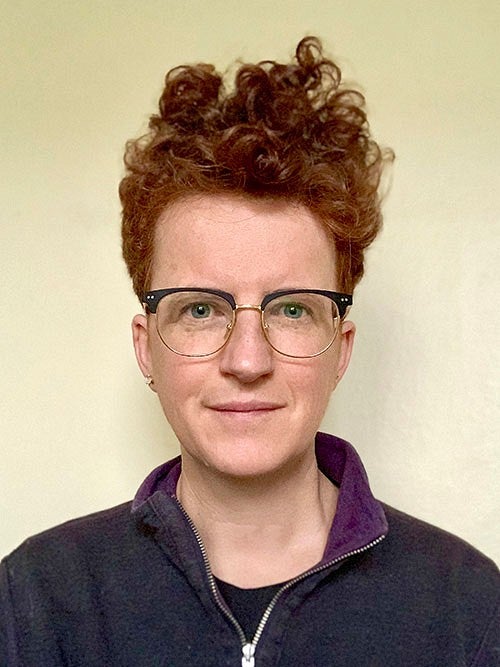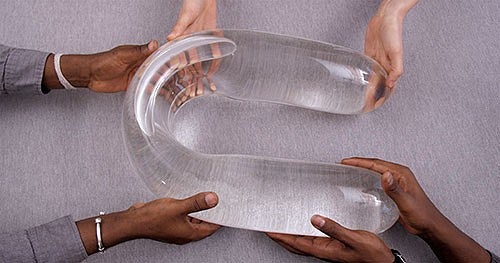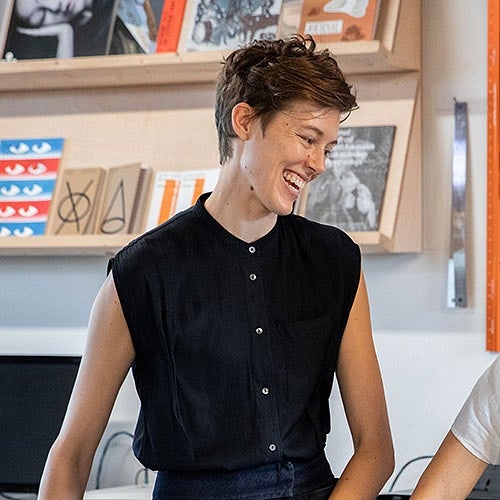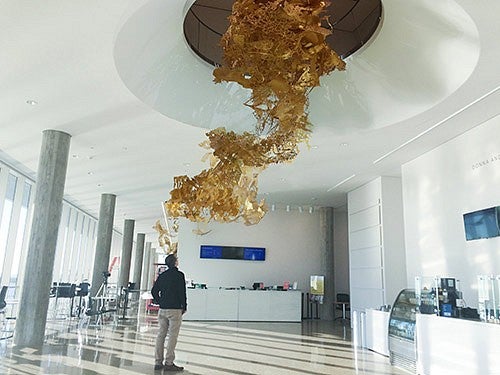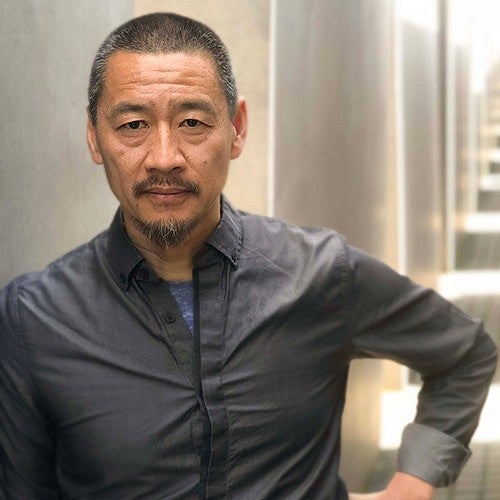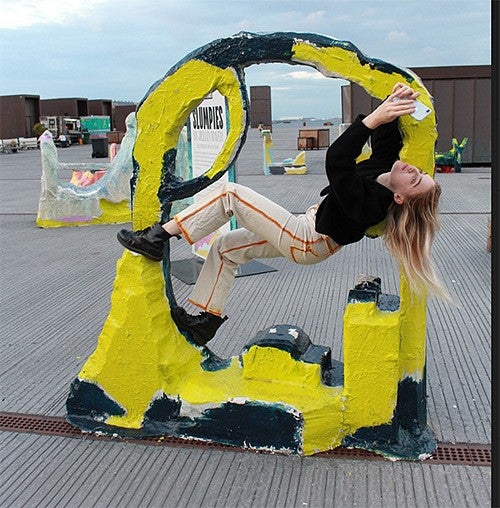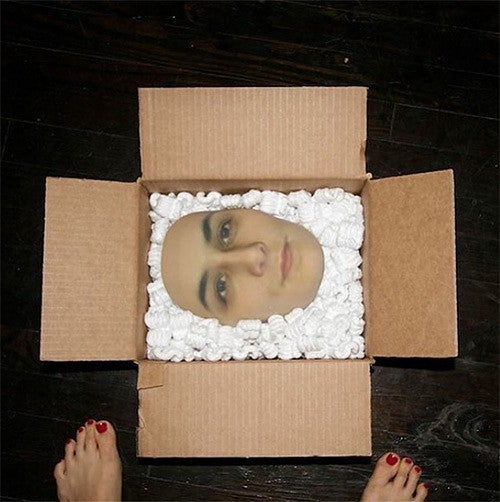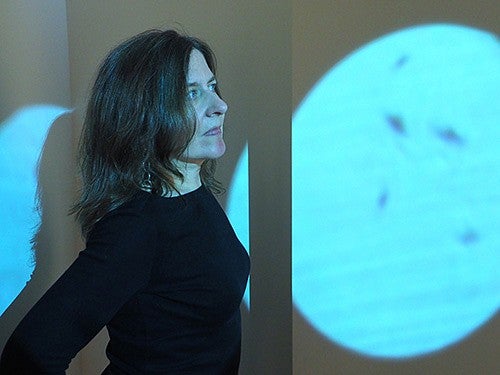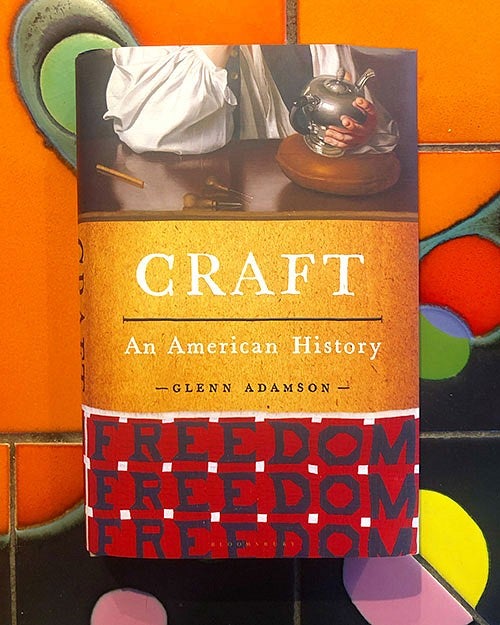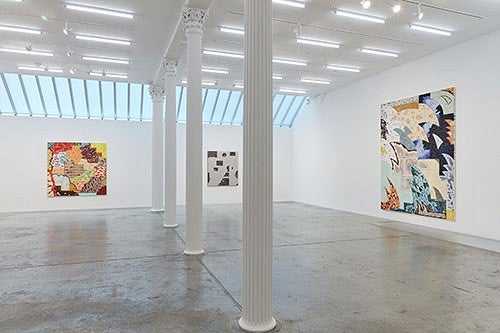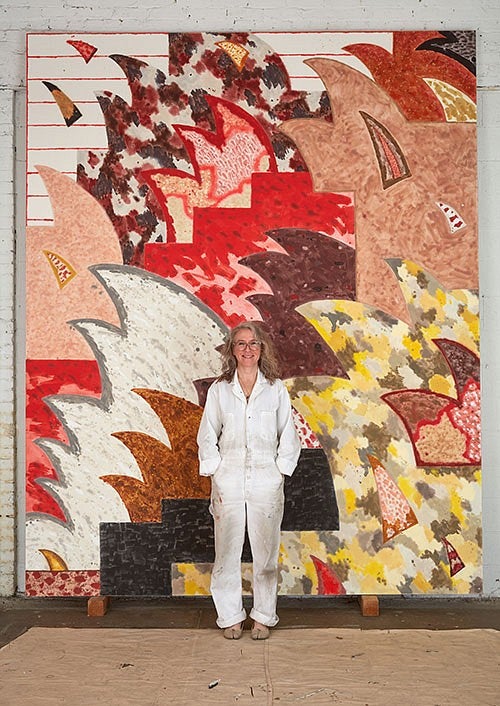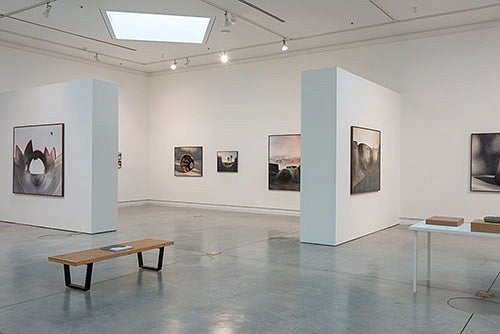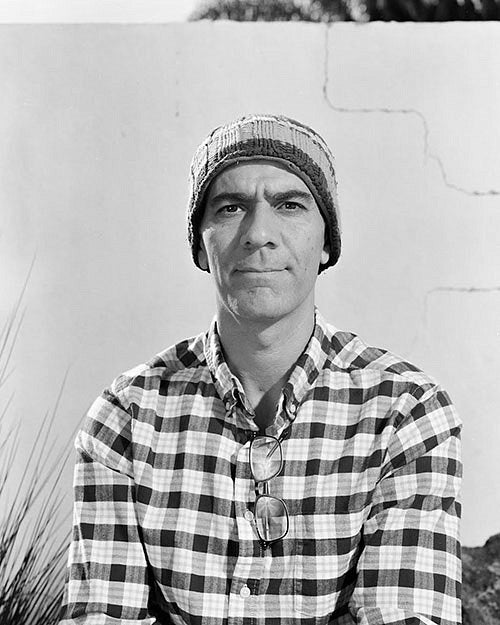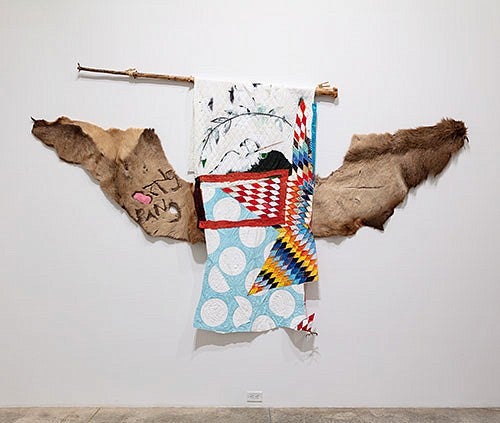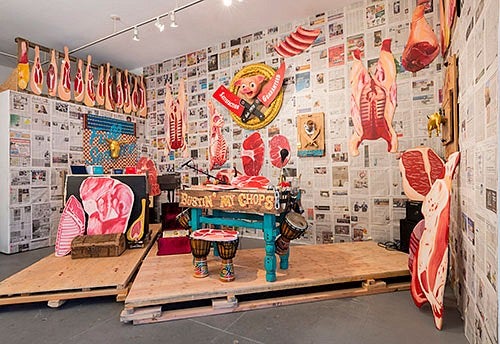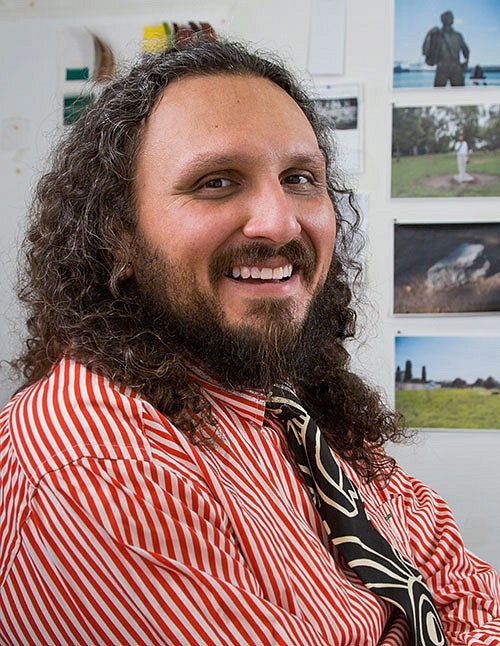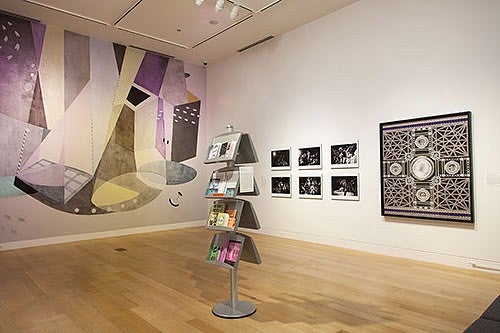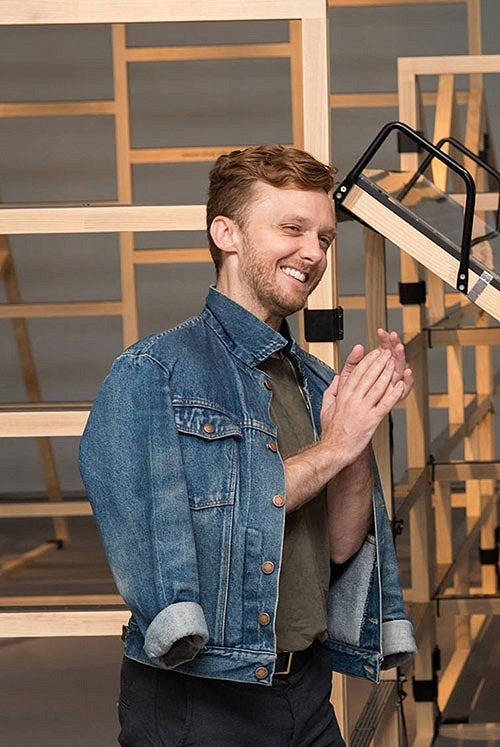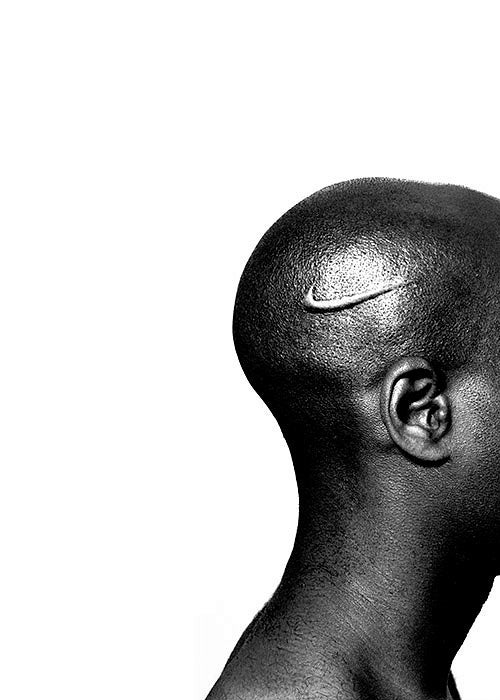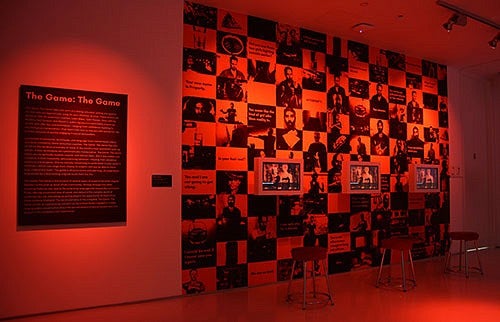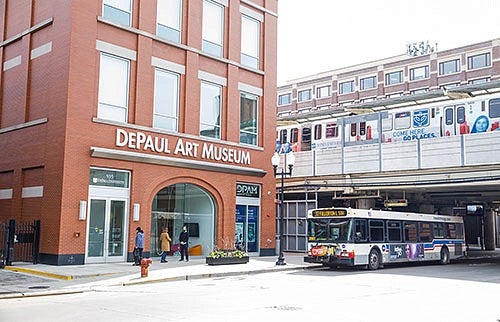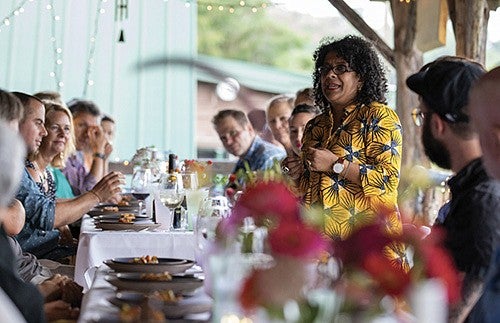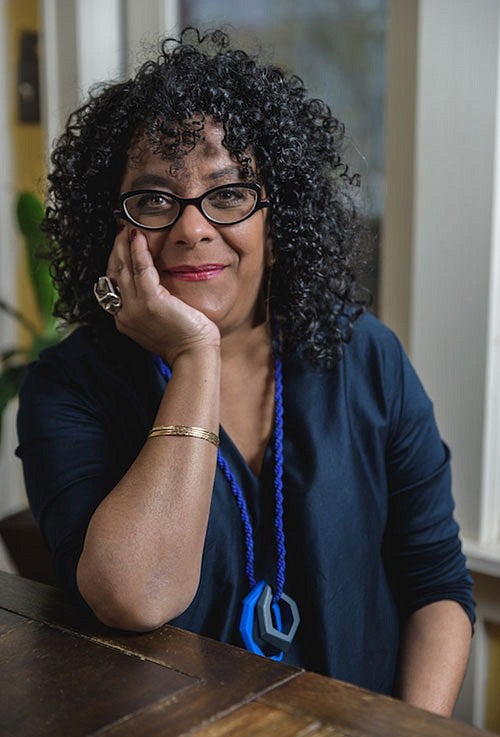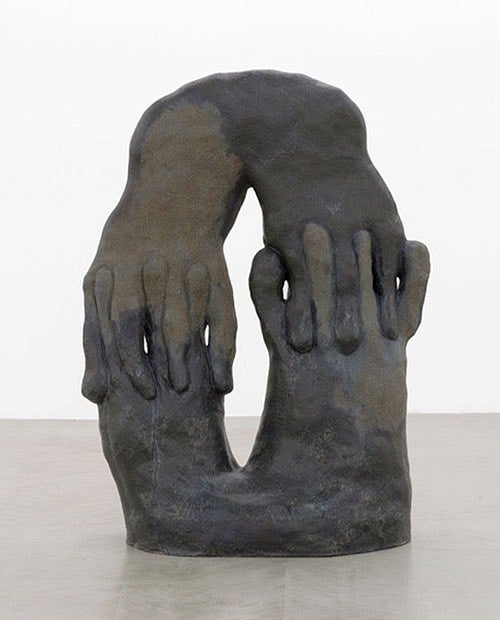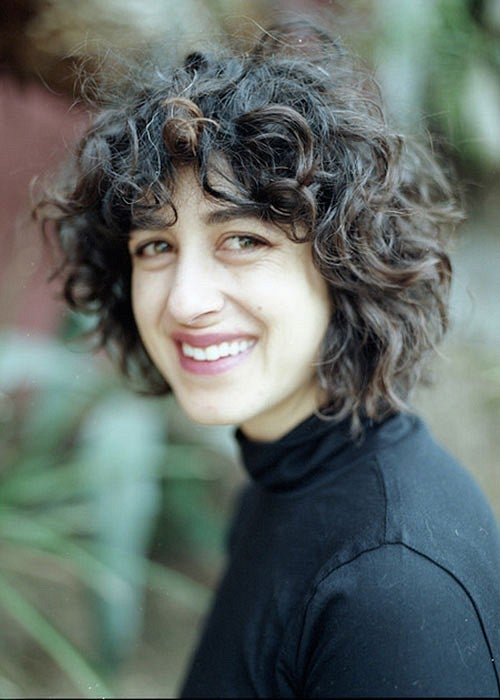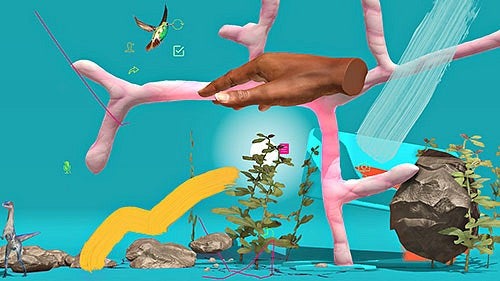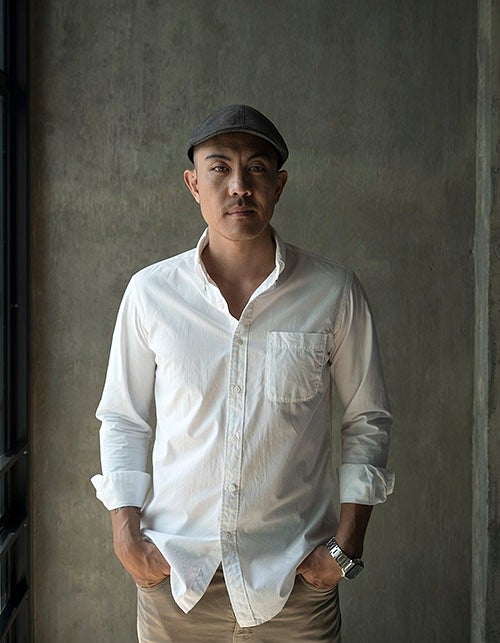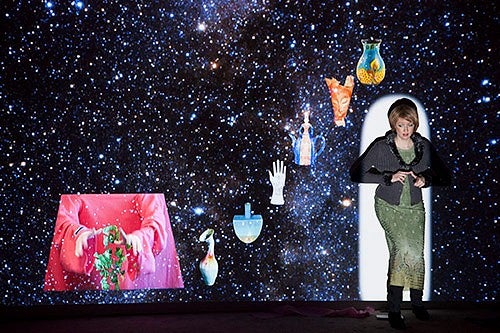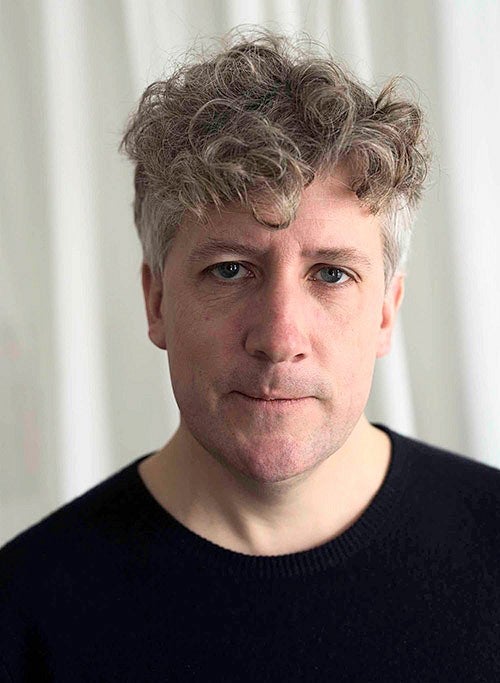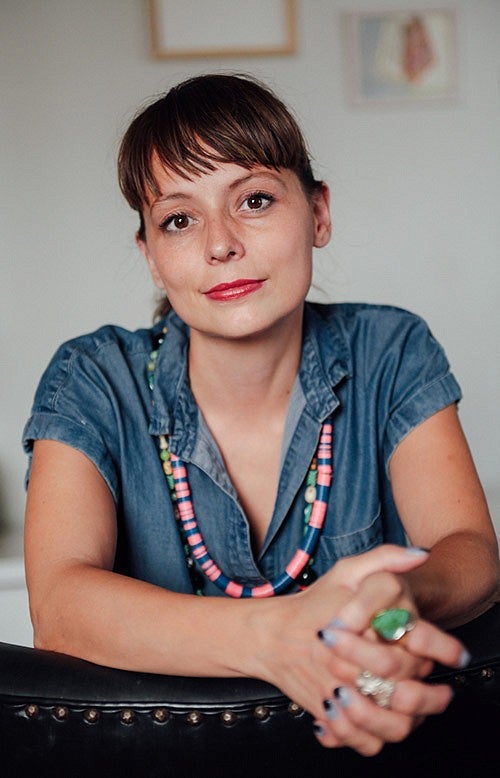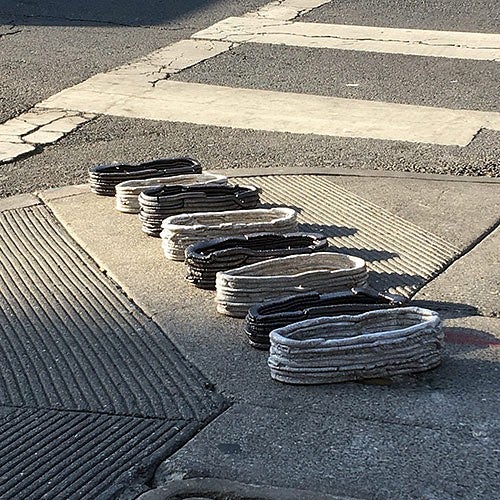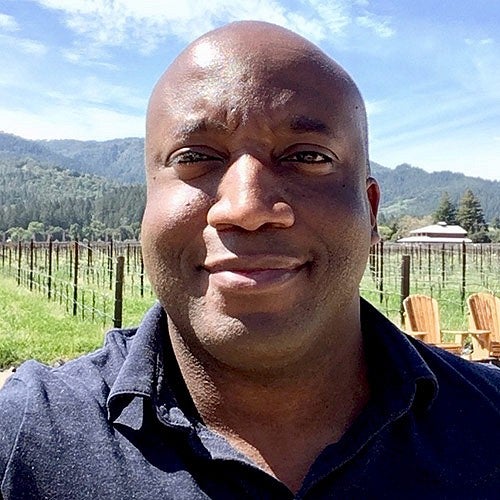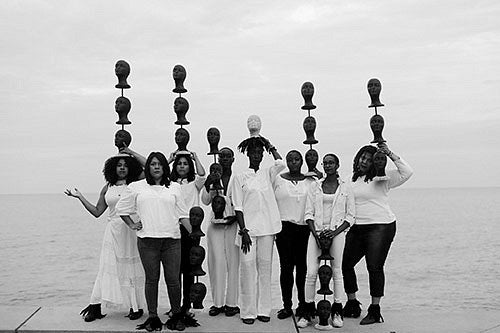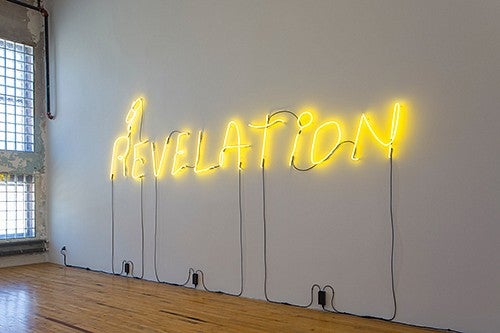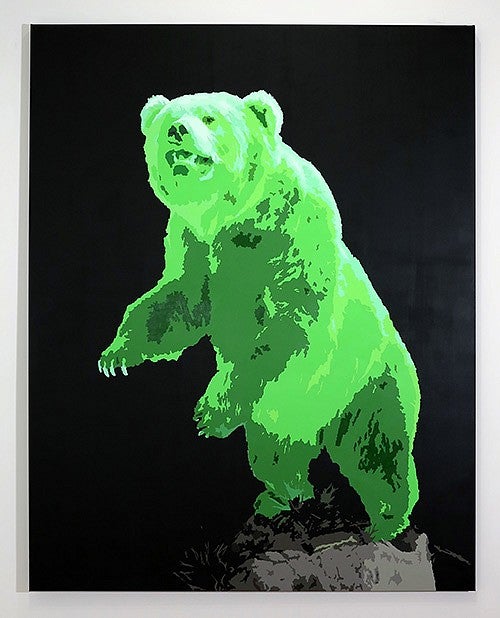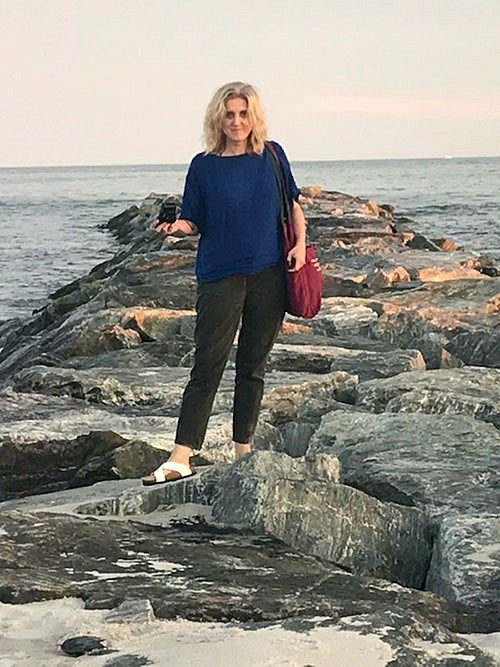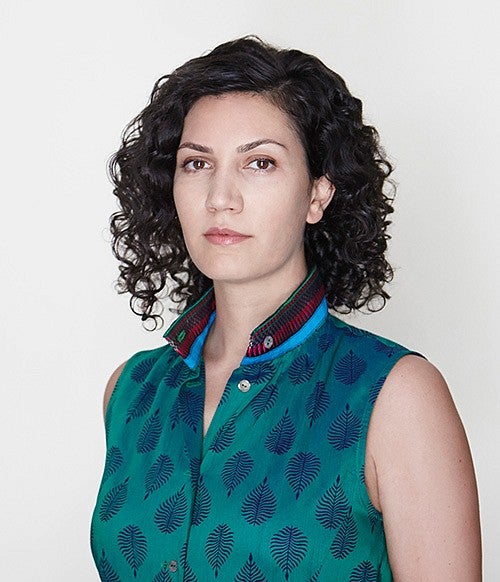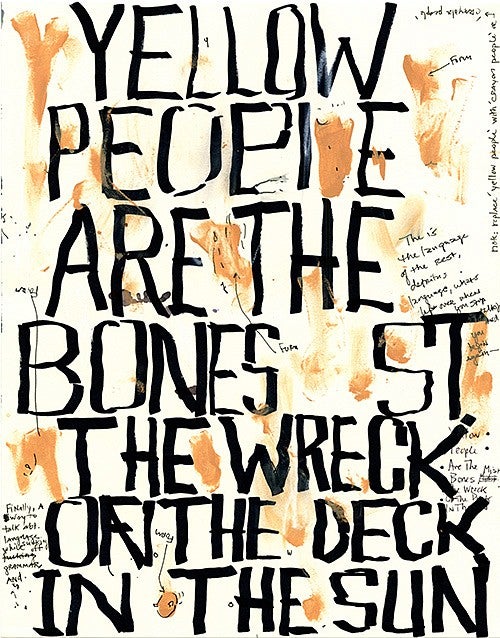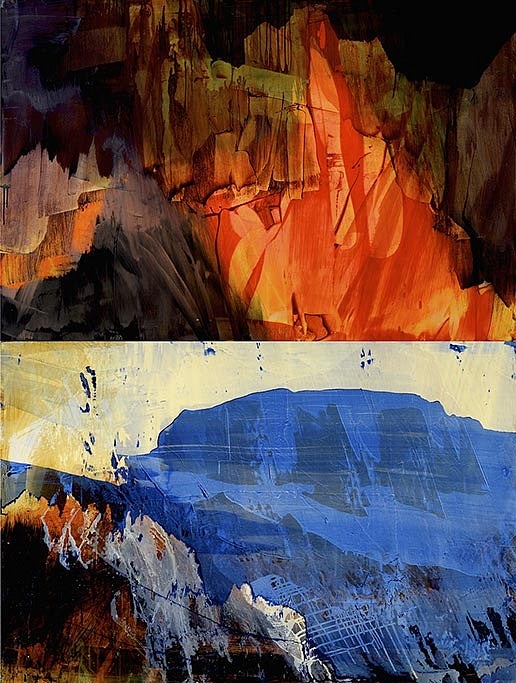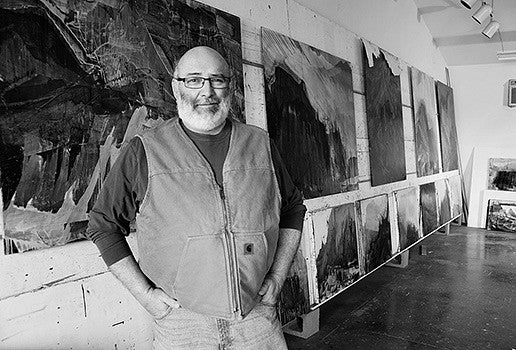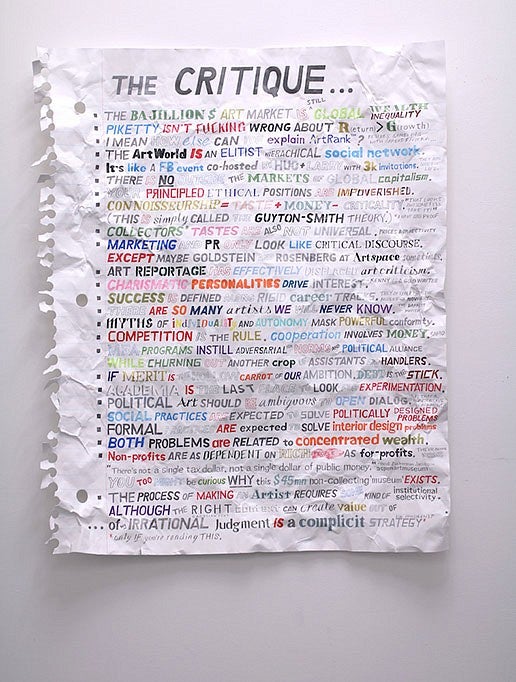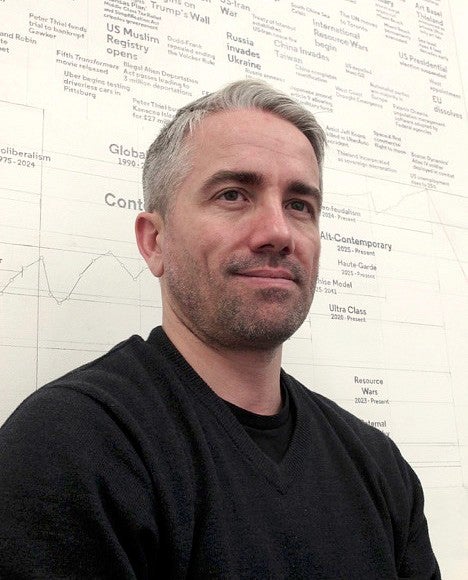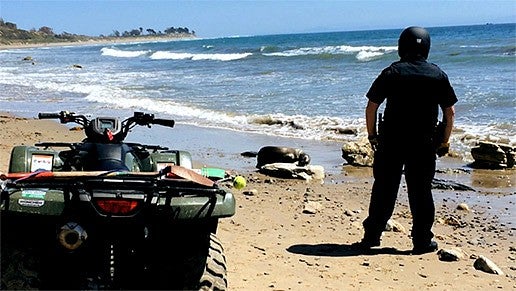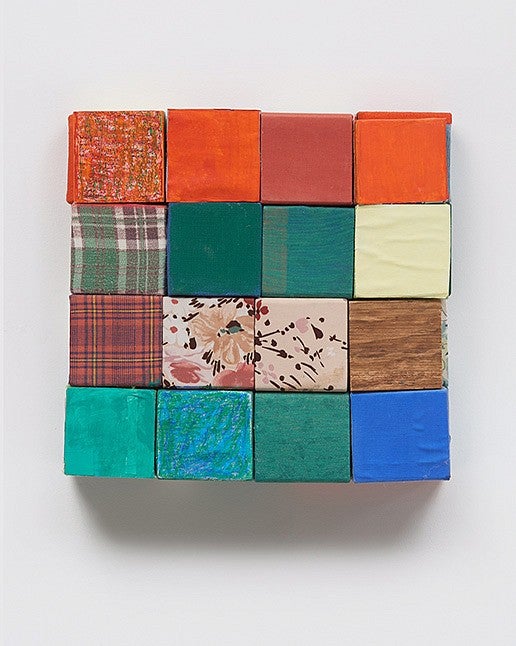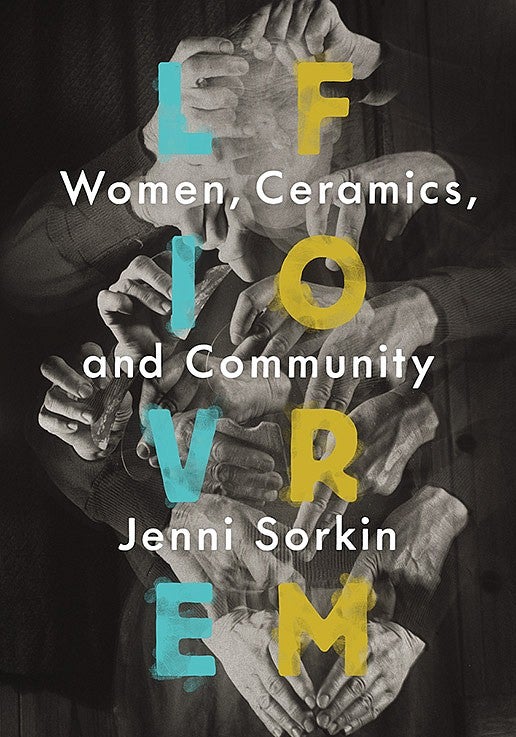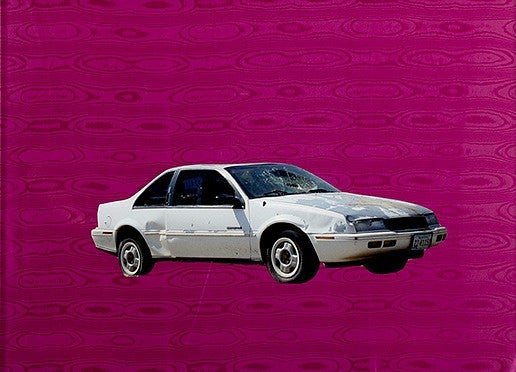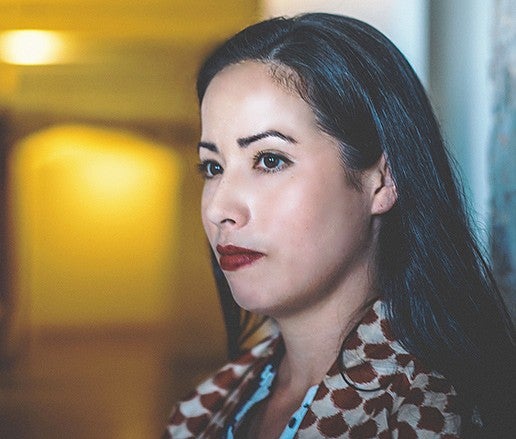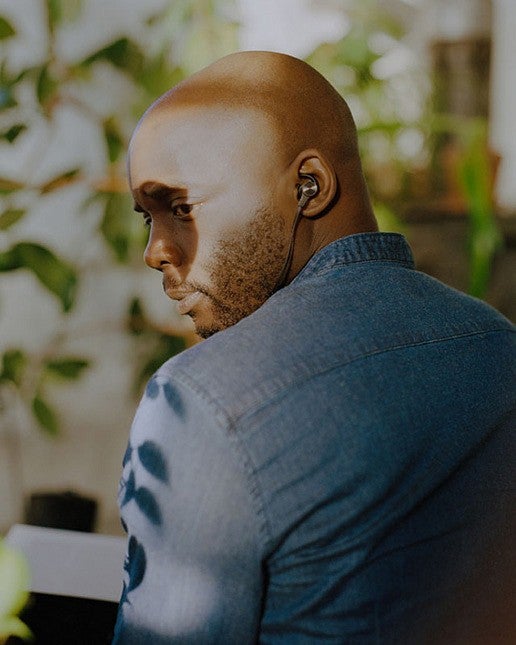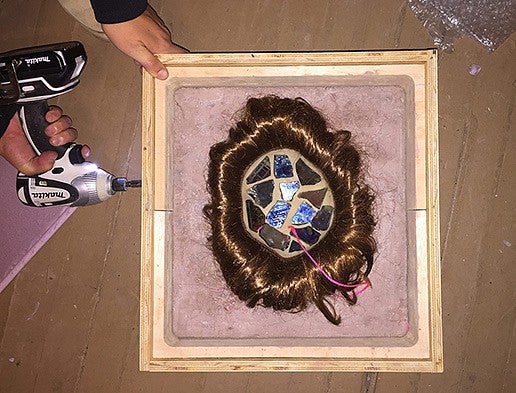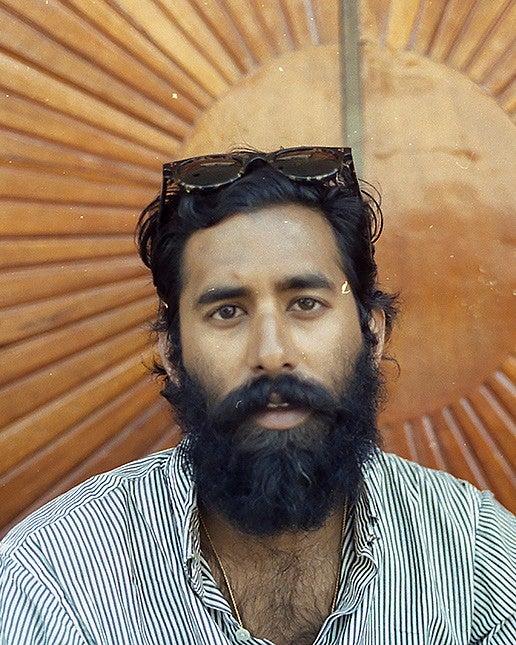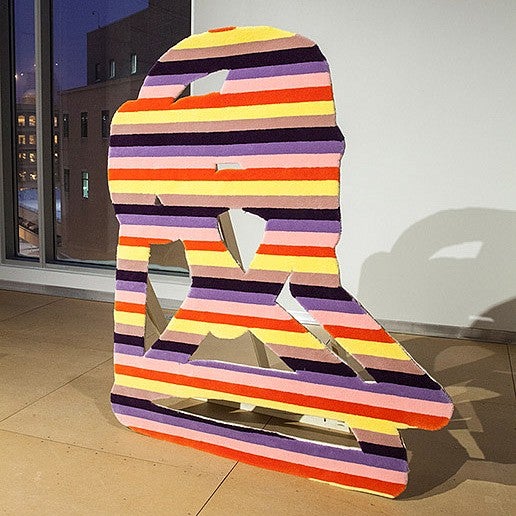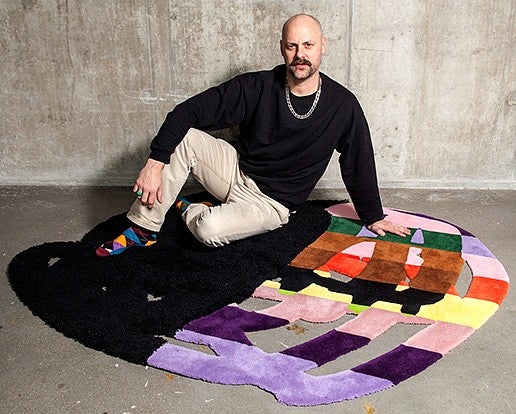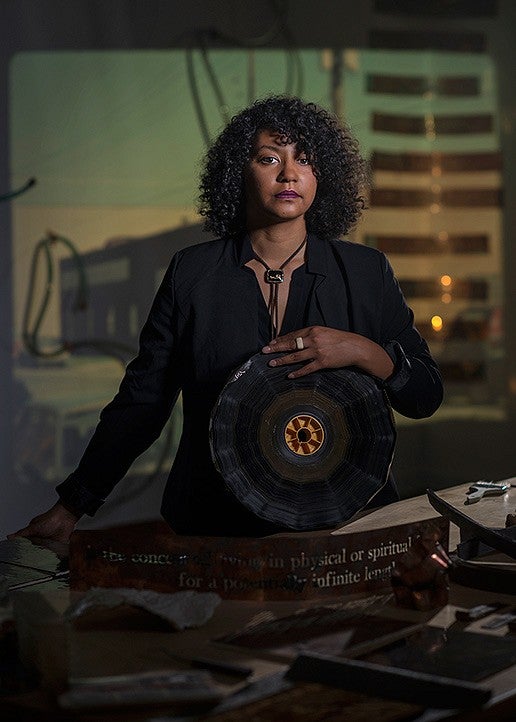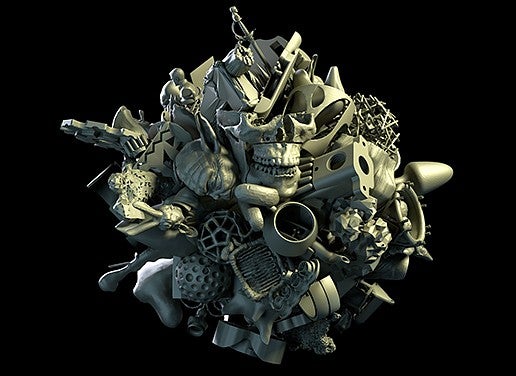2023-24 | 2022-23 | 2021-22 | 2020-21 | 2019-20 | 2018–19 | 2017–18 | 2016–17 | Video Archive
Lecture videos are archived on YouTube. We invite you to explore 5 Minutes for conversations between Visiting Artists and Department of Art MFA Program candidates.
2023–24 Visiting Artist Lecture Series
The Policing Justice Lecture Series is co-presented by the Department of Art and the Department of the History of Art and Architecture and is co-sponsored in part by the Oregon Humanities Center Endowment for Public Outreach in the Arts, Sciences, and Humanities, The Mark Sponenburgh Endowment, The Sally Claire Haseltine Endowed Fund in Art History, and the Davis Family Art Endowment.
Fall 2023
October 5
October 19
October 26
November 16
Winter 2023
January 18 - Cancelled, will be rescheduled
February 22
March 7
Aurora Tang
“Critical Conversations Lecture”
October 5
Watch a video of the Aurora Tang lecture on YouTube.
Aurora Tang is a curator and researcher, often working at the intersections of contemporary art, architecture, and landscape studies. In this lecture, Aurora will share recent curatorial and research projects, produced as an independent curator, as well as with the Center for Land Use Interpretation, a non-profit arts and culture organization interested in exploring and understanding contemporary landscape issues in the United States.
Aurora Tang is a curator and researcher based in Los Angeles. She has worked with the Center for Land Use Interpretation since 2009, and currently serves as its program director. As an independent curator, Aurora has organized recent exhibitions at the MAK Center for Art and Architecture, MOCA Tucson, and Armory Center for the Arts. She has also worked at non-profit art and research organizations including the Getty Research Institute, Getty Conservation Institute, and High Desert Test Sites, where she was managing director from 2011–15, and has taught at schools including Otis College of Art and Design and the University of Southern California. She is the recipient of an Andy Warhol Foundation for the Visual Arts Curatorial Research Fellowship.
This lecture is made possible by the Critical Conversations program, a partnership between the Ford Family Foundation and the University of Oregon Department of Art's Center for Art Research with Reed College’s Douglas F. Cooley Memorial Art Gallery, Pacific Northwest College of Art, and Portland State University.

Aurora Tang.
Motomichi Nakamura
“Exploring Fear, Curiosity, and Shared Connections across Artistic Media”
October 19
Watch a video of the Motomichi Nakamura lecture on YouTube.
“Over the years, I have created artwork in various media, including paintings, sculptures, graphic design, video installations, VJ performances, and projection mapping. In this lecture, I will discuss my desire to establish emotional connections with people, particularly through the feelings of fear and curiosity. I will delve into the significance of passion and personal feelings in the creation of impactful artwork and my ongoing exploration of new media as a means to expand artistic boundaries.” Motomichi, 2023
Motomichi Nakamura is a Japanese-born, award-winning Projection Artist and Animator based in Croton On Hudson, NY. His work is known for the use of black, white, and red and he creates monsters with minimalistic graphic elements inspired by Cryptozoology and Mythology. He has exhibited globally in numerous museums and galleries including the New Museum in New York, Moscow Contemporary Art Center Winzavod, MARCO in Monterrey Mexico, Olympia Park Munich, Maison de la culture du Japon à Paris, La Gaîté Lyrique, among others. His animated films have been screened at Sundance Film Festival, Onedotzero Festival, and Edinburgh International Film Festival and his recent film “Okami” won in The Leeds International Film Festival. His clients include EA, MTV, USA Networks, and Sony, and he has produced music videos for artists including Nicola Cruz and the Swedish band, The Knife.
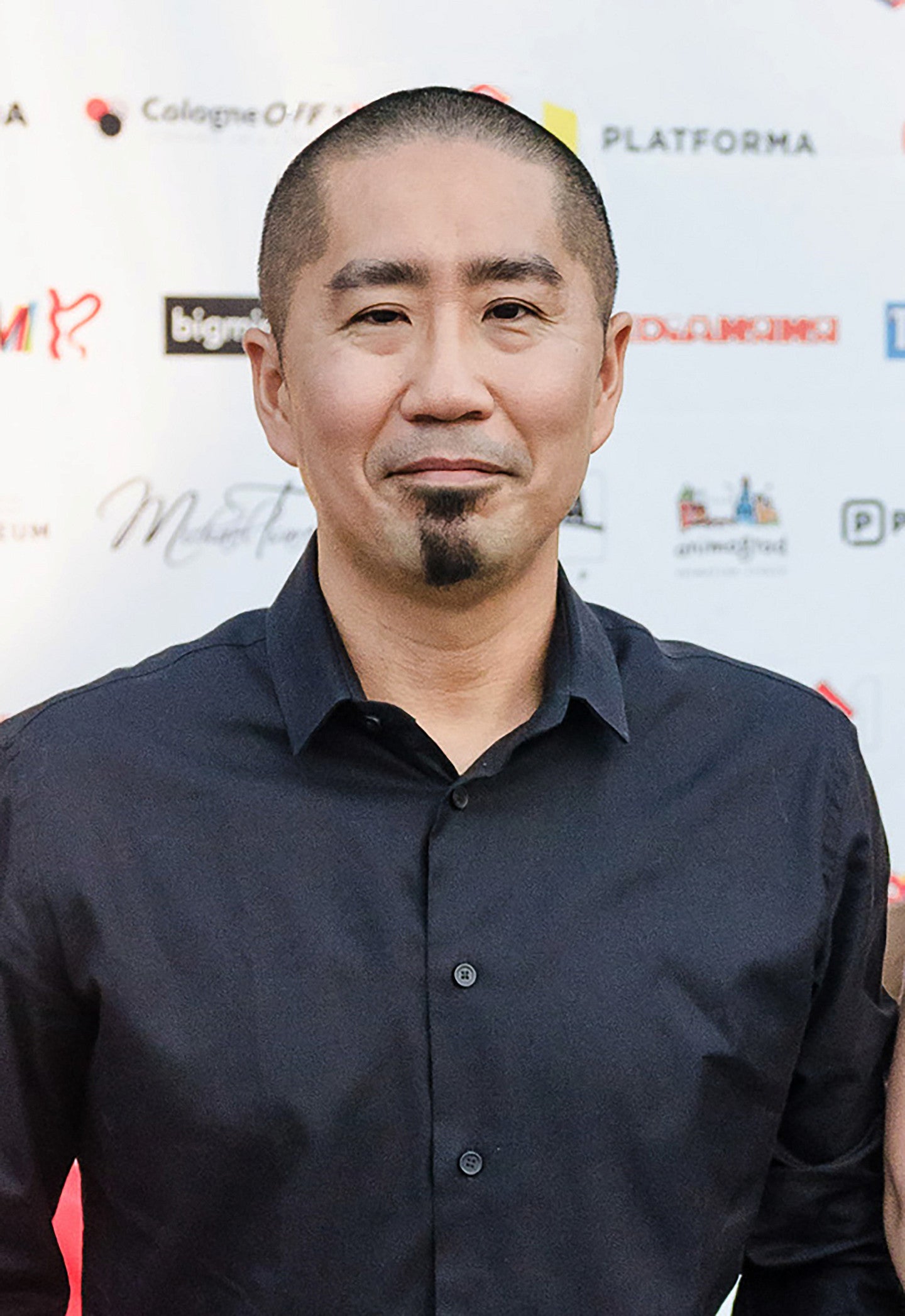
Motomichi Nakamura.
Gracelee Lawrence
“Digital Materiality: Tense Pixels”
October 26
Watch a video of the Gracelee Lawrence lecture on YouTube.
Gracelee Lawrence’s sculptures, relying equally on digital fabrication and hand augmentation, examine the relationship between food, the body, and technology at an exaggerated scale. A physical origin point is isolated and translated to digital space, often influenced by what is found in our ever more real and familiar internet world. As the barriers between digital and physical spaces dissolve, our perception of reality also shifts, and the compartmentalization encouraged in digital space leads to a new world less and less concerned with the human touch, yet Lawrence’s work dips into both territories with equal aplomb.
Lawrence conjures a bushel of digitally-skewed fruits and vegetables dealing with hybridity, reproduction, humor, and sexuality. The sculptures are created from a combination of 3D scanned material, virtual reality sculpting, and fully digitally created assets, then 3D printed by Lawrence in their studio. The objects are all printed with polylactic acid (PLA) filament, a vegetable-derived bioplastic most commonly made from fermented corn starch, continuing to link material and content. The interplay between the physical and digital methods, material poetics, and intrinsic humor creates a unique web of logic that Lawrence is known for. Considering produce as a vehicle for understanding hegemonic systems of power and control, nutrition and intimacy, and technological invention, Lawrence’s sculptures dangle in the transfigurative space between digital and physical reality.
Lawrence has attended twenty residencies in the US and abroad and opened her second solo show in New York at Postmasters in June 2022 with a glowing review by Roberta Smith in the New York Times. She is currently an Assistant Professor of Sculpture at the University at Albany, SUNY. Recent exhibitions include Peter Gaugy (Vienna, Austria), PRIOR Art Space (Barcelona, Spain), Patrick Mikhail (Montreal, CA), Kavi Gupta (Chicago, IL), Turley Gallery (Hudson, NY), and more. She has installed large-scale outdoor sculptures at the Upstate Immersive (Poughkeepsie, NY), Wave Hill (Bronx, NY), Museum of Museums (Seattle, WA), Franconia Sculpture Park (Shafer, MN), Mary Sky (Hancock, VT), and others. She is a recipient of the 2021-22 Individual Artist DEC Grant, a 2019 Jerome Fellow at Franconia Sculpture Park, a 2016-17 Luce Scholars Fellow, a recipient of the 2015 UMLAUF Prize, 2013 Eyes Got It Prize, and the 2011-12 Ella Fountain Pratt Emerging Artist Grant. Press for her work includes The New York Times, The New Yorker, ArtNet, Hyperallergic, Artspace, The Creative Independent, and MAAKE Magazine, among others. She is an enthusiastic dancer, a lifelong horsewoman, and a passionate gardener.

Gracelee Lawrence.
Leslie Jones
“Coded: Art Enters the Computer Age, 1952-1982”
November 16
Watch a video of the Leslie Jones lecture on YouTube.
This lecture will consider art made in the age of the mainframe, when computers filled entire rooms and had on average 256K of core memory. "Coded: Art Enters the Computer Age, 1952-1982" relates to the recent LACMA exhibition of the same name and will focus on the earliest forms of digital art and the innovative artists who created them. Long overlooked, “computer art” (as it was called at the time) will also be considered in relation to the work of artists associated with contemporary mainstream movements like Op and Conceptual Art who also employed systems and algorithms as a generative practice (albeit without computers), as well as with that of artists responding to popular media perceptions of computers as, for example, “electronic brains”.
Leslie Jones was Curator of Prints and Drawings at the Los Angeles County Museum of Art from 2005-2023, where she organized numerous exhibitions including Coded: Art Enters the Computer Age, 1952-1982 (2023), Ed Moses: Drawings from the 1960s and ’70s and Drawing in L.A.: the 1960s and ’70s (both 2015),Drawing Surrealism (2012), and John Baldessari: Pure Beauty (2010). Jones writes regularly on the subject of modern and contemporary drawings and prints. Recent publications include: “Marks, Slowed Down: The Intaglio Prints of Julie Mehretu” (Julie Mehretu, Whitney and LACMA, 2019), and Allen Ruppersberg Drawing (Christine Burgin, 2014). Jones previously worked at The Museum of Modern Art and the Guggenheim Museum in New York. She participated in the Whitney Museum’s Independent Study Program in 1993–94 and received her PhD from New York University’s Institute of Fine Arts in 2003 with a dissertation on the ink drawings of Henri Michaux.

Leslie Jones.
Ari Melenciano - Cancelled
“Sculpting Consciousness: Mythopoesis, AI, and the Symphony of Cultural Metacognition”
January 18
Ari Melenciano’s art and research practice has existed at a pivotal nexus between collective consciousness and subconsciousness – studied through the harmonious interplay of mythopoesis, AI exploration, and cultural metacognition. In this talk, Ari unveils the threads that weave our collective narratives, transcending epochs and traditions. At the heart of her exploration lies an intricate dance between the avant-garde and the ancestral, molding new pathways of artistic synthesis. This session also delves into mythic realms and psychoanalytic inquiries, entwined with spiritual echoes from diasporas, fostering a deepened understanding of self and society.
Ari Melenciano is an artist, technologist, researcher, and theorist whose work reveals the synergy between computation, cultural metacognition, and transcendental expression. She teaches courses on design, technology, and society at universities in New York City.

Ari Melenciano.
Sandy Rodriguez
“Codex Rodriguez-Mondragón”
February 15
Watch a video of the Sandy Rodriguez lecture on YouTube.
Los Angeles-based Chicana artist and researcher Sandy Rodriguez will discuss recent works from the Policing Justice exhibition in context with the ongoing series Codex Rodriguez-Mondragon. Her works map intersections of history, social memory, and contemporary politics. Strongly influenced by both the 16th-century colonial Florentine Codex and present-day incidents along the US-Mexico border and Western US, her works map the ongoing cycles of violence on communities of color by blending historical and recent events. The rigorous process that culminates in the production of a work requires intensive independent field study and research that merges materials, local and colonial histories, and data about recent events collected by news agencies and social justice organizations. The artist uses hand-processed color from native plant- and earth-based materials according to colonial recipes. Her work engages with the discourse around the place of historical research-based art to provide a place of healing for historic and present-day trauma. Colonial Mexican codices and recent scholarship provide substantial historical content. The methods allow the artist to slow down and connect with land, history, the present, and sites. A primary goal is to disrupt Western European dominant narratives in art museums with paintings that interrogate legacies of colonial aggression while championing Chicana knowledge systems.
Sandy Rodriguez (b. 1975, National City, CA) is a Los Angeles-based Chicana artist and researcher. Her ongoing series Codex Rodriguez-Mondragón is a collection of maps and paintings about the intersections of history, social memory, contemporary politics, and cultural production. Her works are in the permanent collections of Los Angeles County Museum of Art, CA; Crystal Bridges Museum of American Art, AR; Amon Carter Museum, TX; The Huntington Library, Art Museum and Botanical Garden, CA; Denver Art Museum, CO. She was awarded the 2023 Jacob Lawrence Award from the American Academy of Arts and Letters, 2023 Hermitage Greenfield Prize, Caltech-Huntington Art + Research Residency, Creative Capital Award, and Migrations Initiative from Mellon Foundation’s Just Futures Initiative and Global Cornell. Rodriguez and her work have been featured in BBC News: In The Studio, Hyperallergic, LA Weekly, Los Angeles Times, New York Times, Spectrum News 1, and others.
This lecture is part of the “Policing Justice Lecture Series,” co-presented by the Department of Art and the Department of the History of Art and Architecture and co-sponsored in part by the Oregon Humanities Center Endowment for Public Outreach in the Arts, Sciences, and Humanities, The Sally Claire Haseltine Endowed Fund in Art History, and the Department of Art.
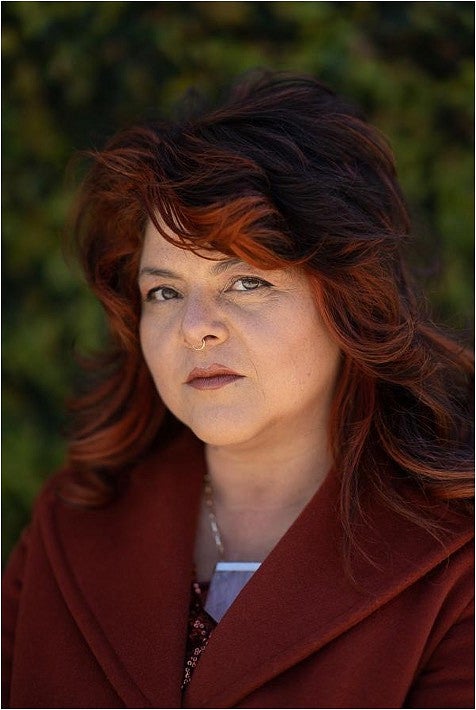
Sandy Rodriguez.
Alfredo Jaar
“Teach Us to Outgrow Our Madness”
February 21
Alfredo Jaar will present recent works realized around the world. Jaar is an artist, architect, and filmmaker based in New York. His work has been shown extensively around the world. Over seventy-five monographic publications have been published about his work. A Guggenheim and MacArthur Fellow, he received the Hiroshima Art Prize in 2018 and the Hasselblad Award in 2020.
This lecture is part of the “Policing Justice Lecture Series” co-presented by the Department of Art and the Department of the History of Art and Architecture and co-sponsored in part by the Oregon Humanities Center Endowment for Public Outreach in the Arts, Sciences, and Humanities Fund in Art History, The Mark Sponenburgh Endowment, the Davis Family Art Endowment, and the Department of Art.
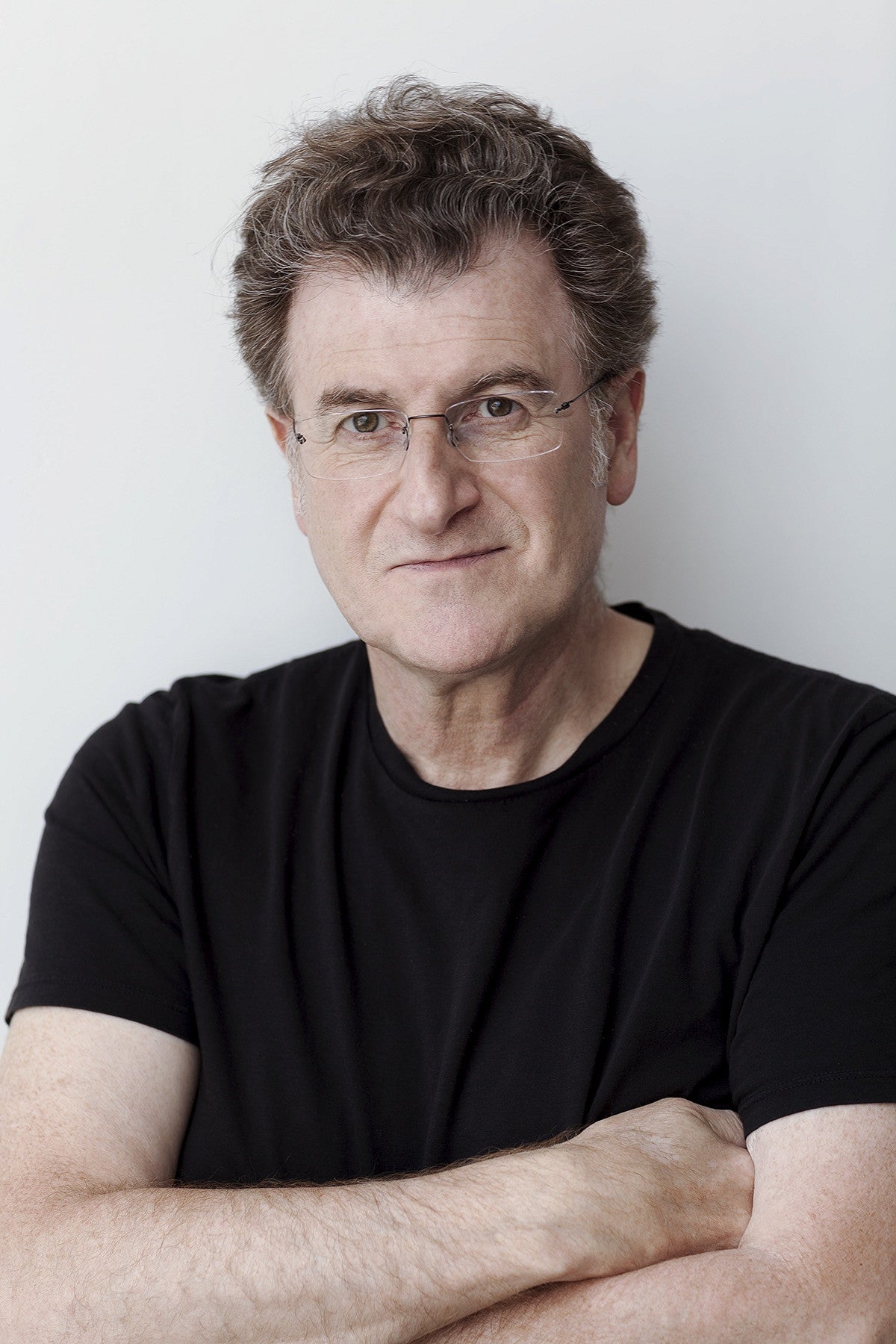
Alfredo Jaar.
Jesse Harrod
“Artist Talk”
February 22
Watch a video of the Jesse Harrod lecture on YouTube.
Jesse Harrod is an artist whose practice explores embodiment, gender, and sexual identity. Working with multiple media forms and materials, Harrod's work builds on herstories of 1970s feminist art to offer queer imaginations of the body, from the abject and the grotesque to the humorous. Her practice most centrally contributes to a broader collective effort to redefine the meaning of queer aesthetic form. Harrod’s work has been exhibited in numerous exhibitions throughout the United States and internationally. Harrod is represented by Fleisher Ollman Gallery in Philadelphia.

Jesse Harrod.
Robert Trafford
“Forensic Architecture: Art and Activism Against State Violence”
February 26
Watch a video of the Robert Trafford lecture on YouTube.
Since 2011, the Forensic Architecture (FA) research agency has investigated state violence and human rights violations around the world, contributing to a new understanding of the possibility for investigative practices in civil society, merging aesthetic sensibilities, investigative reporting, activism, and innovative digital technologies towards a unique approach to challenging crimes and cover-ups by states, militaries, and police. Following the group’s contribution to a newly-opened exhibition at the Portland Institute of Contemporary Arts (PICA) in Portland in February, Robert Trafford will begin from the investigations presented in that show – addressing violence by police and right-wing extremists in the context of racial justice protests in the city – to discuss how the agency’s work from the courtroom to the gallery, the strengths and challenges of their ‘counter-forensic’ method, and its place within contemporary social, technological, and political conditions.
Robert Trafford is a journalist by training, and an assistant director with Forensic Architecture, a human rights research agency based at Goldsmiths, University of London, with whom he has worked since 2017. There, he leads investigative research projects, writes and edits for exhibitions and publications, and supports other team members to bring investigations to publication, and to think about how their research can be activated across a range of forums in pursuit of accountability. His work with Forensic Architecture has covered the extrajudicial killing of civilians by Cameroon’s special forces, chemical weapons attacks by the Assad regime, and counter-protest violence by US police. He has jointly led investigations into the 2020 right-wing terror attack in Hanau, Germany, the 2011 killing of Mark Duggan by London’s police, and the agency’s acclaimed TRIPLE-CHASER investigation, which premiered at the 2019 Whitney Biennial in New York.
This lecture is part of the “Policing Justice Lecture Series” co-presented by the Department of Art and the Department of the History of Art and Architecture and co-sponsored in part by the Oregon Humanities Center Endowment for Public Outreach in the Arts, Sciences, and Humanities, and The Mark Sponenburgh Endowment.
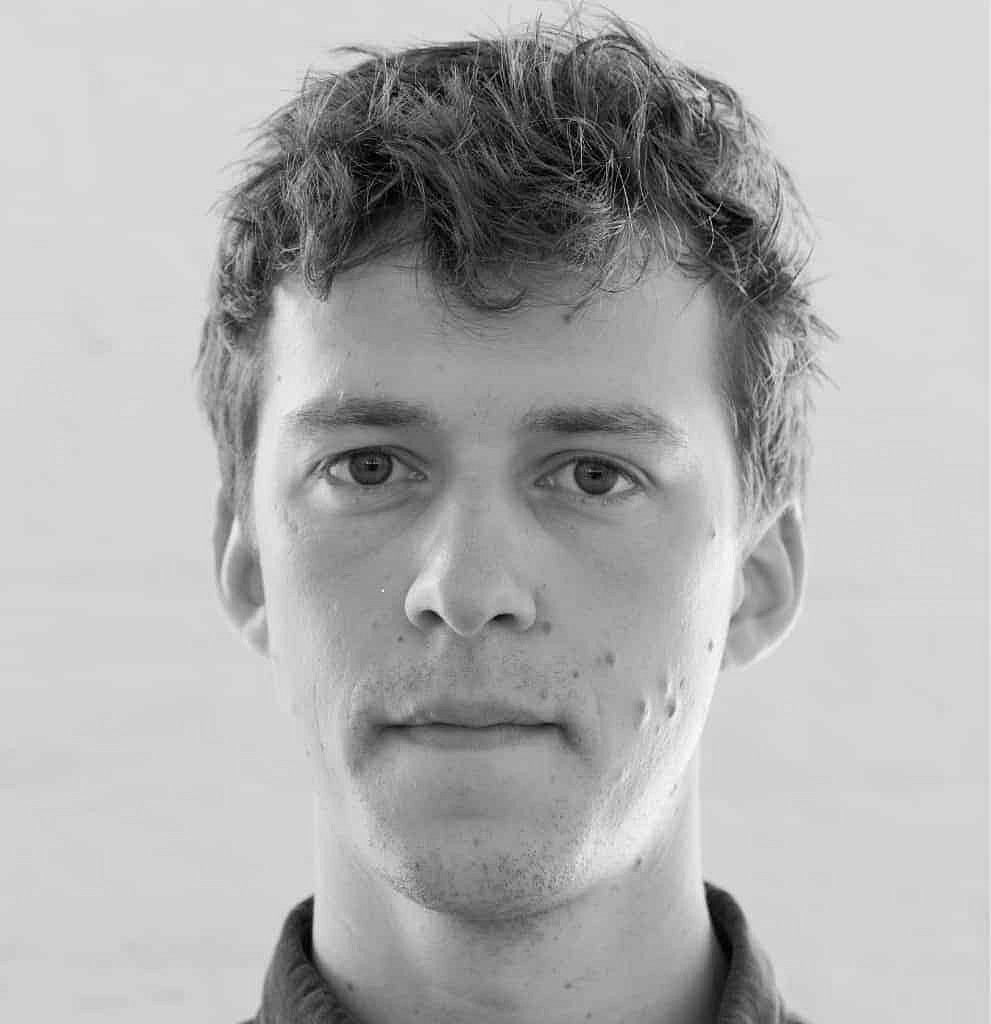
Robert Trafford.
Julian Watts
“Exploring the Intersection of Art, Craft, and Design Through Contemporary Woodcarving”
March 7
Watch a video of the Julian Watts lecture on YouTube.
Julian Watts combines traditional woodcarving techniques with an experimental sculptural approach to explore the formal and conceptual intersections between the human body, the landscape, and the functional objects that we interact with every day. This approach has continued to evolve, expanding to incorporate an entire ecosystem of abstract, biomorphic wood and bronze works, ranging from bowls, to furniture, to largescale, purely sculptural pieces. Watts’ organic, open-ended approach to woodcarving embraces a space of playful ambiguity, where the viewer is free to find poetic and unexpected associations between the body, the landscape, and the overlooked objects that we live with, revealing new and unexpected ways of seeing the world around us.
After earning a BFA in sculpture at the University of Oregon in 2012, Watts returned to his hometown of San Francisco to apprentice under furniture makers before beginning his own practice. His work has been shown internationally including solo exhibitions at Sarah Myerscough Gallery in London, Patrick Parrish Gallery in New York, Curators Cube in Tokyo, and Jack Fischer Gallery in San Francisco. He has participated in numerous art and design fairs, including Design Miami/Basel, Fog Fair, and Salon NY. His work has been featured in The Wall Street Journal, Architectural Digest, The New Yorker, and American Craft Magazine, among others. He was shortlisted for the Loewe Craft Prize in 2018. Watts has taught courses at Haystack Mountain School of Crafts, Anderson Ranch, and was the 2018 Wornick Distinguished Visiting Professor of Wood Arts at the California College of the Arts. He’s based in Alpine, OR.
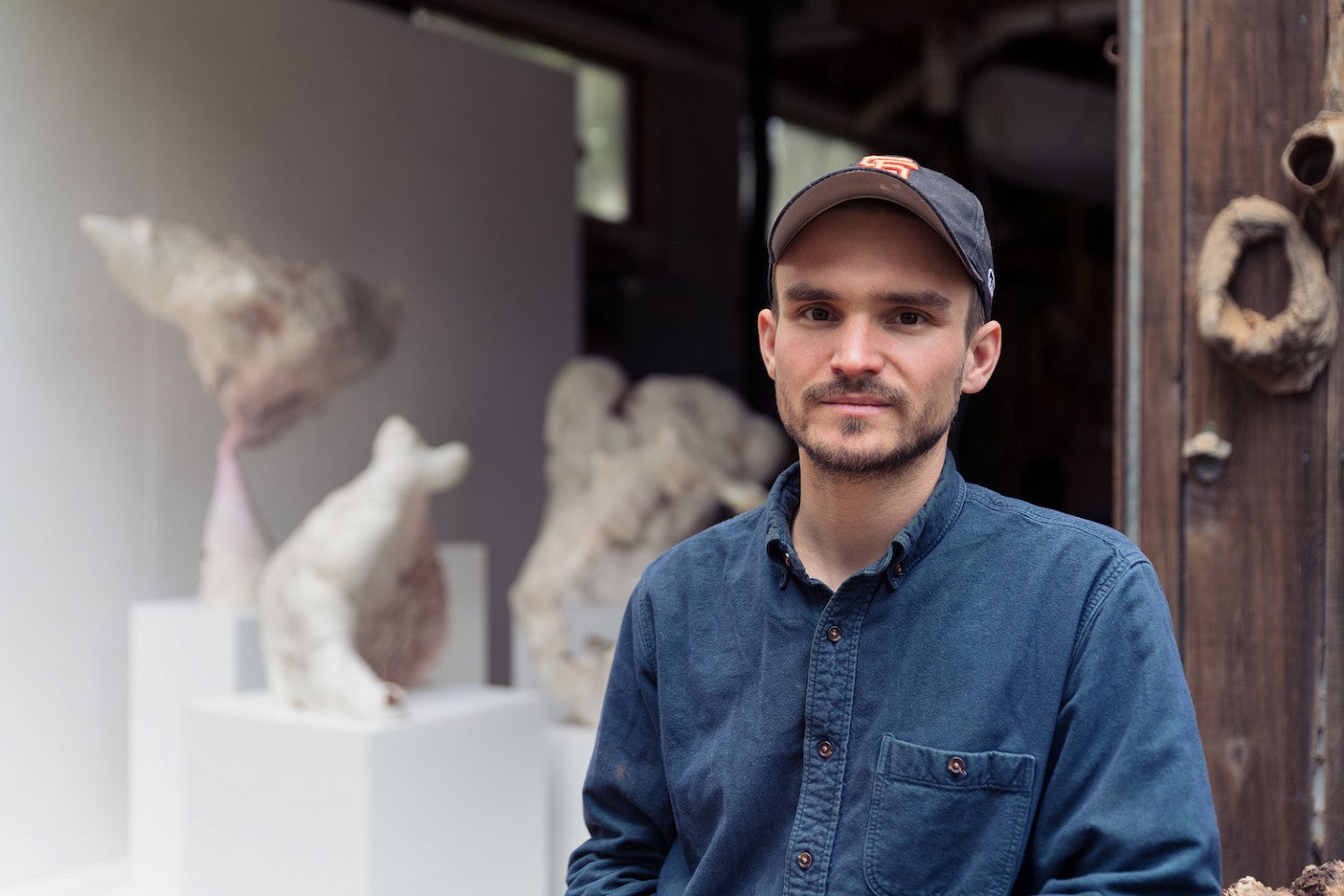
Julian Watts.
B.Wurtz
“Art Works”
April 4
Watch a video of the B.Wurtz lecture on YouTube.
B. Wurtz’s repurposing of everyday flotsam into joyous, humorous, and beautiful objects undermine grand artistic gesture while elevating the commonplace. The artist’s transformative amalgams of found materials have tended to coalesce around the subjects of “sleeping, eating, and keeping warm”—the foundational human needs named in his 1973 drawing Three Important Things. While his sculptures are often modest in scale, in 2018, the artist created his now iconic Kitchen Trees for the New York City Public Art Fund, transforming City Hall Park with towering columns of colorful colanders exploding with plastic fruit.
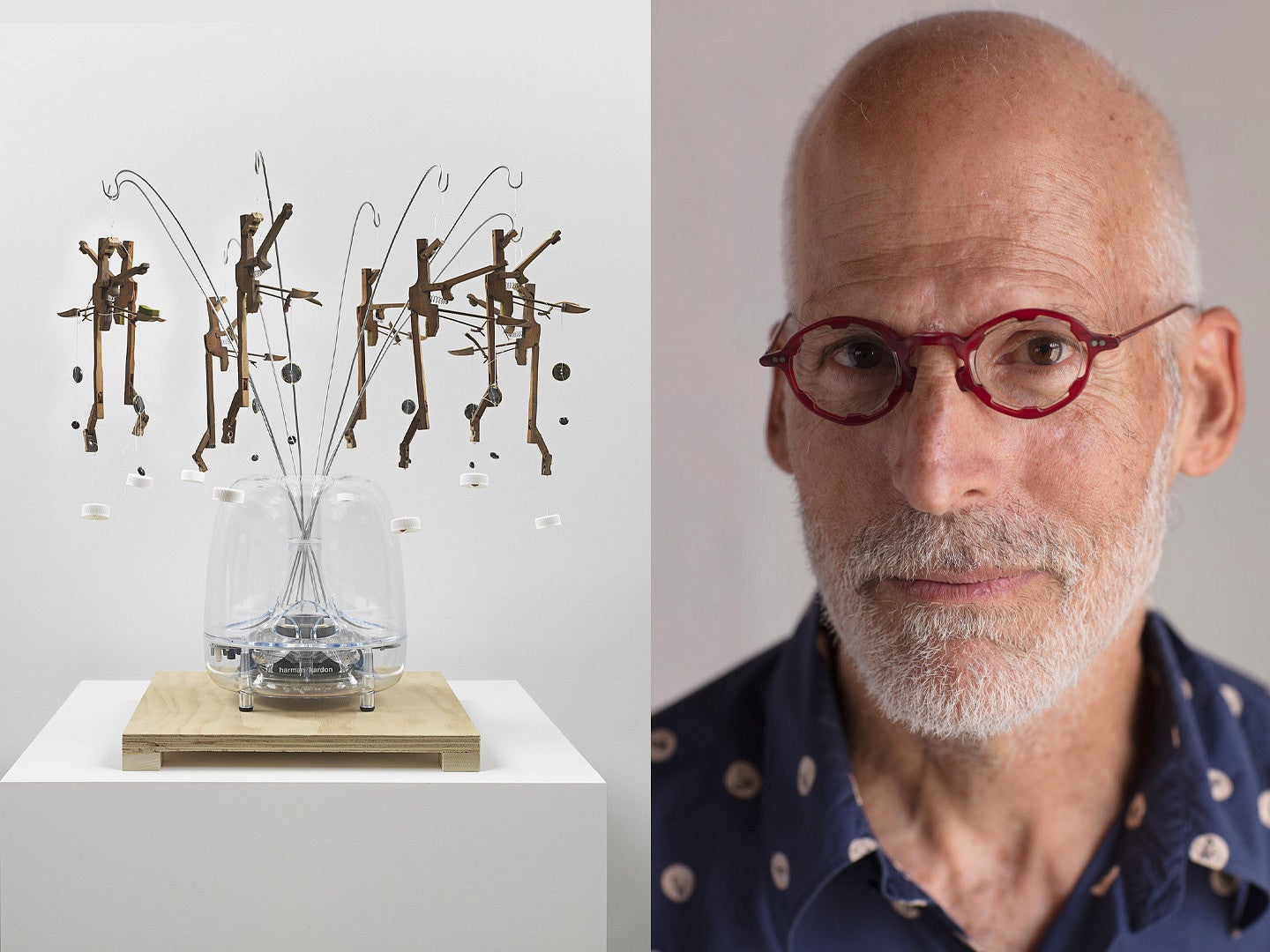
Above left: Octave, 2018, piano parts, speaker, metal, bottle caps, wood, show buttons, buttons, 25 x 24 inches // Above right: B.Wurtz
Kahlil Robert Irving
“Artist Talk”
April 11
Kahlil Robert Irving will present a lecture recounting experiences and details around his broad practice. A major focus will be several of his recent institutional exhibitions including Projects: Kahlil Robert Irving at the Museum of Modern Art, Archeology of the Present at the Walker Art Center + Kemper Art Museum in Saint Louis, and AnticKS + MOdels: My Theater for your Eyes at the Nerman Museum of Contemporary Art.
Soon, Irving will present Kahlil Robert Irving: Archeology of the Present at the Kemper Art Museum at Washington University in St. Louis. Concurrently, he will present a major 6000-square-foot solo exhibition at the Nerman Museum of Contemporary Art. Both will be on view until July 2024. Recently, Irving presented a commission as part of “I’ll Be Your Mirror: Art and the Digital Screen” at The Modern Art Museum of Fort Worth curated by Alison Hearst. Recently, Irving presented Projects: Kahlil Robert Irving at the Museum of Modern Art (NY) a part of the Studio Museum in Harlem partnership from December 2021 to May 2022. Irving has been awarded the Louis Comfort Tiffany Foundation Grant (2019) and the Joan Mitchell Foundation Grant (2020). In 2018, Irving’s first large-scale exhibition took place at Wesleyan University’s Center for the Arts, Connecticut, and was accompanied by a full-color catalogue with essays and an interview. Currently, he is presenting a semi-permanent large-scale commission in the lobby at the Contemporary Art Center, Cincinnati, Ohio.
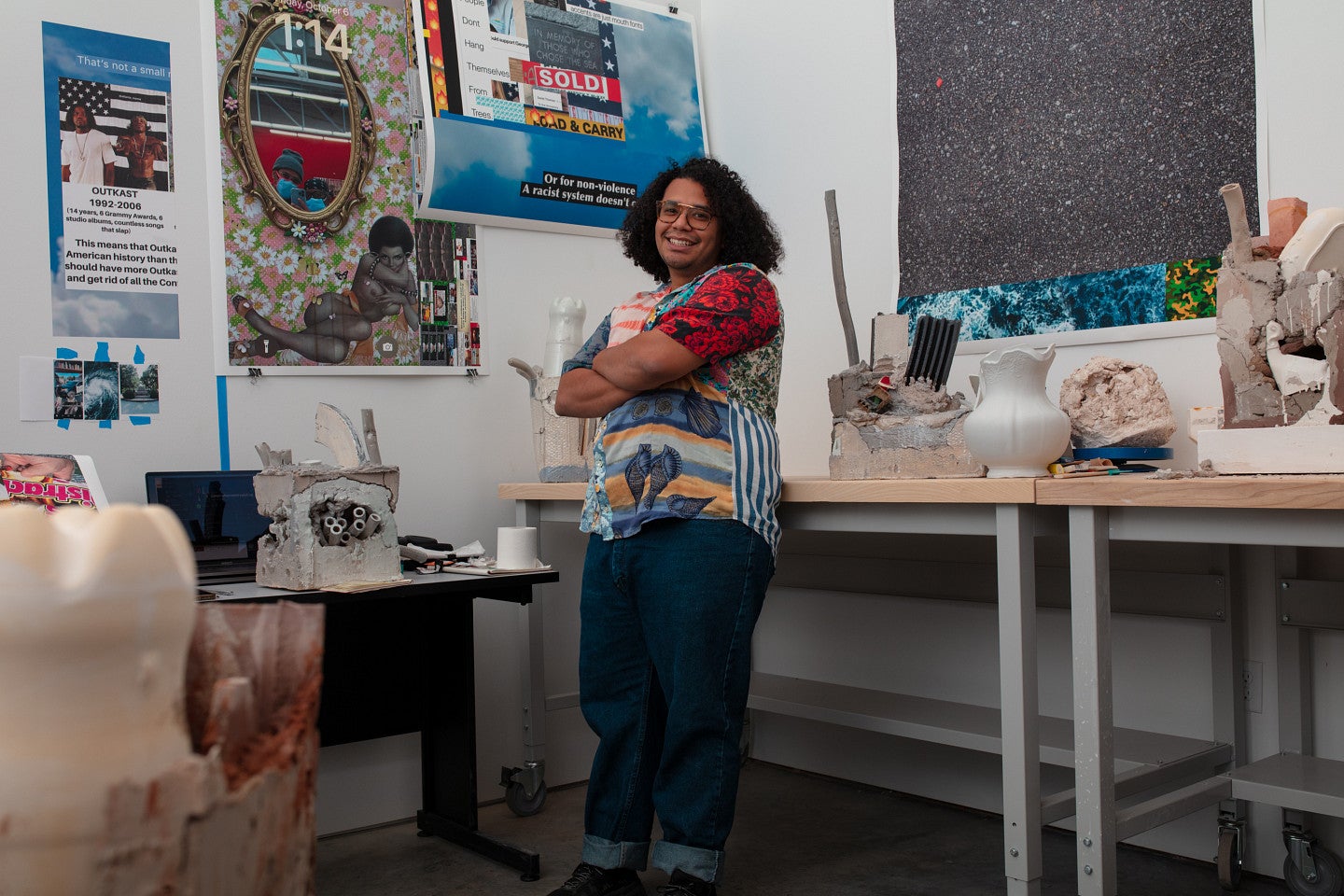
Kahlil Robert Irving.
Tallmadge Doyle
“As Above”
April 18
Watch a video of the Tallmadge Doyle lecture on YouTube.
Tallmadge Doyle is an artist whose current Printmaking and Painting practice integrates intricate ecosystems of microscopic Ocean life forms with the expansive telescopic view of our solar system. These natural realms, dissimilar in scope yet, at times indistinguishable in form, overlap and intertwine. The resulting images serve as playgrounds for new visual realities where color is ethereal, vivid and brilliant, where light is unpredictable and form vibrates, allowing access into the abundance and immensity of what is often unseen.
Doyle grew up in New York and attended The Cleveland Art Institute for undergraduate studies. In 1990 she came to Oregon to attend the MFA program at the University of Oregon focusing on Printmaking and Painting. Doyle’s work has been exhibited in numerous exhibitions throughout the United States and internationally. She is represented by the Seattle Art Museum Gallery and Davidson Gallery in Seattle, Augen Gallery in Portland, and the Karin Clarke Gallery in Eugene. She is a member of the Los Angeles Printmaking Society, the Boston Printmakers and Seattle Print Arts as well as the Southern Graphics Council International.
This lecture is made possible by the Laverne Krause Lectures and Exhibitions endowment.
http://www.tallmadgedoyle.com

Tallmadge Doyle.
Angela Hennessy
“title TBC”
May 2
Angela Hennessy is an Oakland-based artist and survivor of gun violence. Through writing, studio work, and ritual performance, her practice questions assumptions about Death and the Dead themselves. Hennessy constructs sculptures and installations with everyday domestic labor—washing, wrapping, stitching, knotting, brushing, and braiding.
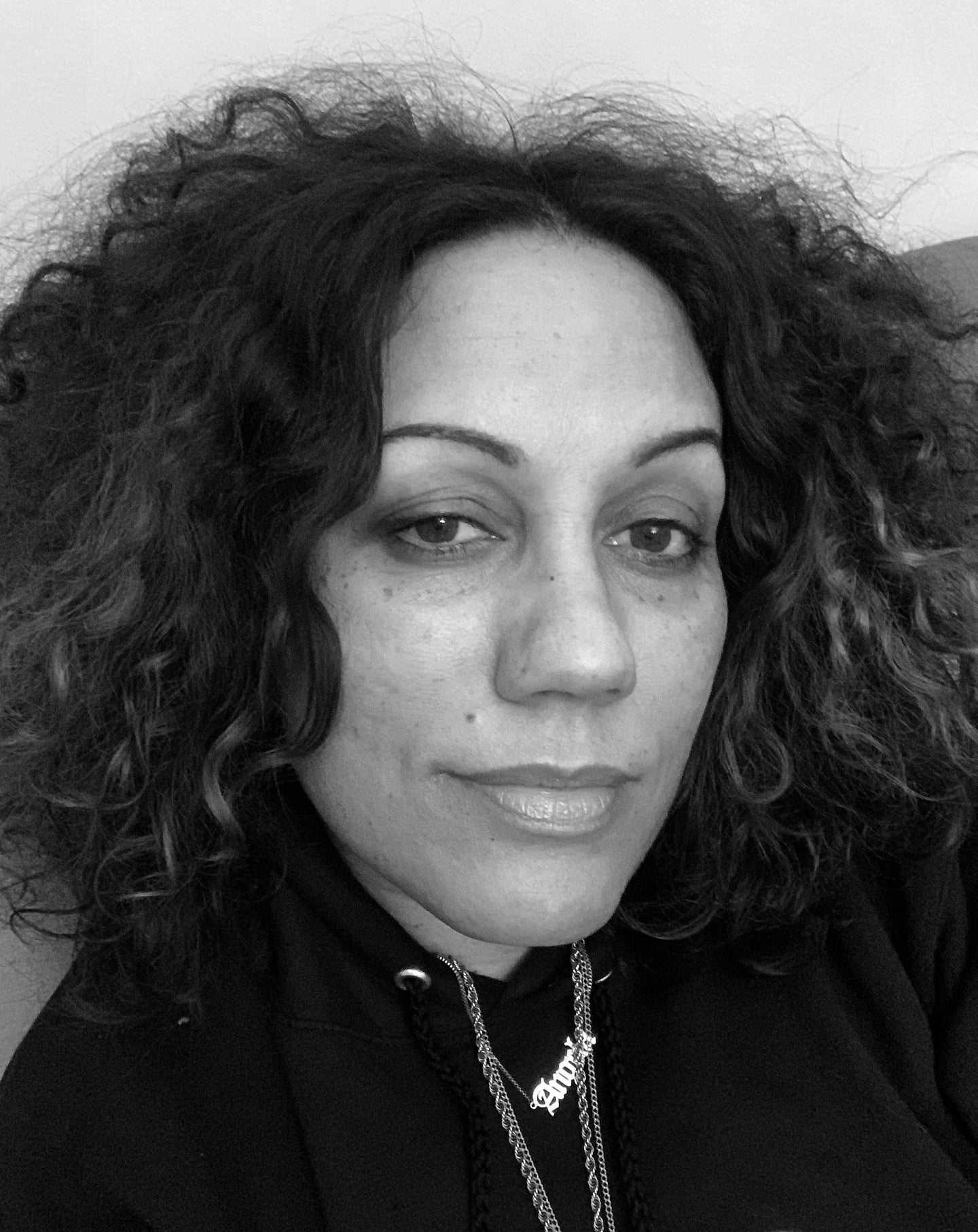
Angela Hennessy.
Dionne Lee
“Art Talk”
May 9
Dionne Lee is a visual artist working in photography, collage, and video. Her work explores power and personal history in relation to the American landscape, and interrogates historical narratives that exist within photographic representations of land and place.
Lee received her MFA from California College of the Arts. She has exhibited at the Museum of Modern Art, New York; Feria Material, Mexico City; Barbican Art Gallery, London; New Orleans Museum of Art; Aperture Foundation, New York; Silver Eye Center for Photography, Pittsburgh; Museum of Fine Arts Houston; and the San Francisco Arts Commission, among others. Lee was a 2022 Artist-in-Residence at the Chinati Foundation and a 2021–2023 Artist-in-Residence with Unseen California.
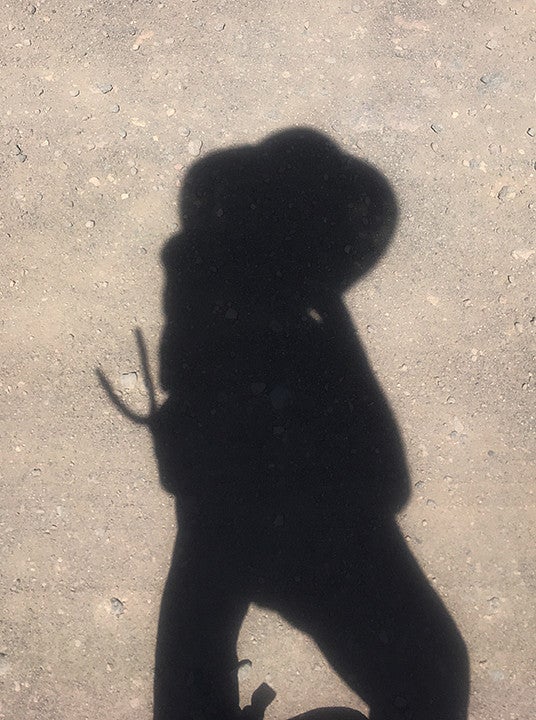
Dionne Lee.
2022–23 Visiting Artist Lecture Series
Winter 2022
January 19
February 23
March 2
March 9
Natasha Ginwala
“Between Waves and Sea Change”
October 11
Watch a video of the Natasha Ginwala lecture on YouTube.
Natasha Ginwala is Associate Curator at Large at Gropius Bau, Berlin; Artistic Director of Colomboscope in Sri Lanka and the 13th Gwangju Biennale with Defne Ayas (2021). Ginwala has curated Contour Biennale 8, Polyphonic Worlds: Justice as Medium and was part of the curatorial team of documenta 14, 2017. Other projects include Indigo Waves and Other Stories: Re-navigating the Afrasian Sea and Notions of Diaspora (with Bonaventure Soh Bejeng Ndikung and Michelangelo Corsaro) at Zeitz MOCAA; Survey exhibitions of Bani Abidi, Akinbode Akinbiyi and Zanele Muholi at Gropius Bau. Ginwala was a member of the artistic team for the 8th Berlin Biennale for Contemporary Art, 2014, and has co-curated The Museum of Rhythm, at Taipei Biennial 2012 and at Muzeum Sztuki, Lodz, 2016–17. Ginwala writes regularly on contemporary art and visual culture. Recent co-edited volumes include Stronger than Bone (Archive Books and Gwangju Biennale Foundation) and Nights of the Dispossessed: Riots Unbound (Columbia University Press).
In this practice-led presentation, oceanic affinities and crossings recur across exhibition sites andartistic voices leading into diasporic anchorages, poethical currents and saltwater histories that affirm asynchronous mappings of place, belonging, and subjecthood. Natasha Ginwala will address the ongoing multi-part project Indigo Waves & Other Stories: Re-navigating the Afrasian Sea and Notions of Diaspora (conceived with Bonaventure Soh Bejeng Ndikung and Michelangelo Corsaro); Sea Change – the sixth edition of interdisciplinary arts festival Colomboscope in Sri Lanka; and the photographic oeuvre of Akinbode Akinbiyi traversing coast to coast in the form of an epic series titled Sea Never Dry. This encounter will conclude with a DJ session with Hiba Ali, building off of their Indian Ocean Mixes series, they have previously conducted the Black Indian Ocean Series, a reading group and film series that visualizes the histories and futures of African-descent communities in the Indian Ocean region through curated film screenings and generative pedagogy.
This lecture is made possible by the Critical Conversations program, a partnership between the Ford Family Foundation and the University of Oregon Department of Art's Center for Art Research with Reed College’s Douglas F. Cooley Memorial Art Gallery, Pacific Northwest College of Art, and Portland State University.
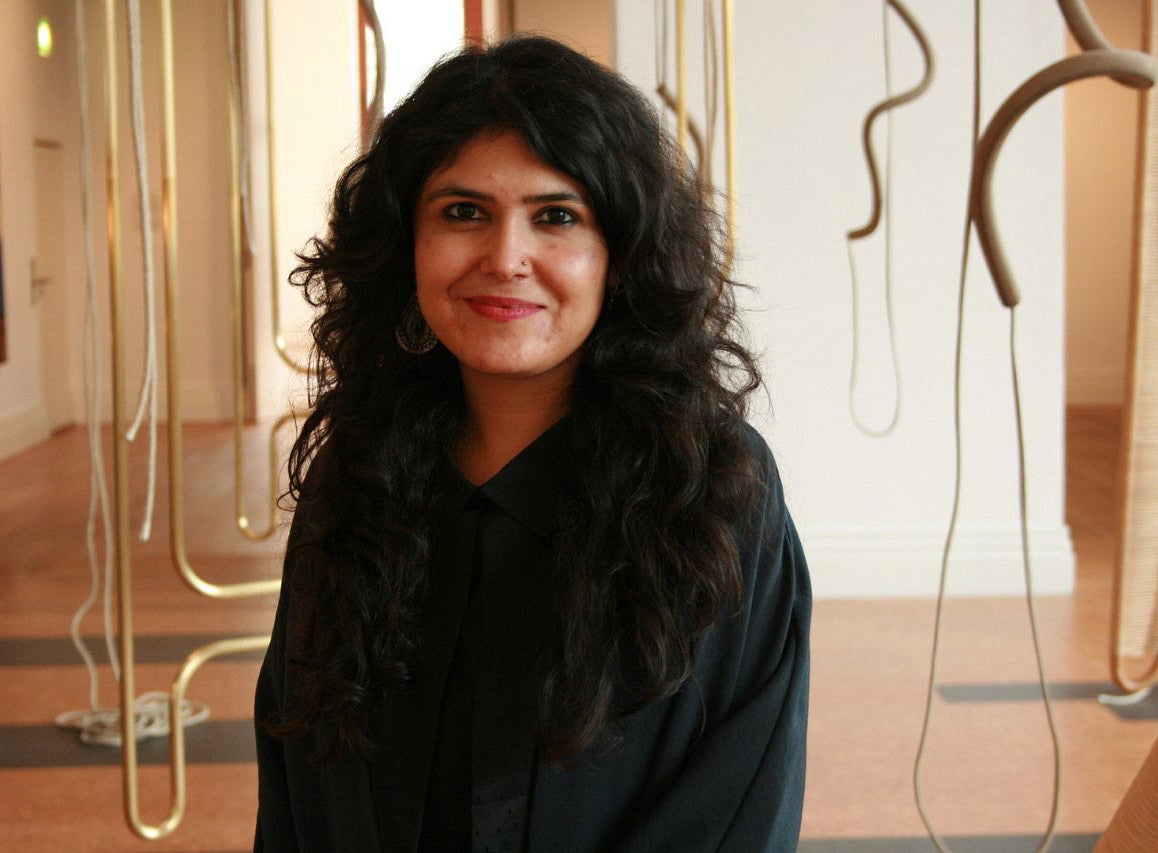
Natasha Ginwala.
Carmen Winant
“Notes on Fundamental Joy”
October 13
Carmen Winant’s lecture will animate the ongoing work that she has done in the Oregon Lesbian Land Manuscript Collections in Special Collections since 2018. This research has resulted in a book, Notes on Fundamental Joy (Printed Matter Inc., 2019), a series of experimental videos, and a forthcoming exhibition at the Wexner Center of the Arts in Columbus, OH. In sharing her work that has been informed by this substantial and singular archive, Winant will prompt the underlying questions of her practice- What is the fundamental work of world-building? How might we continue to reconfigure the feminist imaginary? What does a world without patriarchy look like? In what ways is optimism a political tool? How might we better understand the relationship between collectivity, survival, and joy? In what ways does photography have the power to continually re-inscribe desire?
Carmen Winant is an artist and the Roy Lichtenstein Chair of Studio Art at the Ohio State University; her work utilizes installation and collage strategies to examine feminist modes of survival and revolt. Winant's recent projects have been shown at the Museum of Modern Art, Sculpture Center, Wexner Center of the Arts, the Cleveland Museum of Art, The Museo Universitario Arte Contemporáneo, and as part of the CONTACT Photography Festival, which mounted twenty-six of her billboards across Canada. Forthcoming projects will take place at The Print Center (Philadelphia), ICA Boston, and Minneapolis Institute of Art. Winant's recent artist’s books include My Birth (2018), Notes on Fundamental Joy (2019), and Instructional Photography: Learning How To Live Now (2021); she is a 2019 Guggenheim Fellow in photography, a 2020 FCA Artist Honoree and a 2021 American Academy of Arts and Letters award recipient. Winant is a mother to her two sons, Carlo and Rafa, whom she shares with her partner Luke Stettner.
This lecture is co-sponsored by UO Libraries.
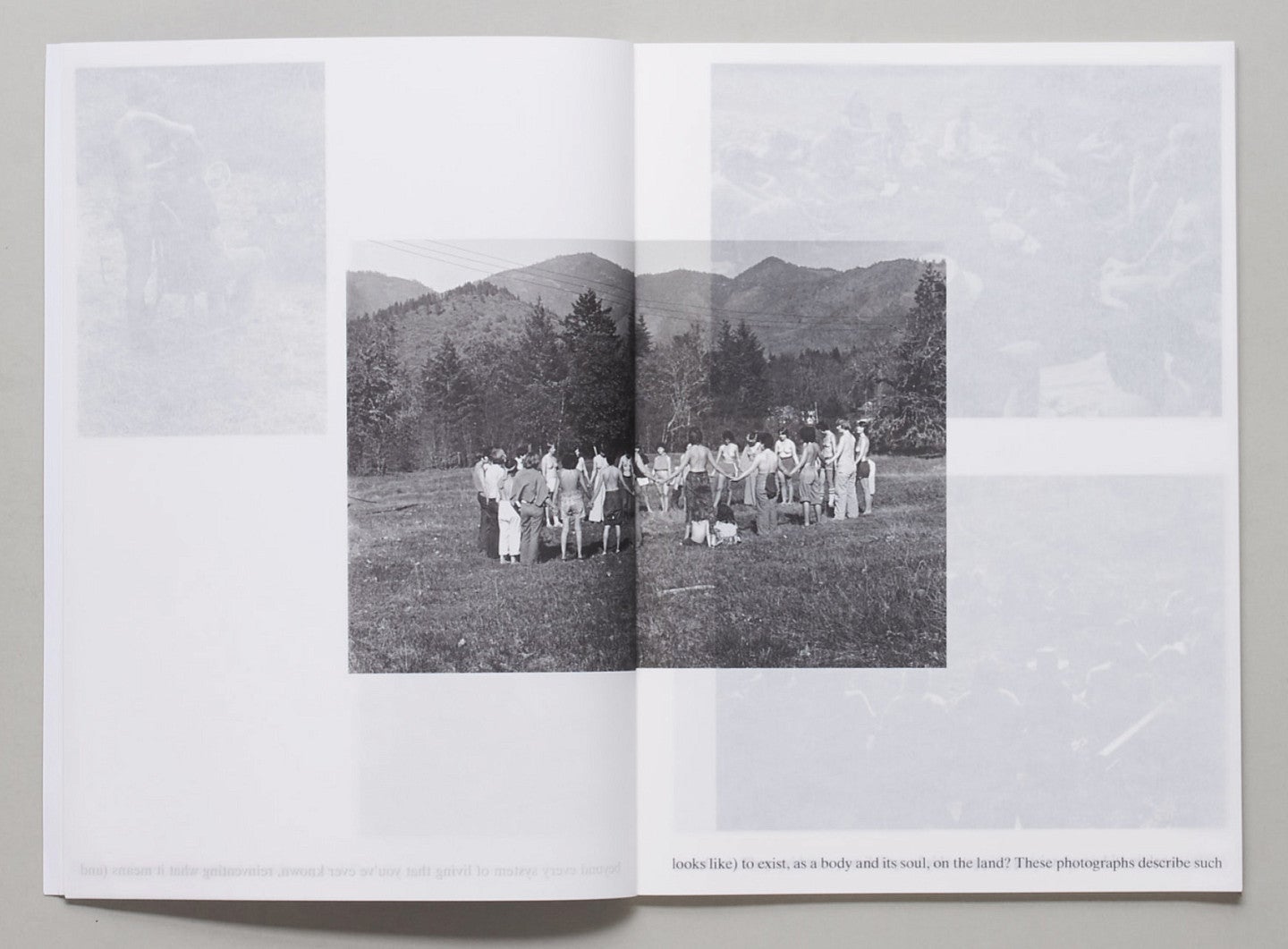
Notes on Fundamental Joy: seeking the elimination of oppression through the social and political transformation of the patriarchy that otherwise threatens to bury us, Printed Matter, Inc. 2019, courtesy of the artist.
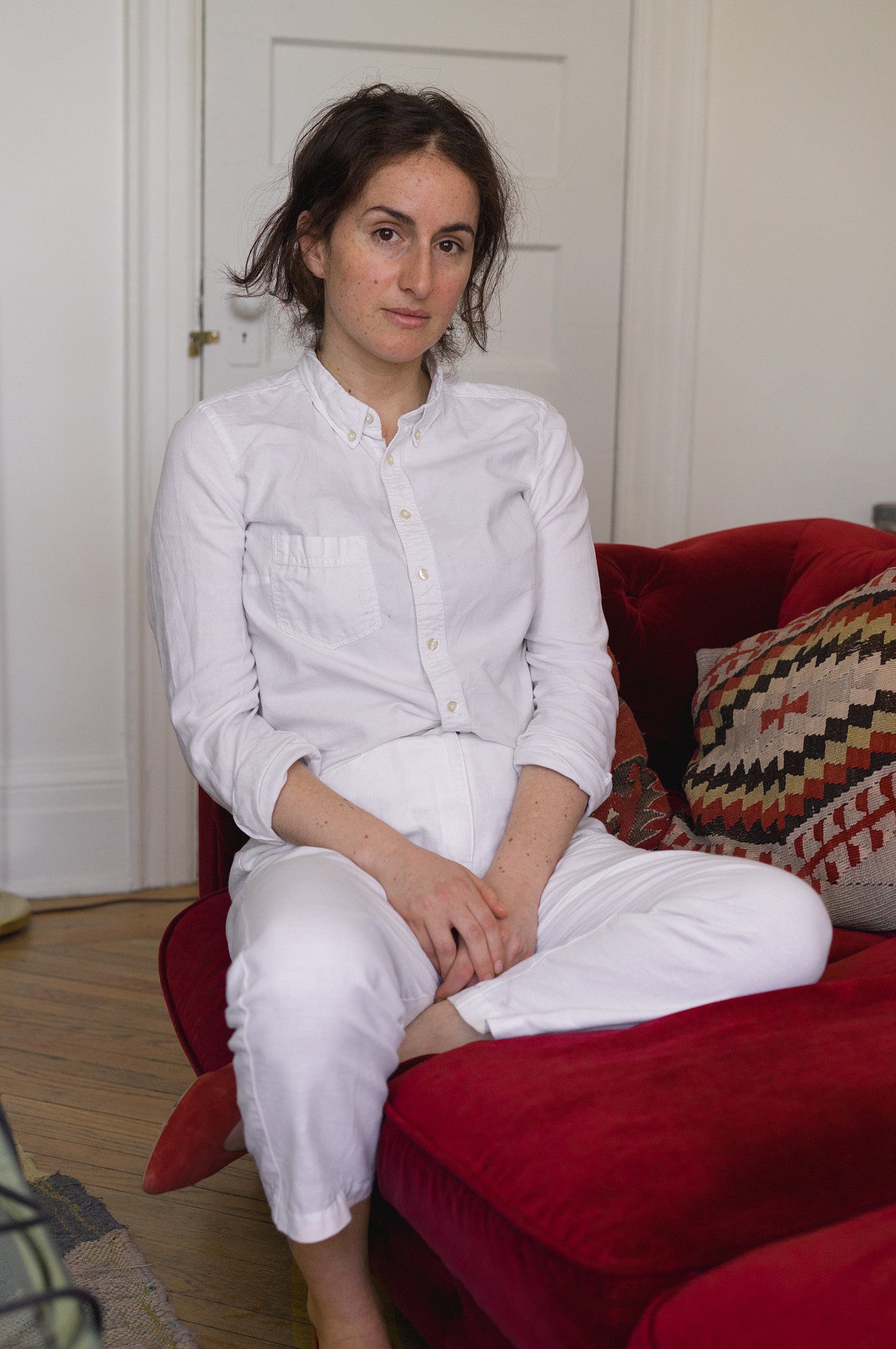
Carmen Winant. Photo credit: Jordan Weitzman.
Jen Stark
"A Psychedelic Dive into Art, Fractals, and NFTs”
October 20
Watch a video of the Jen Stark lecture on YouTube.
Jen Stark’s art is driven by her interest in conceptualizing visual systems to simulate plant growth, evolution, infinity, fractals, mimetic topographies, and sacred geometries. Using available materials—paper, wood, metal, paint—Stark strives to make work that balances on a razor’s edge of optical seduction and perceptual engagement. The resulting works are imbued with kinetic, undulating effects that serve to dislocate the viewer from staid reality into an immersive ecosphere of echoing patterns and designs found in nature. In recent years, Stark has introduced new technologies into her diverse practice, delving into the digital realm of animations, interactive projections, and distinctive NFTs. By adopting cutting-edge techniques to showcase her aesthetic, Stark activates her universe through constant adaptation and transformation.
Born and raised in Miami, Florida in 1983, Jen Stark now lives and works in Los Angeles. She has been exhibited globally, with major shows in New York, Los Angeles, Miami, Chicago, Thailand, and Canada. Recently included as one of Fortune’s “NFTy 50,” Stark made history in March 2021, as the first female artist to make Foundation’s top 10 highest-selling NFT creatives. Her work is held in the collections of institutions such as the Smithsonian American Art Museum, the West Collection, Crystal Bridges Museum of American Art, NSU Art Museum, and MOCA Miami, among others.

Above: 4 x 4 x 4, 2021, powder-coated aluminum, chrome-plated aluminum spacers, aluminum threaded rods, stainless steel, magnets, 48 x 48 x 48 in. Headshot: Photo Credit: Ira Chernova, 2021.

Jen Stark. Photo Credit: Ira Chernova, 2021.
Liz Magor
"I Have Wasted My Life”
October 27
Watch a video of the Liz Magor lecture on YouTube.
Liz Magor will talk about her recent studio work, how to entertain contradiction, and how to be untopical yet relevant. Magor is a Vancouver-based artist who produces sculptural and photographic works concerned with the latent, affective range of familiar materials, images, and objects. Her process and studio practice were featured in Season 8 of the PBS series Art 21, "Art in the Twenty-first Century" and her work has been exhibited in major international exhibitions such as Documenta VIII, Kassel; the 41st Venice Biennale, and the 4th Biennale of Sydney. In 2019 Magor presented an exhibition titled BLOWOUT at the Carpenter Center for Visual Art, Cambridge, Mass. The exhibition travelled to the Renaissance Society in Chicago accompanied by a publication. Recent exhibitions include "Downer" at Catriona Jeffries Gallery, Vancouver and "I Have Wasted My Life" at Andrew Kreps Gallery, New York, NY.
This lecture is made possible by the George and Matilda Fowler Endowment Fund.
catrionajeffries.com/artists/liz-magor/works/
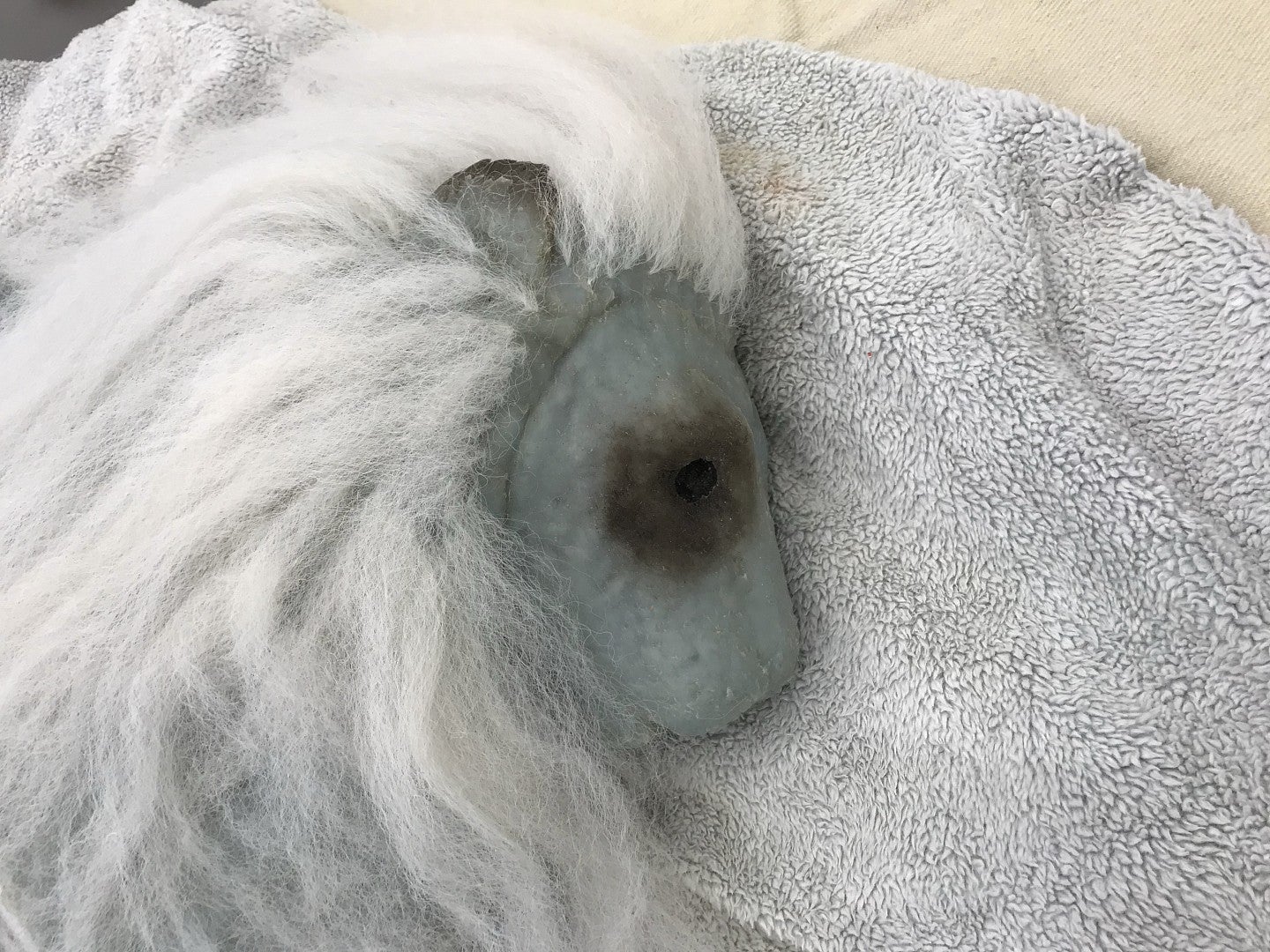
Liz Magor, Coiffed (detail), 2020, painted plywood, fabric skirting, silicone rubber, artificial hair, acrylic throw, woolen blankets, silver fabric, linen, jewelry boxes, costume jewelry, packaging materials, 27 x 132 x 96 inches, courtesy of the artist and Catriona Jeffries.

Liz Magor.
Marie Watt
“Calling Companion Species”
November 10
Watch a video of the Marie Watt lecture on YouTube.
Marie Watt is an American artist and citizen of the Seneca Nation with German-Scot ancestry. Her interdisciplinary work draws from history, biography, Iroquois protofeminism, and Indigenous teachings; in it, she explores the intersection of history, community, and storytelling. Through collaborative actions she instigates multigenerational and cross- disciplinary conversations that might create a lens and conversation for understanding connectedness to place, one another, and the universe.
Watt holds an MFA in painting and printmaking from Yale University; she also has degrees from Willamette University and the Institute of American Indian Arts; and in 2016 she was awarded an honorary doctorate from Willamette University. Marie serves on the executive board for VoCA (Voices in Contemporary Art) and on the Native Advisory Committee at the Portland Art Museum and in 2020 became a member of the Board of Trustees at the Portland Art Museum. She is represented by PDX Contemporary Art in Portland, Oregon, Catharine Clark Gallery in San Francisco, California, and Marc Straus Gallery in New York City, New York.
This lecture is co-sponsored by the Jordan Schnitzer Museum of Art in conjunction with the exhibit "Many Wests: Artists Shape an American Idea" on view through Dec. 18.

Transportation Object (Lamp), 2015, reclaimed wool blankets satin binding, embroidery floss, thread, 12.25 × 13.75 inches.
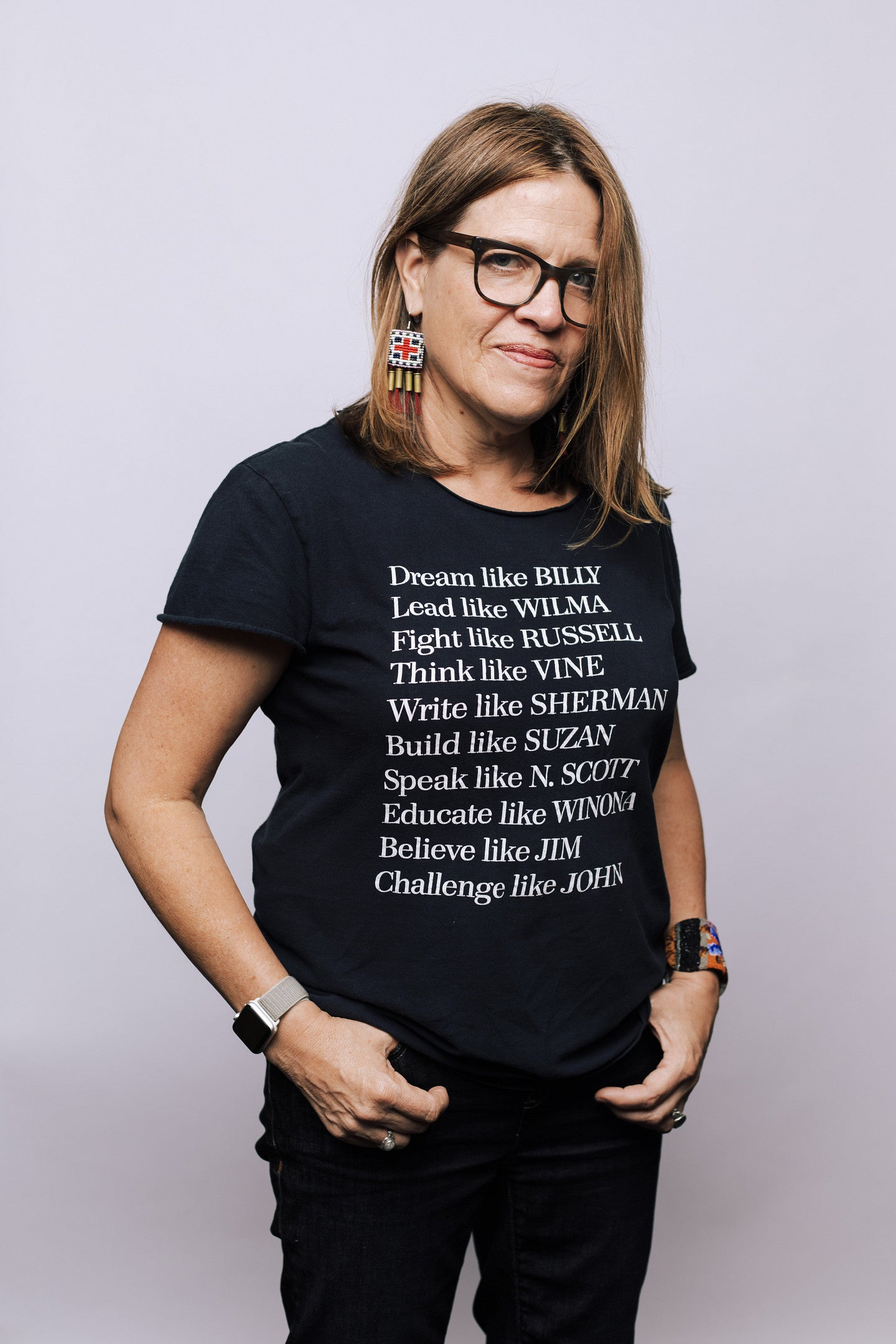
Marie Watt. Photo credit: Sam Gehrke.
Kate McNamara
“Staying with the Trouble”
November 17
Watch a video of the Kate McNamara lecture on YouTube.
This lecture will address contemporary strategies for survival, allyship, empathy, and love through the ideas and artists of two recent exhibitions, “Staying with the Trouble” and “OddKin”. In 2016, the eco-feminist Donna Haraway insisted that humans ‘stay with the trouble’ of learning to live well with nonhumans as kin, through practice-based approaches to learning to care for nonhuman others. Echoing the critical ethos found within indigenous knowledge, philosophical practices, and modern science, Haraway advises collaborative approaches to learning to live (and die) together on a damaged Earth. The term "oddkin" rewrites boundaries and stakes the claim that the shape of kinship isn't a birthright, but a choice. These critical ideas are emphasized in the work of artists like Paula Wilson whose large-scale prints bridge the natural and human worlds culling flora and fauna from her hometown of Carrizozo, NM; in MPA's staging and critique of Mars' colonization; Cauleen Smith's “BLK FMNNST Loaner Library, 1989–2019” - painted book covers by Black and queer radical literary theorists; and in Carmen Winant collaborations with Ovulars, a series of workshops held in various feminist and lesbian separatist communes in the early 80s.
Kate McNamara is a curator and educator based in Providence, RI. She currently holds the position of Executive and Creative Director of My HomeCourt, a nonprofit arts organization working with contemporary artists to revitalize city parks. McNamara is also a Curator at Providence College Galleries; administrator at Interlace Grant Fund; and is a Visiting Critic at Rhode Island School of Design and Sotheby’s Institute of Art. McNamara is invested in contemporary art and innovative curatorial practices and recently launched KMM Projects, an alternative art program in Providence.
This lecture is made possible by the Gilkey Foundation.

Staying with the Trouble with work by Judy Chicago, Young Joon Kwak, MPA, Lynn Hershman Leeson, Ellen Lesperance, Joiri Minaya, Cauleen Smith, Faith Wilding, Paula Wilson, and Carmen Winant with Carol Osmer Newhouse
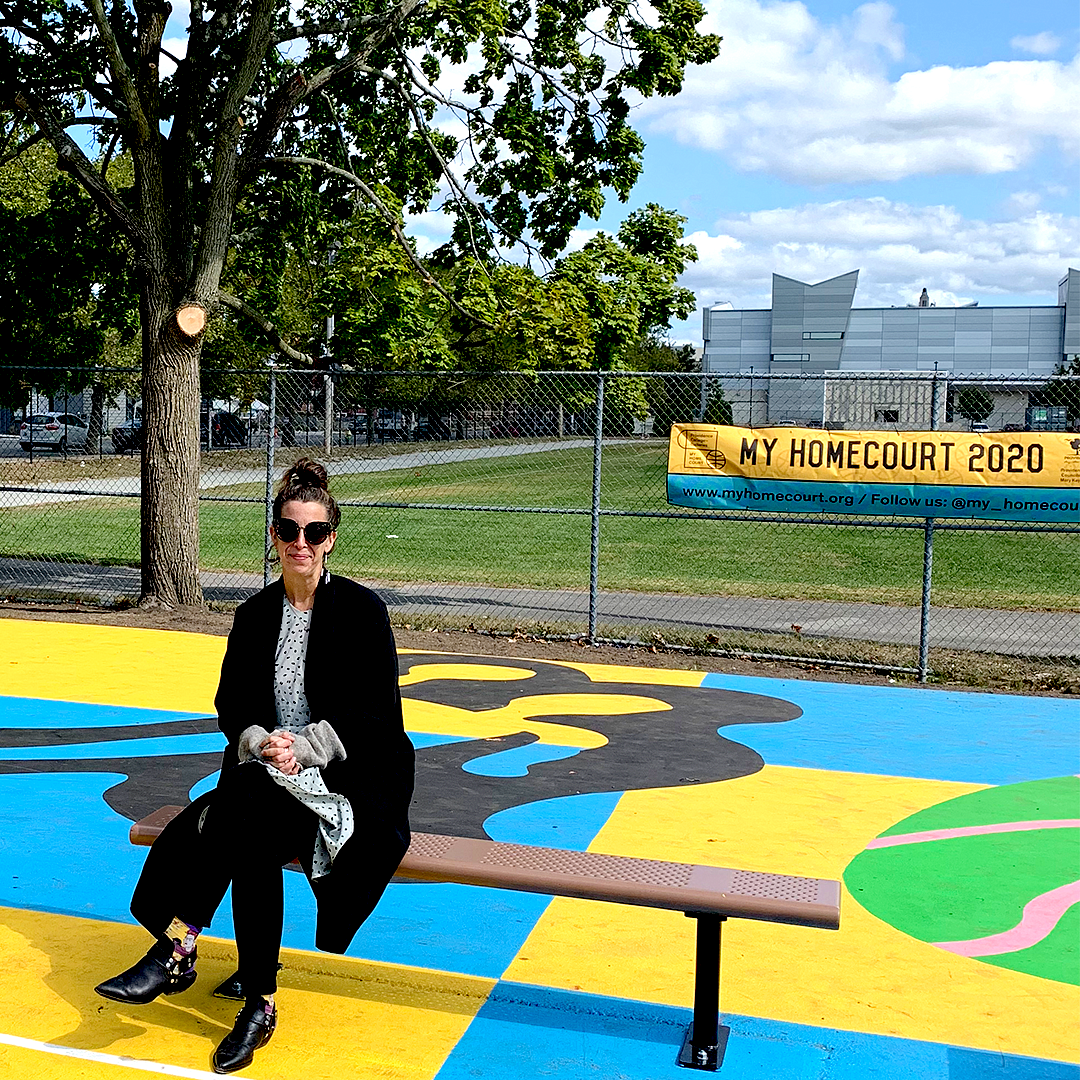
Kate McNamara.
Margaret Lee
“Untethering”
January 19
Watch a video of the Margaret Lee lecture on YouTube.
This lecture focused on Margaret Lee’s transition between representational sculpture to abstract painting over the past 10+ years. Rather than a strictly linear presentation, Lee will discuss building her practice so that material transitions are multi-directional, allowing backward and forward movements.
Margaret Lee has organized and exhibited work at numerous venues domestically and internationally including Misako & Rosen Gallery, Tokyo, Japan; The Artist Is Present, curated by Maurizio Catalan, Yuz Museum, Shanghai, China; The Windows, Barneys, New York; Concentrations HK: Margaret Lee, curated by Gabriel Ritter, Duddell’s x DMA, Hong Kong, China; Made in L.A, 2014 Hammer Museum Biennial, Los Angeles; 2013 Biennale de Lyon; de, da do...da, Carpenter Center for the Visual Arts, Harvard University, Cambridge, MA; Caza, curated by Sofía Hernández Chong Cuy, Bronx Museum, New York; NO MAN’S LAND: Women Artists from the Rubell Family Collection, Rubell Family Collection, Miami, New Pictures of Common Objects, curated by Christopher Lew, MoMA PS1, New York, and Looking Back, White Columns, New York, amongst others.
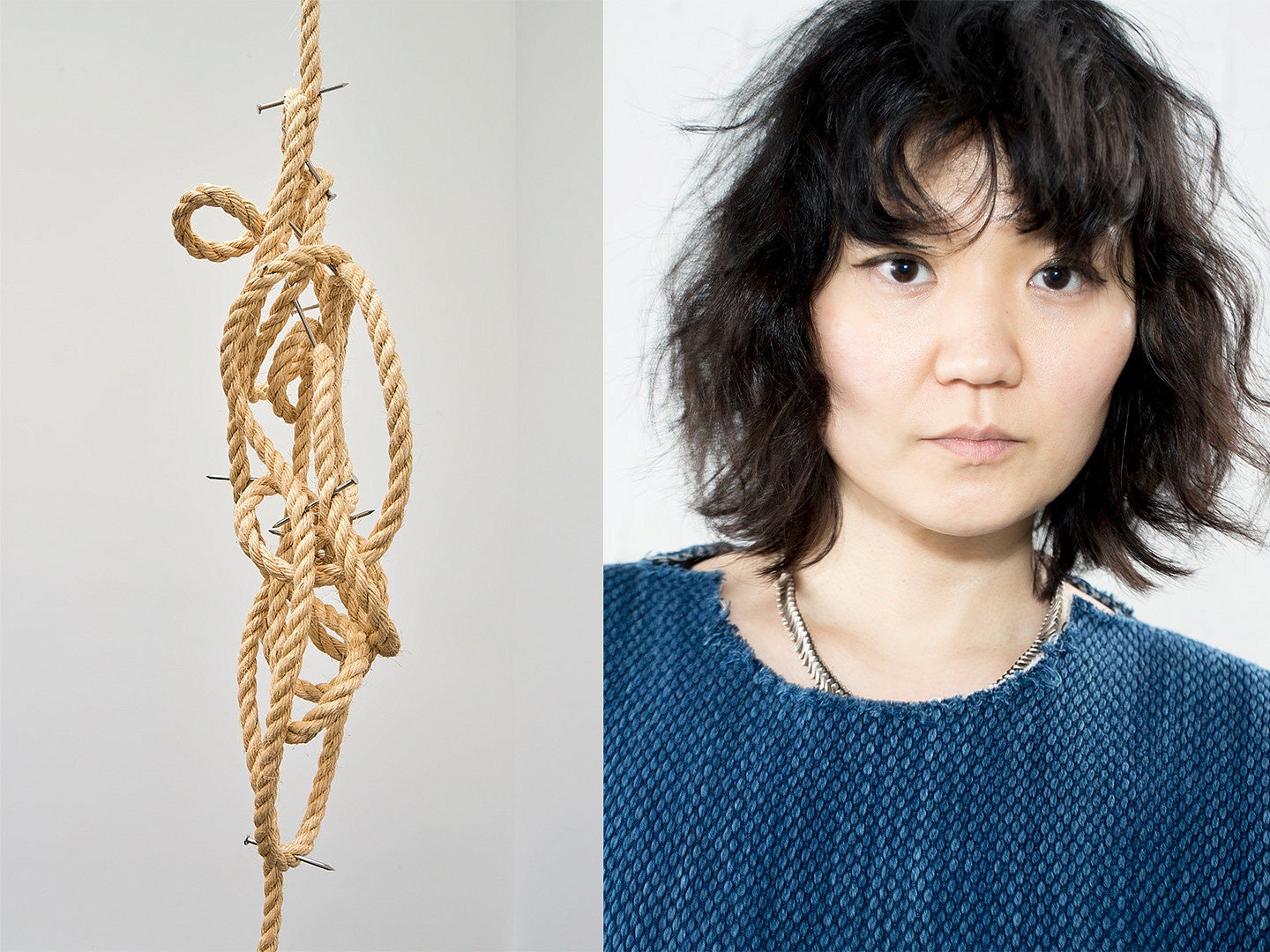
Above left: Bad, Immediately at Jack Hanley Gallery, New York, 2021. Above right: Margaret Lee.
Edie Fake
“An Impossible Place”
February 9
Watch a video of the Edie Fake lecture on YouTube.
Edie Fake is a painter and visual artist whose work examines issues of trans identity and “queer space” through the lens of architecture and ornamentation. Fake’s work has been exhibited nationally and internationally, including solo shows at the Everson Museum of Art in Syracuse, NY and Marlborough Contemporary, NYC, and in group exhibitions at the Museum of Arts and Design, NYC and the Institute for Contemporary Art at VCU in Richmond, VA. His collection of comics, Gaylord Phoenix, won the 2011 Ignatz Award for Outstanding Graphic Novel. Fake’s latest projects include mural installations for The Drawing Center, NYC and BAMPFA in Berkeley, CA. He is currently represented by Western Exhibitions in Chicago and Broadway Gallery in New York
This lecture is made possible by the Davis Family Endowed Fund in Art.
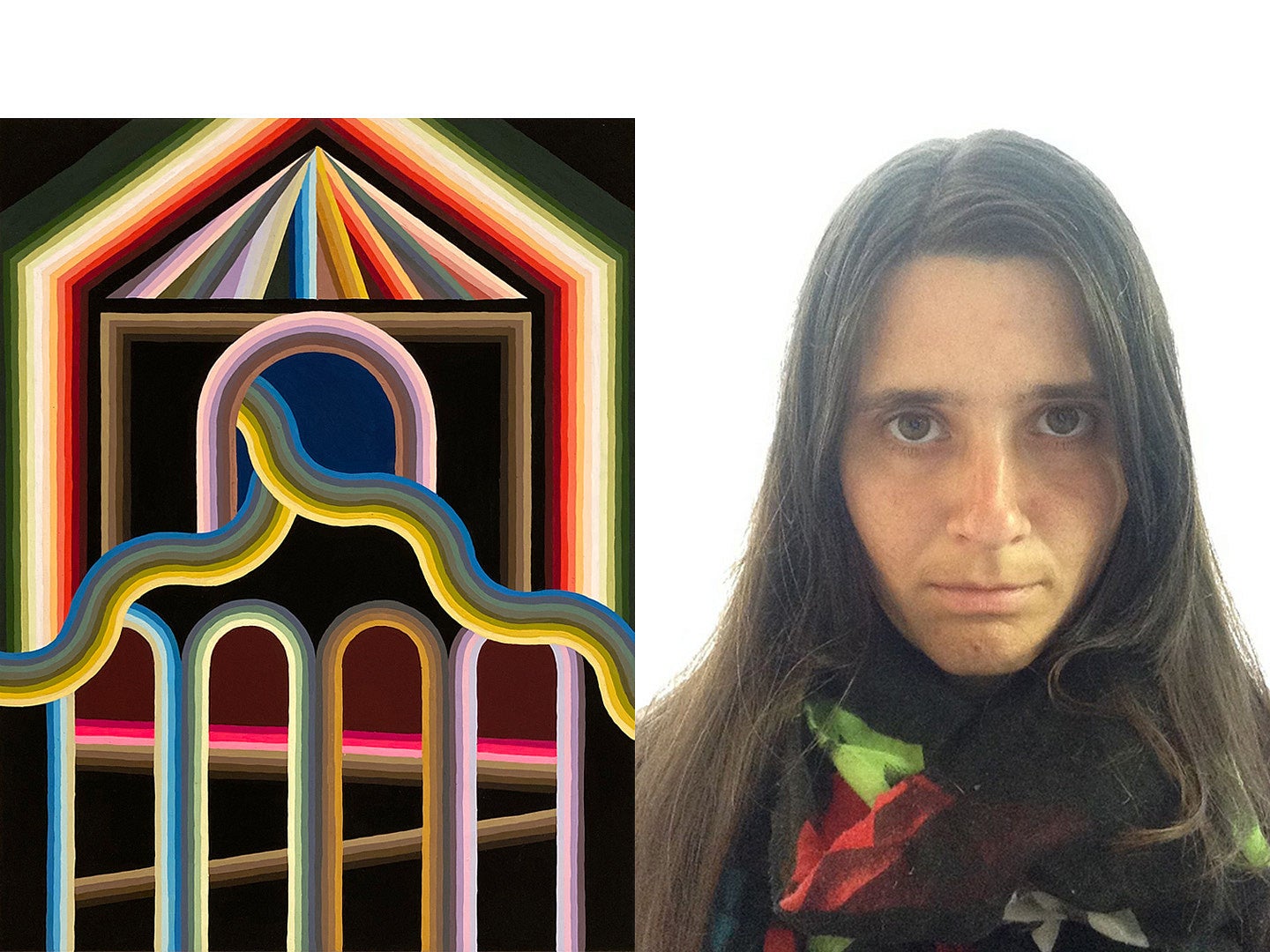
Above left: Oasis I, 2022, gouache on wood panel, 12 x 16 inches. Above right: Edie Fake.
Elissa Auther
“Queer Maximalism”
February 23
Watch a video of the Elissa Auther lecture on YouTube.
This talk focuses on the solo exhibition of the costume designer and performer, Machine Dazzle, and the relation of his work to creative spheres cutting across art, craft, design, theatre, and nightlife.
Elissa Auther is the Deputy Director of Curatorial Affairs and William and Mildred Lasdon Chief Curator at the Museum of Arts and Design (MAD). She provides the strategic direction and creative oversight for exhibitions, acquisitions of works of art for the Museum’s collection, publications, and exhibition-related public programming. She has published widely on a diverse set of topics, including the history of modernism and its relationship to craft and the decorative, the material culture of the American counterculture, and feminist art. Her book “String, Felt, Thread: The Hierarchy of Art and Craft in American Art” focuses on the broad utilization of fiber in art of the 1960s and 1970s and the changing hierarchical relationship between art and craft expressed by the medium’s new visibility. Her most recent exhibitions for the Museum of Arts and Design include “Surface/Depth: The Decorative After Miriam Schapiro” and “Queer Maximalism x Machine Dazzle.”
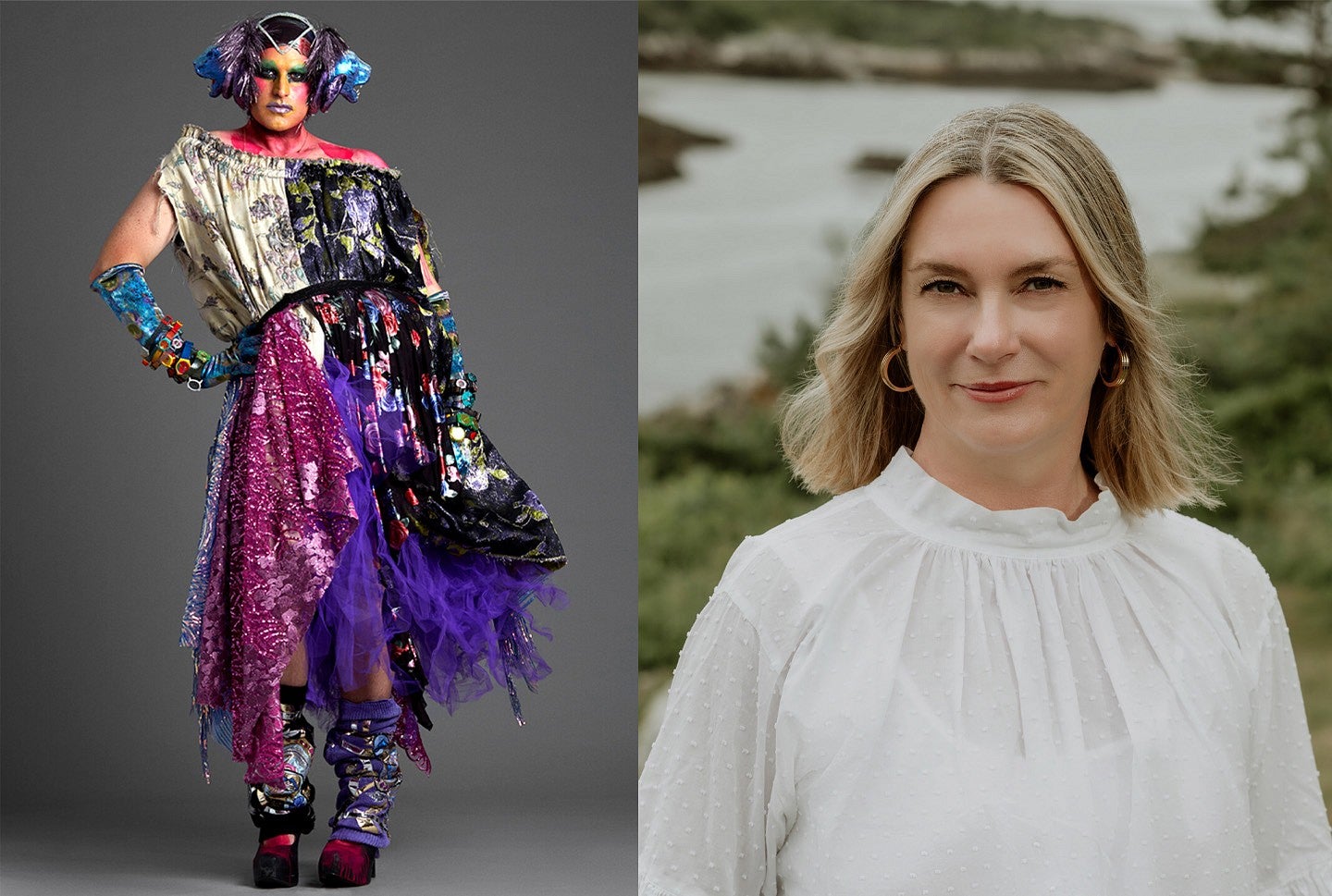
Above left: Machine Dazzle, Treasure, 2019, photograph by Gregory Kramer. Above right: Elissa Auther, photograph by Val Bozzi.
Salvador Jiménez-Flores
“Nepantla”
March 2
Watch a video of the Salvador Jiménez-Flores lecture on YouTube.
Salvador Jiménez-Flores is an interdisciplinary artist born and raised in Jalisco, México. He explores the politics of identity and the state of double consciousness. Jiménez-Flores addresses issues of colonization, migration, “the other,” and futurism by producing a mixture of socially conscious installation, public, and studio-based art. His work spans from community-based work, drawing, ceramics, prints, and mixed media sculpture. Jiménez-Flores has presented his work at the National Museum of Mexican Art, Grand Rapids Art Museum, Urban Institute of Contemporary Art, Bemis Center for Contemporary Arts, and Museum of Art and Design amongst others. He served as Artist-In-Residence for the city of Boston, Harvard Ceramics Program, Office of the Arts at Harvard University, and Kohler Arts Industry. Jiménez-Flores is a recipient of Joan Mitchell Foundation Painters & Sculptors Grants and The New England Foundation for the Arts, Threewalls’ RaD Lab+Outside the Walls Fellowship Grant, and he is a 2021 United States Artist Fellow. He is an Assistant Professor in ceramics at the School of the Art Institute of Chicago.
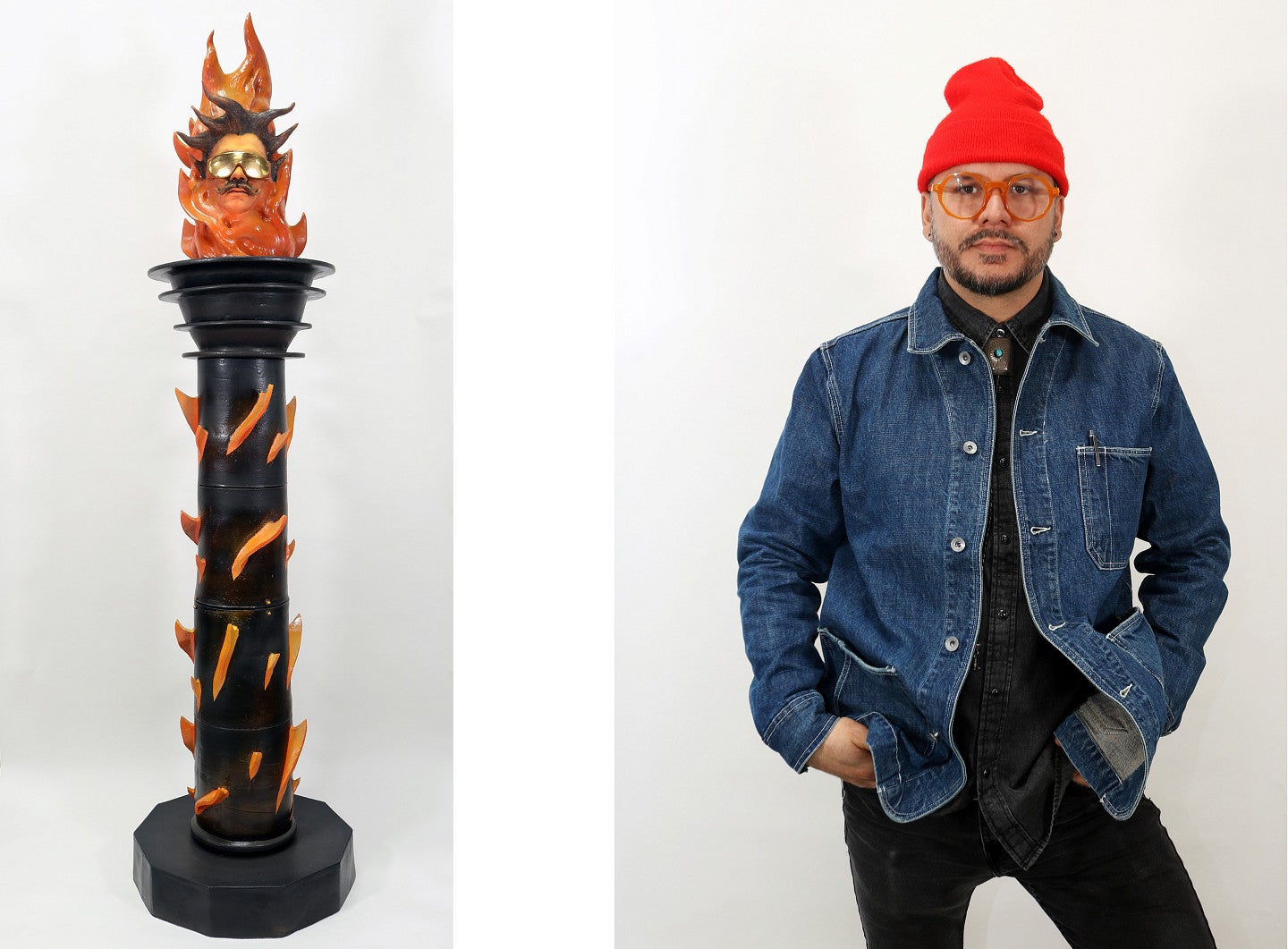
Above left: The Fire Next Time, Red and white stoneware, underglazes, glazes, black stain, gold luster, 83in x 20in x 20in, 2022. Above right: Salvador Jiménez-Flores.
Alex Da Corte
“Fun World”
March 9
Watch a video of the Alex Da Corte lecture on YouTube.
Alex Da Corte explores the nuances of contemporary life in his videos, installations, paintings, and sculptures, which are often united together in richly-hued, dreamlike environments. With a keen attention to color and form, Da Corte draws from a wide range of sources, including popular and consumer culture, art history, and modern design. Throughout his artistic practice, figures such as Eminem, Allan Kaprow, and the Wicked Witch of the West stand on equal footing alongside objects both commonplace and fantastic. Touching upon notions of identity, intimacy, and taste, Da Corte’s work reimagines the familiar in wholly unexpected ways.
Alex Da Corte (b. 1980) was born in Camden, New Jersey, and lives and works in Philadelphia. His work was included in the 2019 Venice Biennale and the 2018 Carnegie International in Pittsburgh. Past one-person exhibitions include the Museum Boijmans Van Beuningen in Rotterdam, the Secession in Vienna, MASS MoCA in North Adams, Massachusetts, and the Kölnischer Kunstverein in Cologne. Da Corte was selected for the 2021 Roof Garden Commission at the Metropolitan Museum of Art in New York. "Mr. Remember," a solo survey exhibition spanning 20 years of work, opened in 2022 at the Louisiana Museum of Modern Art in Humlebæk, Denmark.
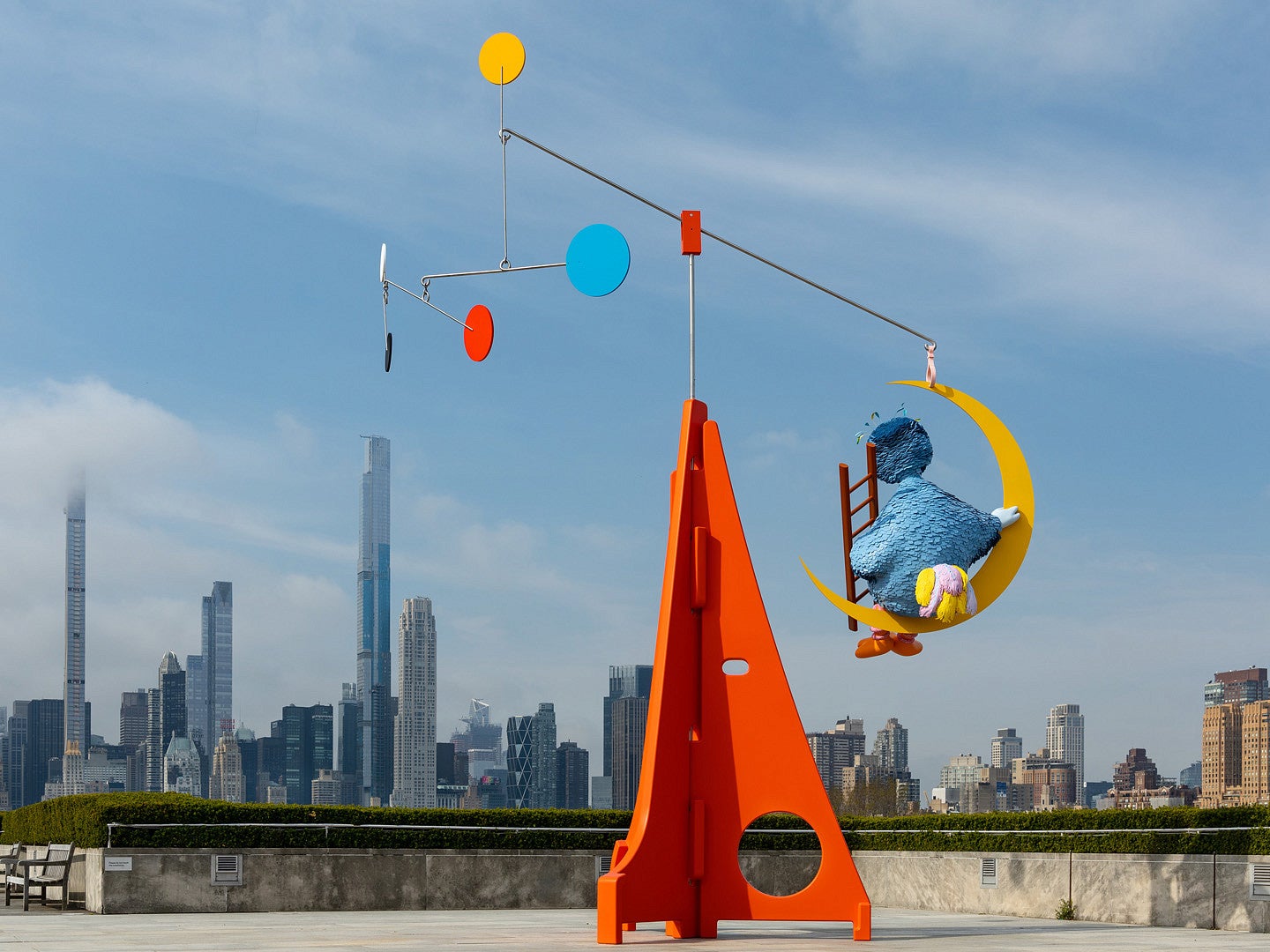
As Long As the Sun Lasts, the 2021 Roof Garden Commission, the Metropolitan Museum of Art, New York, 2021. Photo by Anna-Marie Kellen.

Alex Da Corte.
Naama Tsabar
“Artist Talk”
April 13
Watch a video of the Naama Tsabar lecture on YouTube.
Naama Tsabar’s practice fuses elements from sculpture, music, performance, and architecture. Her interactive works expose hidden spaces and systems, reconceive gendered narratives, and shift the viewing experience to one of active participation. Tsabar draws attention to the muted and unseen by propagating sound through space and sculptural form. Between sculpture and instrument, form, and sound, Tsabar’s work lingers on the intimate, sensual and corporeal potentials within this transitional state. Collaborating with local communities of female identifying and gender non-conforming performers, Tsabar challenges the canon of mastery by writing new feminist and queer histories of mastery. In her talk, Tsabar will discuss interactivity within the exhibition realm, the conception, and the use of various performative elements in her work and a feminist approach to performance and community.
Naama Tsabar (b. 1982, Israel) lives and works in New York. She received her MFA from Columbia University in 2010. Solo exhibitions and performances of Tsabar have been presented at the Solomon R. Guggenheim Museum (New York), Museum of Art and Design (New York), The High Line Art (New York), Nasher Museum (Durham, NC), Kunsthaus Baselland (Switzerland), Palais De Tokyo (Paris), Prospect New Orleans, Tel Aviv Museum of Art, The Herziliya Museum for Contemporary Art in Israel, MARTE-C (El Salvador), CCA Tel Aviv (Israel), Faena Buenos Aires, Frieze Projects New York, Kasmin (New York), Paramo Gallery (Guadalajara), Dvir Gallery (Israel and Brussels), Spinello Projects (Miami) Shulamit Nazarian (Los Angeles), The Bass Museum (Miami), Wadsworth Atheneum Museum of Art (Connecticut). Her work has been featured in publications including ArtForum, Art In America, ArtReview, ARTnews, The New York Times, New York Magazine, Frieze, Bomb Magazine, Art Asia Pacific, Wire, and Whitewall, among others.
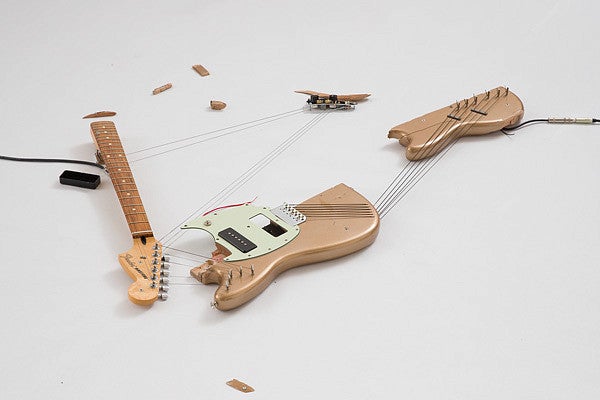
Melody of Certain Damage #22, 2022. Photo credit: Elisheva Gavra.

Naama Tsabar. Photo credit: Ebru Yildiz.
Jim Drain
“Making Time: Craft-Based Sculpture”
April 20
Watch a video of the Jim Drain lecture on YouTube.
“When I first started adding knitting to my sculpture, I was excited that I could quickly customize a ubiquitous material and apply it to sculpture as a stand-in for the body. It was a skin paused in motion. I could move away from a space that felt stratified and stale; however, through a number of important texts and exhibitions that dove into the archive, I clearly saw there was a lineage of marginalized artists that had come before me working in the same space without recognition. The space of Craft is not without its own difficulties and problems; they persist. But being able to invest in material, process and a discipline has been an antidote and nourishing place for making during the uncertainty of Covid.” Jim Drain, 2023 Jim Drain was born in Cleveland, Ohio in 1975 and attended the Rhode Island School of Design (1994-1998 BFA, Sculpture). Drain was a member of Forcefield, a collective that merged music, performance film and installation into one. Forcefield was active from 1996 to 2002 and was part of the Whitney Biennial, 2002. Drain has had solo exhibitions at the University of Florida; Locust Projects, Miami; and the Blanton Museum of Art, University of Texas, Austin. Drain has participated in group exhibitions at MOCA, LA; the Fabric Workshop, Philadelphia; Serpentine Gallery, London; Depart Foundation, Rome; and the 7th Bienniale d’Art Contemporain de Lyon. Drain was one of two recipients of the 2005 Baloise Prize and was recognized with artist Bhakti Baxter for creating “best public art projects in the nation” by Americans for the Arts in 2015.
This lecture is made possible by the Gordon W. Gilkey Endowed Fund.

zapf dingbats, 2018, exhibition view at Nina Johnson Gallery, Miami, mixed media and variable dimensions.
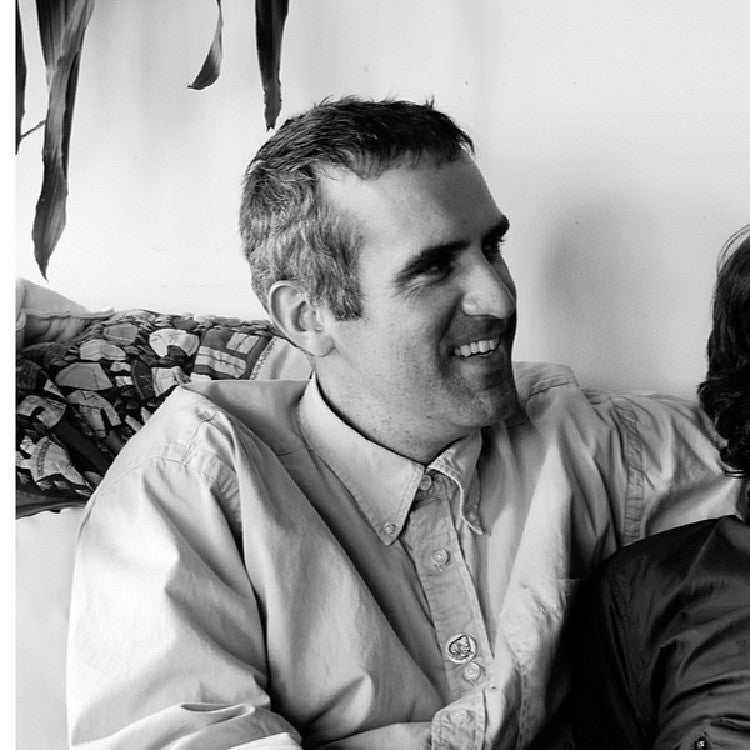
Jim Drain. Photo credit: Paul Mpagi Sepuya.
Yoonmi Nam
“Generally Meant to Be Discarded”
May 11
Watch a video of the Yoonmi Nam lecture on YouTube.
“I am interested in the observation and depiction of everyday objects and occurrences, especially when they subtly suggest contradictions - a perception of time that feels both temporary and lasting and a sense of place that feels both familiar and foreign. I will talk about my work and my background as a printmaker. I will also discuss how printmaking continues to inform the way I make my recent sculptural works.” Yoonmi Nam, 2023.
Yoonmi Nam received her MFA degree from the Rhode Island School of Design and BFA degree from Hong-Ik University in Seoul, Korea. She was awarded residencies at Mokuhanga Innovation Laboratory in Japan three times (2004, 2012, 2019) to study traditional Japanese woodblock printing techniques and is the recipient of the Keiko Kadota Award for Advancement of Mokuhanga. She has participated in artist residencies at Brandywine Workshop and Archives in Philadelphia, Frans Masereel Centrum in Belgium, Kala Art Institute in California, Vermont Studio Center, and a 3-year studio residency at Studios Inc. in Kansas City. Her work is in the collections of the RISD Museum, RI; Spencer Museum of Art, KS; and the Hawai’i State Art Museum, HI; among others, and has shown her work in over 20 solo exhibitions and 180 group exhibitions both nationally and internationally. Yoonmi is a professor of printmaking at the University of Kansas.
This lecture is made possible by the Gordon W. Gilkey Endowed Fund.
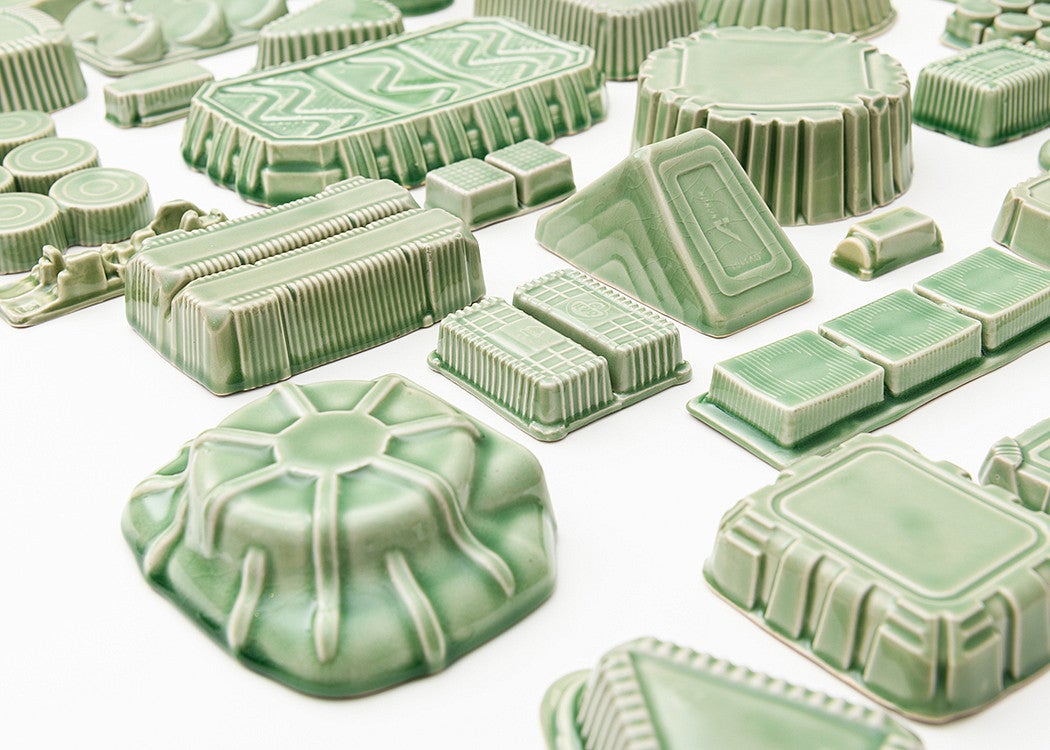
Keeping, 2022, Slip cast porcelain, celadon glaze, dimensions variable. Photo credit: Nelson-Atkins Museum Media Services, Dana Anderson & Gabe Hopkins
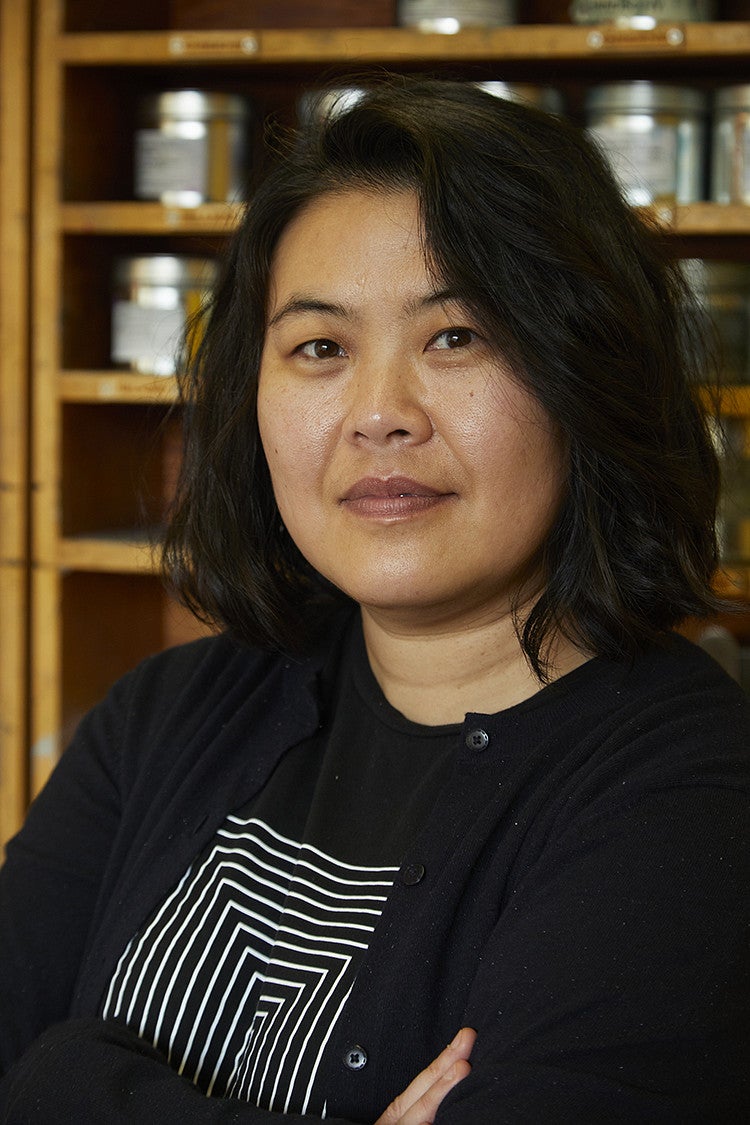
Yoonmi Nam. Photo credit: Alec Smith.
Julia Fish
“home / work : paintings, picture-thinking & notes in progress”
May 25
Watch a video of the Julia Fish lecture on YouTube.
Julia Fish will present a selected overview of earlier and recent paintings, works on paper, site-generated projects and exhibitions. The artist will also reflect on her long-standing practice of maintaining a “studio notebook” and within the context of recently authored, published contributions to exhibition catalogues of her work as well as the work of other artists.
Inclusively and theoretically, Julia Fish’s work can be characterized as both site-generated and context-specific: in temporary projects/installations, and in the on-going sequence of paintings and works on paper developed in response to a close examination of living and working within her home and studio, a 1922 brick storefront in Chicago. Research interests include related disciplines of architectural history, theory, and music notation. Fish completed BFA and MFA degrees in Oregon and Maryland, and has lived and worked in Chicago since 1985. Curated exhibitions include: The Renaissance Society, University of Chicago; Galerie Remise, Bludenz, Austria; 2010, the Whitney Biennial; and ten-year solo survey : bound by spectrum, DePaul Art Museum, Chicago, 2019-2020. Her work is included in collections of the Art Institute of Chicago; Denver Art Museum; Museum of Modern Art, New York, among others. Fish is represented by Rhona Hoffman Gallery, Chicago, and David Nolan Gallery, New York.

Test for violet in dark days, after Threshold — score for six Plans [ spectrum east to west ], 2021, Japan-printed tablet paper with archival pen, ink / hand-stamped, 9 7/8 x 14 1/8 inches.

Julia Fish.
2021–22 Visiting Artist Lecture Series
Fall 2021
October 7
October 14
October 21
November 4
Winter 2022
January 13
January 27
February 3
March 3
Spring 2022
April 14
Amy Brener
“Omni-Kits and Flexi-Shields”
Thursday, October 7
Watch a video of the Amy Brener lecture on YouTube
Amy Brener uses inventive mold-making and casting techniques to fuse everyday objects and personal imagery into her sculptures. The resulting forms are at once familiar and strange, resembling otherworldly monuments, reliquaries and garments. Her work seeks to level hierarchies between sacred and mundane material, questioning what we choose to preserve and discard.
Amy Brener was born in Victoria, BC, and moved to New York City in 2007. Since graduating with an MFA from Hunter College in 2010, her sculptures have been exhibited at galleries and institutions across the US, Canada, Europe and China. Highlights include MoMA PS1 and Socrates Sculpture Park in New York, the Nasher Sculpture Center in Dallas, Galerie Pact in Paris, Wentrup Gallery in Berlin and Riverside Art Museum in Beijing. Her work has been featured in publications such as The New York Times, Art in America, CURA, Artnet News and The Brooklyn Rail. She is represented by Jack Barrett Gallery in New York, where she will present a solo exhibition in the fall of 2021.
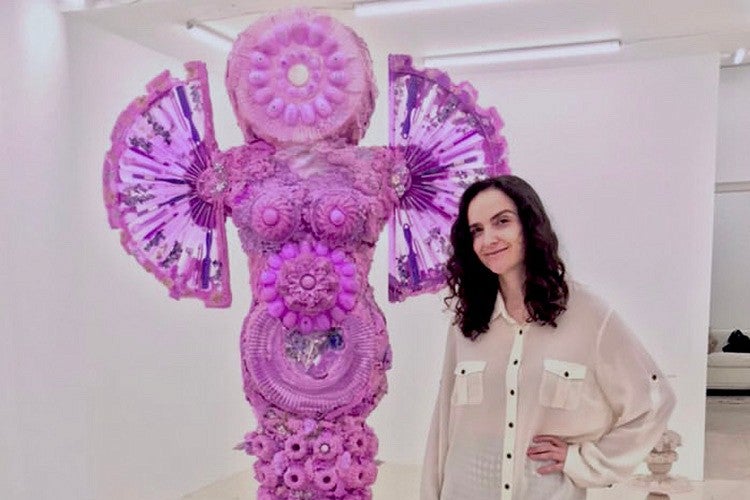
Amy Brener.
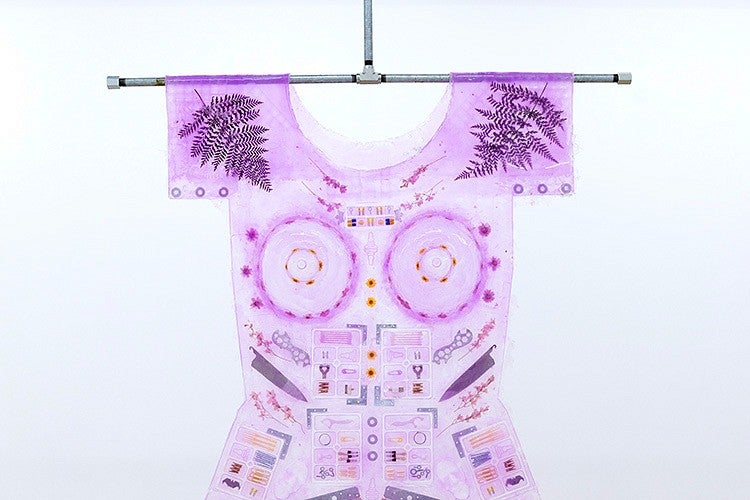
Flexi-Shield (Eostra), 2019, platinum silicone, pigment, larkspur and chrysanthemum, flowers, fern leaves, miscellaneous objects, 72 x 50 x 8 inches.
Catherine Haggarty
“You Know More Than You Can Say”
Thursday, October 14
Watch a video of the Catherine Haggarty lecture on YouTube
"I always keep my drawings up while I paint. I look over, remember a line, and then absorb it to translate it. Drawings live in my studio as a beginning—a middle and an end to the work. They are preparatory but also the point of the work. They are the end game and also the research. My project in art is all about language. Words are entirely abstract—the forms in my work shift from defined to ambiguous shapes that refer to animals, symbols, and glyphs. Drawing challenges my hand, my memory as well as my eyes. I see my drawings as no different than a larger 'painting'. It’s a healthy ecosystem and I trust in it. Community engagement is critical to me. My positions as faculty and critic enrich my life and my experience in the arts. I find all of these facets of my work and life as one and feel I need them all to varying degrees. I am excited to talk about the levels of inclusivity that the art world now has—despite the proclivity to think otherwise. I will share ideas of collaboration as learning, curating as influence, outreach as sustainability and finding one’s voice in the arts." - Catherine Haggarty, 2021
Catherine Haggarty is an artist based in Brooklyn, New York. Haggarty’s paintings and curatorial work have been reviewed by and featured in Bomb Magazine, Hyperallergic, Artnet, Two Coats of Paint, Brooklyn Magazine, The New York Times, Maake Magazine, Art Maze Magazine, The Observer, Art Spiel and Sound and Vision Podcast. Solo exhibitions include Massey Klein Gallery, This Friday Next Friday, Bloomsburg University, One River School of Art and Design, Proto Gallery, and Look and Listen in Marseille France. Catherine has been a visiting artist & lecturer at Boston University MFA, Hunter MFA, Denison University, Purchase MFA, Brooklyn College MFA, and in 2018 she was the Anderson Endowed Lecturer at Penn State University. Haggarty earned her M.F.A from Mason Gross, Rutgers University in 2011. Currently, Haggarty is an adjunct professor at The School of Visual Arts (SVA) and also co-founded and co-directs the NYC Crit Club.
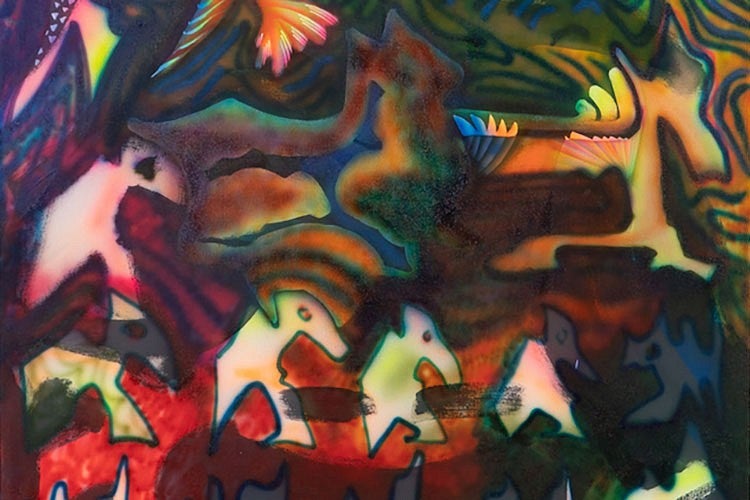
Invisible & Flying, 2021, fluid acrylic on canvas, 48 x 36 inches.
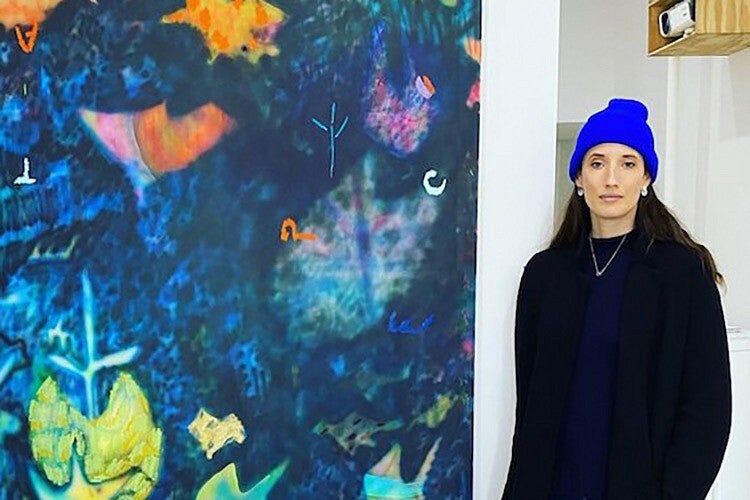
Catherine Haggarty.
Dianna Frid
“It Takes Time”
Thursday, October 21
Watch a video of the Dianna Frid lecture on YouTube
Dianna Frid will share her interest in the wormholes she has found in ancient books. Using these material texts as a springboard, she will discuss her textile and related works and also speak of time: the time it takes to make something, the rhythm of work, the time of minerals and asteroids.
Dianna Frid is an artist working at the intersection of material texts and textiles. Her artist’s books and mixed-media works make visible the tactile manifestations of language. In her work, embroidery is a prominent vehicle for exploring the relationships between writing and drawing, and the overlaps of transcription, translation, and legibility. Frid was born in Mexico where she was first exposed to textiles as complex codes of material writing. This point of reference helps her situate her work alongside lineages that embrace art and needlework without pitting them in hierarchical opposition. Time, Rhythm, Process, and Matter are never in opposition. English is Dianna Frid's stepmother tongue. She does not check boxes. Frid is Director of Graduate Studies and Professor at University of Illinois at Chicago, Art Department.
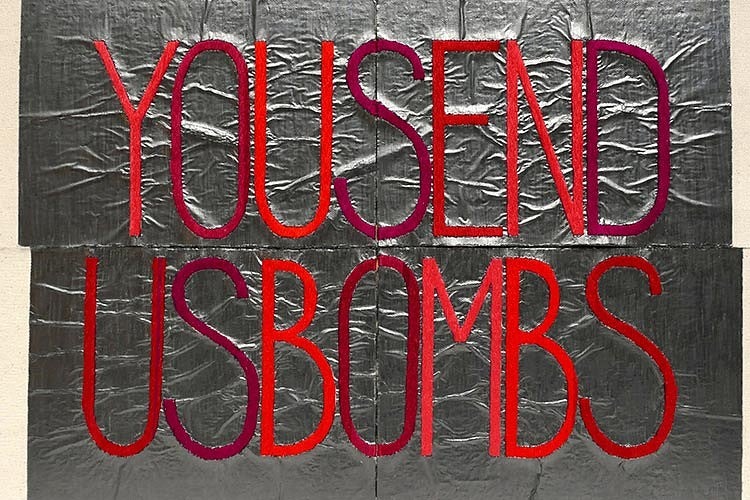
NYT, NOV 30, 2017, ARMANDO HART, From the Words from Obituaries series, 2018, Canvas, paper, embroidery floss, graphite, 15 x 20 inches.

Dianna Frid.
Lumi Tan
“Invisible Rooms: Performance and Institutions”
Thursday, October 28
Watch a video of the Lumi Tan lecture on YouTube
Lumi Tan will speak about the ways in which performance practices shift institutional value systems through her work curating time-based art for the white cube gallery, black box theater, and most recently, the computer screen. Thinking of issues of process, intimacy, documentation, audience, and site, Tan will connect this current work to the historical context of The Kitchen and the role of small scale institutions in the contemporary art ecosystem.
Lumi Tan is Senior Curator at The Kitchen in New York, where she has organized exhibitions and produced performances with artists across disciplines and generations since 2010. Most recently, Tan has worked with Kevin Beasley, Baseera Khan, Autumn Knight, and Kenneth Tam. Previously she curated projects with artists including Gretchen Bender, Meriem Bennani, Liz Magic Laser, The Racial Imaginary Institute, Sahra Motalebi, Sondra Perry, Tina Satter/Half Straddle, Anicka Yi, and Danh Vo and Xiu Xiu. Prior to The Kitchen, Tan was Guest Curator at the Fonds Régional d’Art Contemporain Nord Pas-de-Calais in France, director at Zach Feuer Gallery, and curatorial assistant at P.S.1 Contemporary Art Center. Her writing has appeared in The New York Times, Artforum, Frieze, Mousse, Cura, and numerous exhibition catalogues. She was the recipient of 2020 VIA Art Fund Curatorial Fellowship.
This lecture is made possible by the Critical Conversations program, a partnership between the Ford Family Foundation and the University of Oregon Department of Art's Center for Art Research with Reed College’s Douglas F. Cooley Memorial Art Gallery, Pacific Northwest College of Art, and Portland State University.

Credit: Baseera Khan, By Faith, 2020, The Kitchen at Queenslab. Photo: Ariana Sarwari.
Amy Yao
“From ESL to Asian Clams”
Thursday, November 4
Watch a video of the Amy Yao lecture on YouTube
Amy Yao will present slides ranging from her experiences playing in the punk band Emilys Sassy Lime in 1993, to her most recent work in progress involving soil analysis used in ceramics, language and theories about "invasive species" and algae-based polymers.
Amy Yao is a contemporary visual artist making work in many different mediums informed by ideas of waste, consumption, and identity. She is represented by Various Small Fires in Los Angeles and 47 Canal in New York City. Yao is a lecturer in visual arts at Princeton University, NJ.
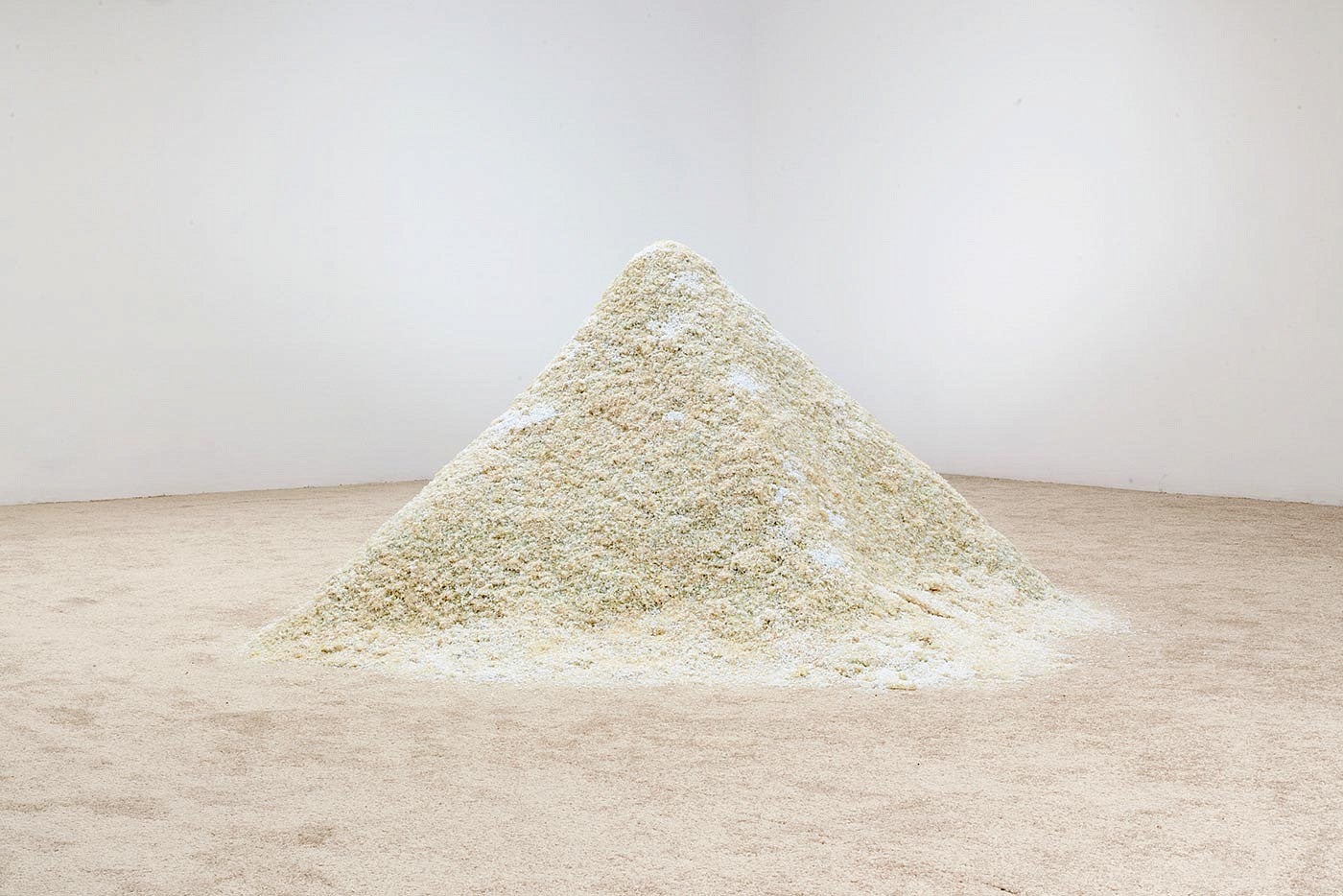
Dopplegangers, 2016, 42 x 88 x 94 inches.
Andrew Thomas Huang
“Queer Morphologies & Digital Spirits”
Thursday, November 18
Watch a video of the Andrew Thomas Huang lecture on YouTube
"Queer Morphologies & Digital Spirits" will share an overview of Huang's mixed media filmmaking career which interweaves live action, visual effects, puppetry and animation with his passion for folklore, mythology and queer futurism. The lecture will explore the process of world building and focus on the emergence of hybrid methodologies within one's visual practice. This talk will also explore how combining digital tools with performance can enable new forms of self-reinvention and the construction of digital identities.
Filmmaker and artist Andrew Thomas Huang crafts hybrid fantasy worlds and mythical dreamscapes. A Grammy-nominated music video director, Huang’s collaborators include Bjork, FKA Twigs and Thom Yorke among others. Serving as creative director for Bjork’s VR exhibition Bjork Digital, Huang created multiple immersive experiences for the pioneering traveling installation. His films have been commissioned by and exhibited at the Museum of Modern Art, NY, The Sydney Opera House and the Museum of Contemporary Art, LA. Inspired by his Chinese heritage and queer Asian mythology and folklore, Huang continues his foray into narrative with his first feature film TIGER GIRL which has received support from Film Independent and the Sundance Institute. Huang graduated with a degree in Fine Art and Animation from the University of Southern California.
This lecture is made possible by the Davis Family Endowed Fund in Art.
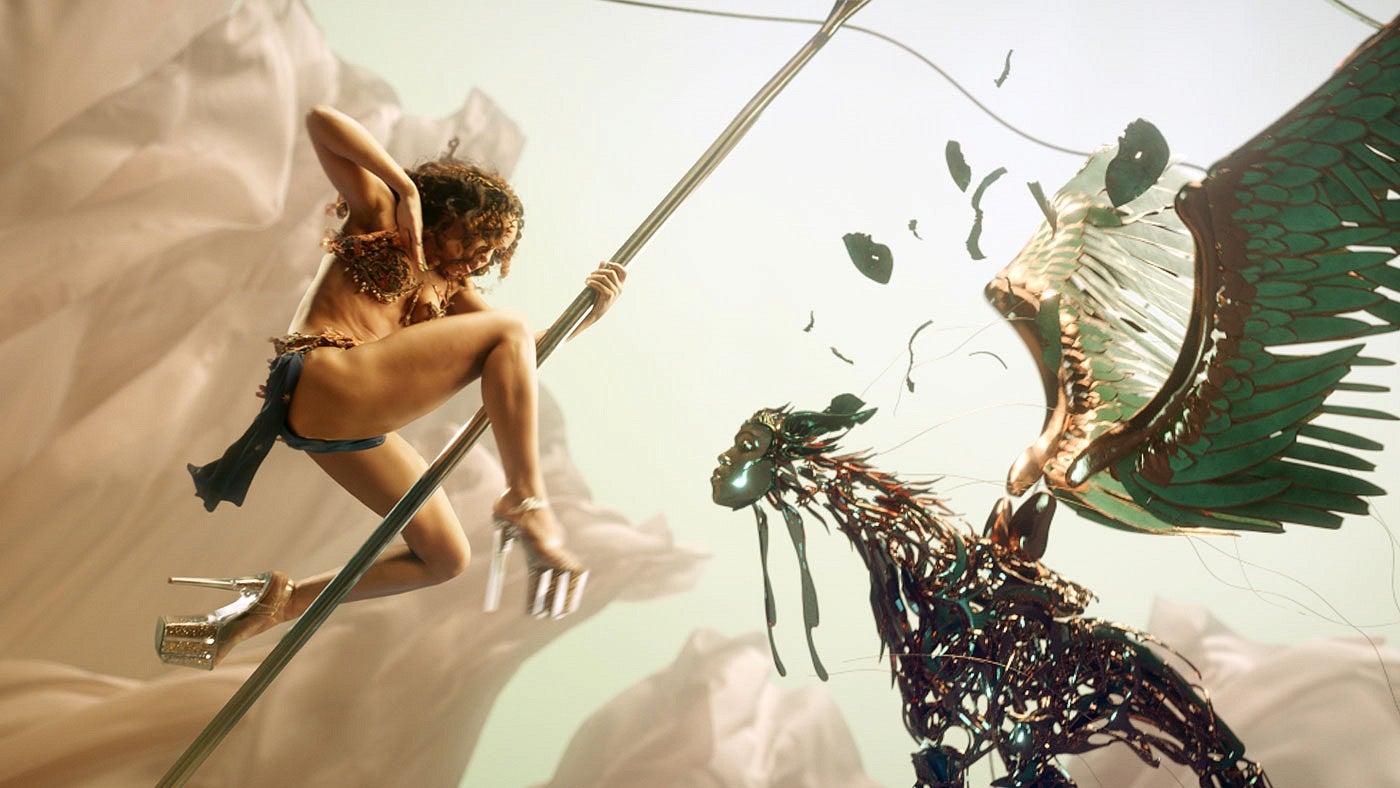
Still from FKA Twigs - "Cellophane" directed by Andrew Thomas Huang.
Pei-Hsuan Wang
“I’ve Left My Body to Occupy Others”
Thursday, January 13
Watch a video of the Pei-Hsuan Wang lecture on YouTube
Utilizing media spanning video, sculpture, drawing, and installation, Pei-Hsuan Wang’s practice inquiries into personal insecurities navigating between the East and the West, two cultural and geographical delineations that have shaped her upbringing. Drawing from trauma, memory, family history, and aspirations, Wang’s work mines the vulnerabilities, contradictions, and beauty that reside in identity formation as an Asian woman in diaspora.
The artist’s 11-year-old niece Iris, a White and East Asian mixed-heritage, first-generation Taiwanese American, has inspired a body of work that imagines racial and cultural hybridity alongside various architypes in nature and in myths. Zoomorphic beings become a kind of guardian and portal, giving form to the inner experience, and opening up narratives that empower from the visceral as well as the imaginative.
Pei-Hsuan Wang holds a BA from Macalester College, MN and an MFA from Cranbrook Academy of Art, MI, USA. She was resident at ISCP, New York (2018), Asia Culture Center, Gwangju, Korea (2018), and guest resident at the Rijksakademie, Amsterdam, Netherlands (2019). Wang is the winner of Special Jury Price of the 2019 Huayu Youth Award in China and is currently a candidate laureate at the Higher Institute of Art (HISK) in Ghent, Belgium.
This lecture is made possible in part by the Robert James Foundation.

Pei-Hsuan Wang.
Justine Kurland
“From Girl Pictures to SCUMB Manifesto: A Retrospective of Photo Work”
Thursday, January 27
Presented on Zoom.
In 1967, the radical feminist and writer Valerie Solanas sold copies of her newly authored SCUM Manifesto on the streets of New York’s Greenwich Village, charging $1 ($2 if the buyer was a man). It opens with an incisive description of her project: “[. . .] SCUM (Society for Cutting Up Men), which will eliminate through sabotage all aspects of society not relevant to women (everything), bring about a complete female take-over, eliminate the male sex and begin to create a swinging, groovy, out-of-sight female world.”
This lecture will follow the trajectory of Justine Kurland’s photography ending with her new collage work, SCUMB Manifesto (Society for Cutting Up Men’s Books). These object-based tactile continue themes explored in her earliest body of work, Girl Pictures (1997–2002), and again in Mama Babies (2004–07). Seeking and picturing freedom, imagining a matriarchal paradise is at the core of much of Kurland’s work. It is located here in the artistic act itself: the nature of collage—heterogeneous, pulled apart, shape-shifting, disrupted, cyborg, fantasy—has long made it a feminist strategy in life and in art.
Justine Kurland, known for her utopian photographs of American landscapes and their fringe communities, has spent the better part of the last twenty years on the road. In her recent work, Kurland cuts and collages the pages of photography books in her personal library authored by canonized white men. These tactile objects are a continuation of Kurland’s ongoing project of creating space for women. Kurland (born in Warsaw, New York, 1969) received her BFA from the School of Visual Arts and her MFA from Yale University. Her work is in the public collections of institutions including the Guggenheim Museum, Museum of Modern Art, Whitney Museum of American Art, and International Center of Photography, among others.
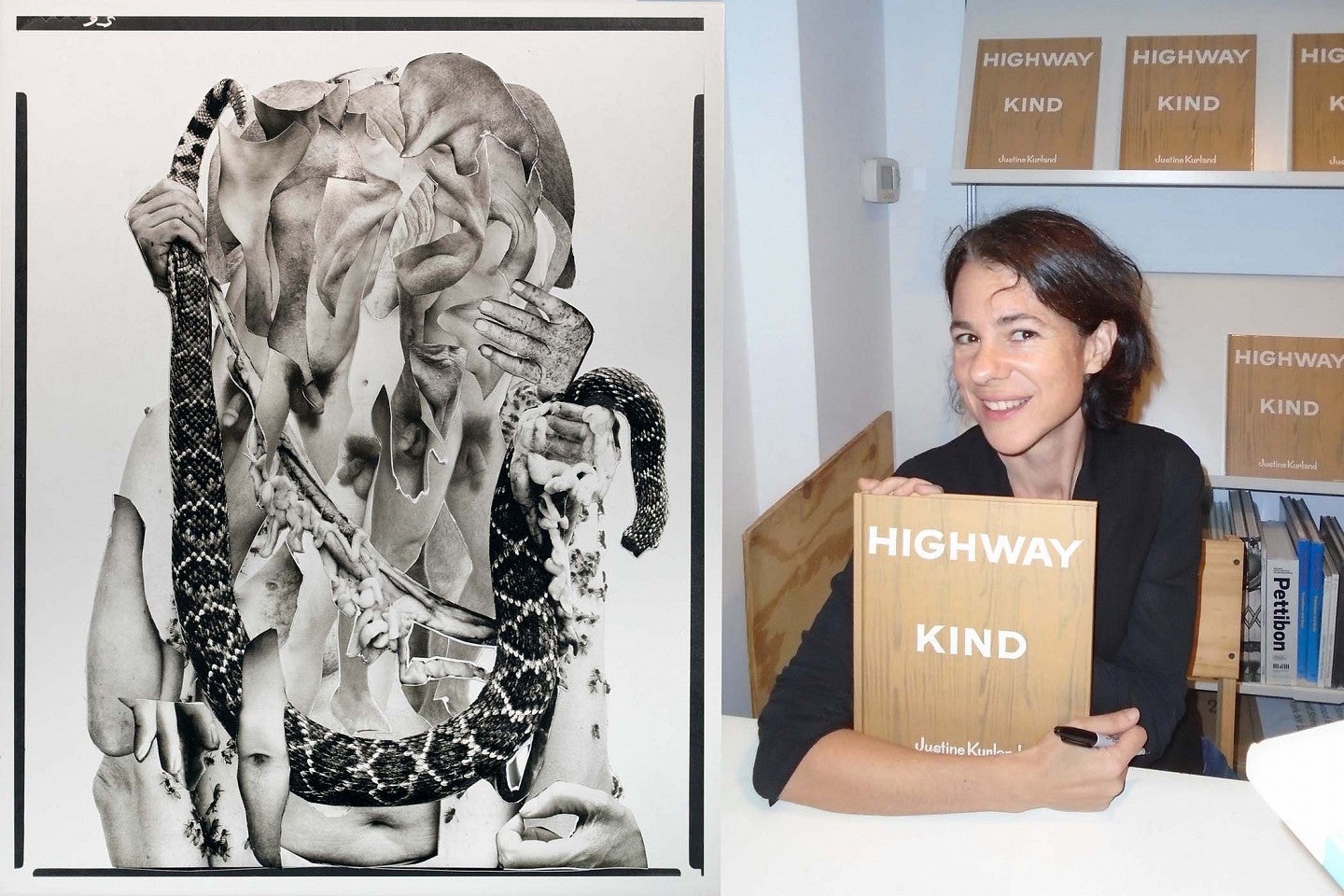
Courtesy the artist.
Lezley Saar
“Surrealism, Symbolism, and Significance”
Thursday, February 3
Watch a video of the Lezley Saar lecture on YouTube
Lezley Saar will be talking about the different series that she’s done and the various themes that deal with notions of race, gender, sanity, literature, heritage, escapism, and marginalization. These series include: Anomalies, Mulatto Nation, Autist’s Fables, Madwoman in the Attic, Monad, Gender Renaissance, A Conjuring of Conjurors, and Black Garden. She will delve into her decision-making process for her next theme/exhibition, which takes forever, as well as all the research. She will touch on her materials and the role they play in illuminating the subjects of her portraits. She will also mention a bit about her past, what she finds interesting today, and her hopes for the future.
Lezley Saar is a mixed media artist currently living in Los Angeles. While majoring in communications at San Francisco State University, she worked at KPFA radio in Berkeley as part of a collective; The Souls of Black Folk. There she started illustrating for her writer friends. In the 80s, she began making altered books. Her works now include paintings, drawings, altered books, banners, collages, dioramas, and installations. Saar’s various recent series; Anomalies, Mulatto Nation, Tooth Hut, Autist’s Fables, Madwoman in the Attic, Monad, Gender Renaissance, A Conjuring of Conjurors, and Black Garden deal with notions of race, gender, beauty, normalcy, escapism and sanity. She has exhibited nationally and internationally, and is in museum collections such as The Kemper Museum, CAAM, MOCA Los Angeles, LACMA, The Studio Museum in Harlem, The Ackland Art Museum, The Crocker Art Museum, The Museum of Fine Arts Houston,The Schnitzer Museum, Oregon, and The Santa Barbara Museum of Art.
Co-sponsored by the Jordan Schnitzer Museum of Art and the Department of Art.
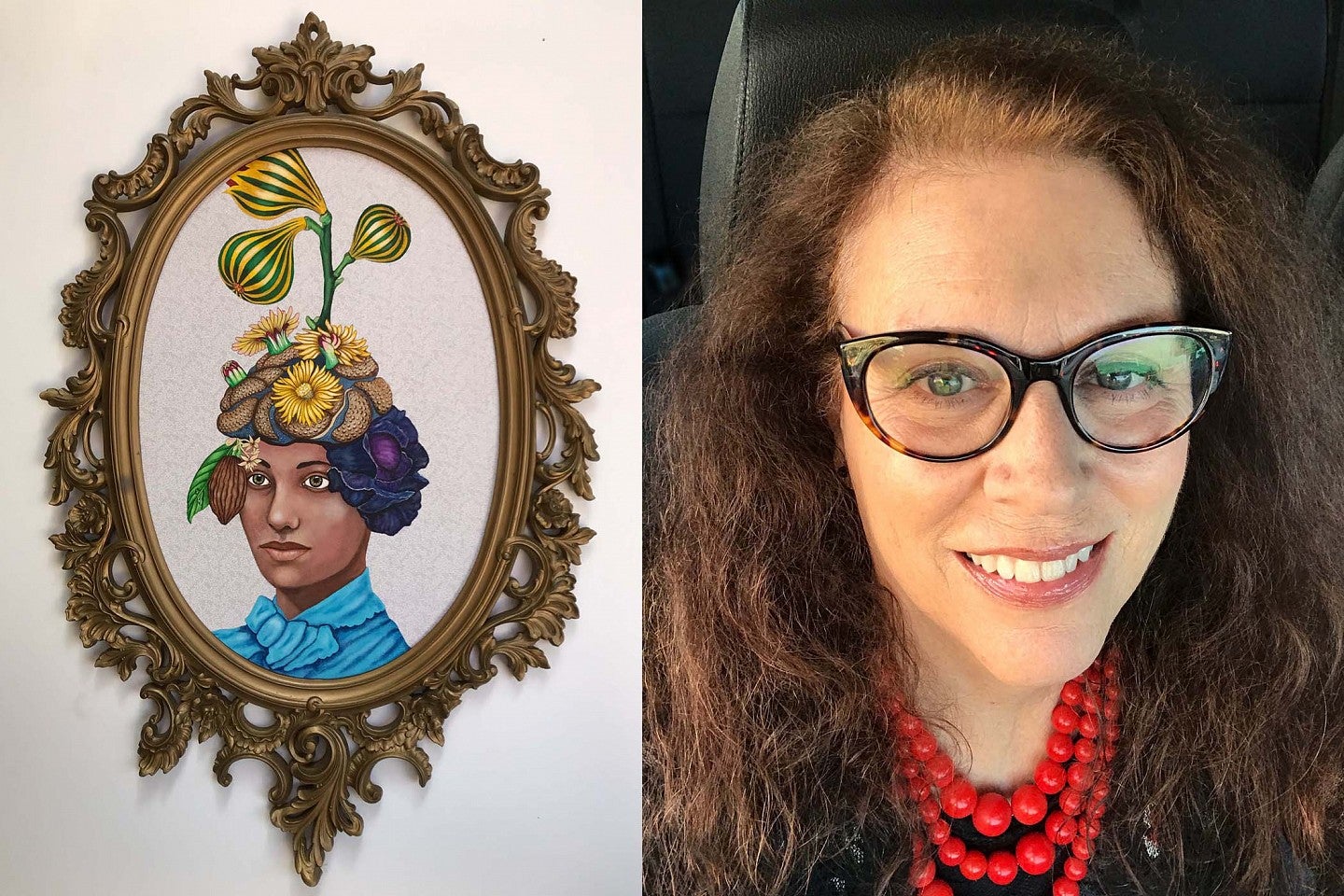
Above Left: O stems behold the night offering,2021, acrylic on fabric on board in found Syroco frame, 31 x 21 inches from the series “Black Garden” exhibition at Various Small Fires Gallery, Seoul, Korea, Fall 2021 | Above Right: Courtesy the artist.
Michael Sherwin
“Vanishing Points: Revisiting America's Indigenous Landscape”
Thursday, March 3
Watch a video of the Michael Sherwin lecture on YouTube
Vanishing Points is a long-term photography project that focuses on significant sites of Indigenous American presence, including sacred landforms, earthworks, documented archaeological sites and contested battlegrounds. The sites Sherwin chooses to visit and photograph are literal and metaphorical vanishing points. They are places in the landscape where two lines, or cultures, converge. While visiting these sites, Sherwin reflects on the monuments our modern culture will presumably leave behind and what the archaeological evidence of our civilization will reveal about our time on Earth. A major monograph on the Vanishing Points project was published in July 2021 by Germany-based publisher, Kehrer Verlag, one of the leading publishers of fine art photography in the world.
Michael Sherwin is a multimedia artist exploring scientific, cultural, and historical interpretations of the natural world. He has won numerous grants and awards for his work and has exhibited widely, including recent exhibitions at the Atlanta Contemporary Arts Center, Morris Museum of Art, Huntington Museum of Art, and the Center for Fine Art Photography among others. Reviews and features of his work have been published on numerous outlets, including The Washington Post, BuzzFeed News, Lenscratch and on National Public Radio. He has also lectured extensively about his work at universities and conferences across the nation. Sherwin earned an MFA from the University of Oregon in 2004, and a BFA from The Ohio State University in 1999. Currently, he is an Associate Professor of Art in the School of Art and Design at West Virginia University.
This lecture is made possible by the Laverne Krause Lectures and Exhibitions endowment.

John Wayne Point, Monument Valley Navajo Tribal Park, AZ.
Yuji Hiratsuka
“The Art of Color Intaglio Process and Aesthetics”
Thursday, April 7
Watch a video of the Yuji Hiratsuka lecture on YouTube
Yuji Hiratsuka mixes influences of east and west in his work. There is less of an emphasis on socio-cultural commentary and more of an emphasis about the placement and interplay of the visual effects. Hiratsuka plays with the metaphorical aspects of his subjects and their settings by portraying the irony, paradox, and satire in people’s daily lives. His images bear a slight resemblance to traditional Japanese Ukiyo-e prints, which were frequently decorative, brightly colored and featured highly stylized exaggerated and distorted figures, while also expressing contemporary aspects of the western world. Hiratsuka will explain the unique technique of his multicolor intaglio (etching) printmaking process. The process begins with a deep etching printed on a sheet of Kozo (mulberry) paper in black, after which the plate is reclaimed and re-etched for subsequent printing in yellow, red, and blue. In addition, Hiratsuka often applies the fifth or six extra layers of color as desired to enhance the image.
Yuji Hiratsuka was born in Osaka, Japan, and received a bachelor’s degree in art education from Tokyo Teachers’ University in 1978. He taught art at several high schools and junior high schools in Osaka until he moved to the United States in 1985 to pursue graduate degrees in printmaking at New Mexico State University and Indiana University. He taught printmaking, book arts and drawing at Oregon State University for the past three decades. His intaglio prints are in public collections including the British Museum, London, UK; State Museum of Oriental Arts, Moscow, Russia; Portland Art Museum, Portland, OR; Freer/Sackler, The Smithsonian’s Museum of Asian Art, Washington, D.C.; The Library of Congress, Washington, D.C.; Museum of Fine Arts Boston, Boston, MA; Cincinnati Art Museum, Cincinnati, OH; The Art Institute of Chicago, Chicago, IL; University of Oregon, Eugene, OR; de Young Fine Arts Museum of San Francisco, CA.
This lecture is made possible by the Gilkey Foundation Fund.

Wheedle Noodle, 2021, Intaglio and Chine Colle, 12 x 9 inches, courtesy of the artist.
Shawna X
“Processing”
Thursday, April 14
Watch a video of the Shawna X lecture on YouTube
Shawna X (BFA ’09, Digital Arts) is a visual artist based in New York City, known for her vibrant and graphical image-making. Her works are manifestations in the discovery of her personal journey, cultural identity, motherhood, and rekindling connection between mind and body. Currently, she is exploring the synchronicity between visceral and emotional explorations via traditional and AI expressions.

Birth, 2020.
Liz Magor
“I Have Wasted My Life”
Thursday, April 28
Canceled
Liz Magor will talk about her recent studio work, how to entertain contradiction, and how to be untopical yet relevant.
Liz Magor is a Vancouver-based artist who produces sculptural and photographic works concerned with the latent, affective range of familiar materials, images, and objects. Her process and studio practice were featured in Season 8 of the PBS series Art 21, "Art in the Twenty-first Century" and her work has been exhibited in major international exhibitions such as Documenta VIII, Kassel; the 41st Venice Biennale, and the 4th Biennale of Sydney. In 2019 Magor presented an exhibition titled BLOWOUT at the Carpenter Center for Visual Art, Cambridge, Mass. The exhibition traveled to the Renaissance Society in Chicago accompanied by a publication. Recent exhibitions include "Downer" at Catriona Jeffries Gallery, Vancouver and "I Have Wasted My Life" at Andrew Kreps Gallery, New York, NY.
This lecture is made possible by the George and Matilda Fowler Endowment Fund.

Liz Magor, Coiffed (detail), 2020, painted plywood, fabric skirting, silicone rubber, artificial hair, acrylic throw, woolen blankets, silver fabric, linen, jewelry boxes, costume jewelry, packaging materials, 27 x 132 x 96 inches, courtesy of the artist and Catriona Jeffries.
Elissa Auther
“Queer Maximalism”
Thursday, May 5
Canceled
This talk focuses on the solo exhibition of the costume designer and performer, Machine Dazzle, and the relation of his work to creative spheres cutting across art, craft, design, theatre, and nightlife.
Elissa Auther is the Deputy Director of Curatorial Affairs and William and Mildred Lasdon Chief Curator at the Museum of Arts and Design (MAD). She provides the strategic direction and creative oversight for exhibitions, acquisitions of works of art for the Museum’s collection, publications, and exhibition-related public programming. She has published widely on a diverse set of topics, including the history of modernism and its relationship to craft and the decorative, the material culture of the American counterculture, and feminist art. Her book String, Felt, Thread: The Hierarchy of Art and Craft in American Art focuses on the broad utilization of fiber in art of the 1960s and 1970s and the changing hierarchical relationship between art and craft expressed by the medium’s new visibility. Her most recent exhibitions for the Museum of Arts and Design include Surface/Depth: The Decorative After Miriam Schapiro and Queer Maximalism x Machine Dazzle.
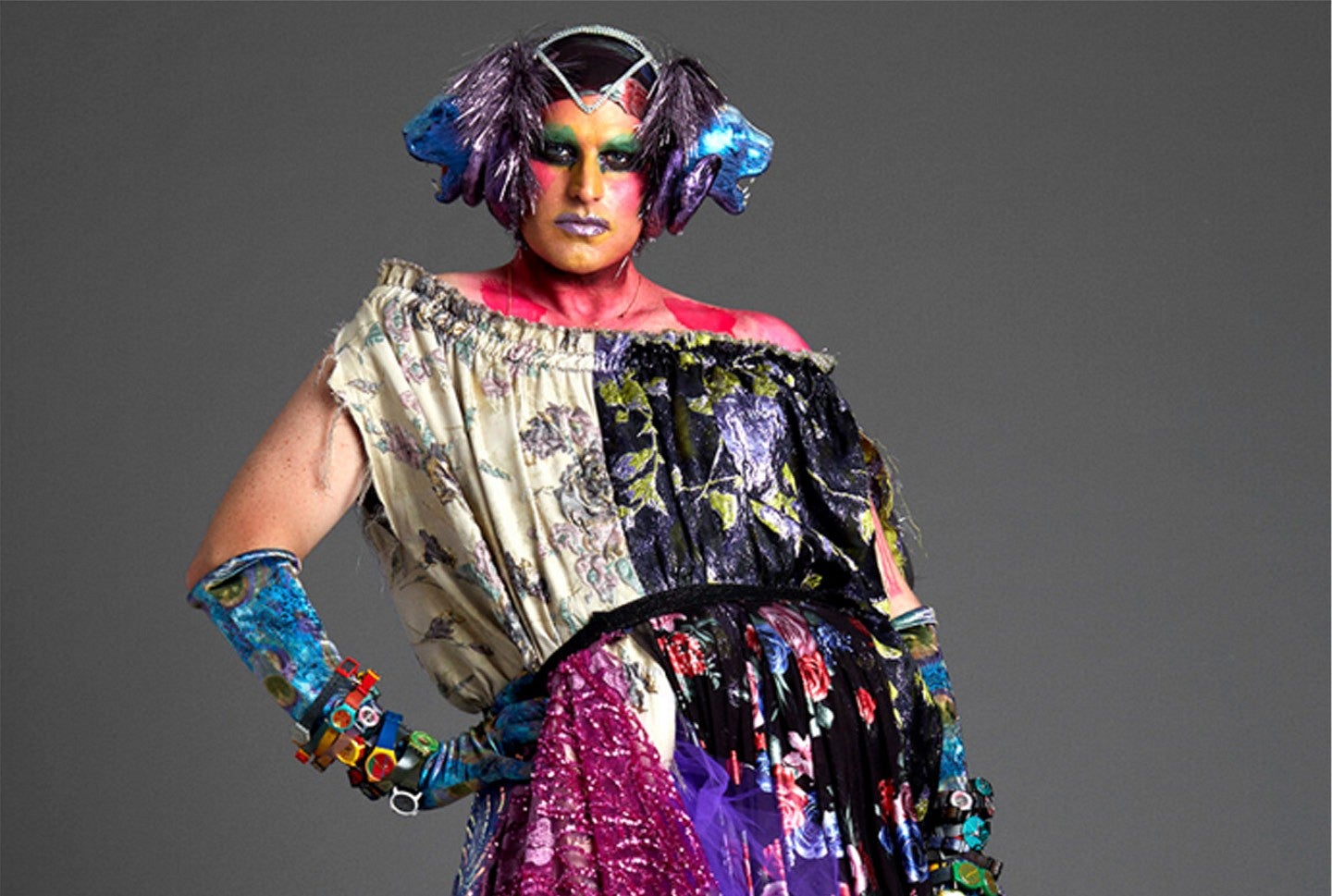
Machine Dazzle, Treasure, 2019, photograph by Gregory Kramer.
Lewis Watts
“Faces and Places in the Diaspora”
Thursday, May 19
Watch a video of the Lewis Watts lecture on YouTube
“I will show and talk about the thrust of my photography practice over the last fifty years. I have primarily been very interested in the culture, history, and migration of people in the African American Diaspora. This comes from my roots as the offspring of southern born parents who came west as part of the Great Migration of the Twentieth Century. My work has traced evidence of that journey in the landscape, the culture, belief, artifacts and faces of those who moved. I have also documented the source and roots of that migration, having photographed in the south, as well as in other destination in the west and north. This research has recently expanded to tracing patterns of culture and migration of the diaspora in Europe and Africa. I have also collected artifacts and historical literature as the vehicles that mark these journeys.” – Lewis Watts, 2022
Lewis Watts is a photographer, archivist, curator, and Professor Emeritus of Art at UC Santa Cruz. His research and artwork centers around the “cultural landscape” primarily in communities in the African Diaspora in different parts of the world. He is the co- author of “Harlem of the West: The San Francisco Fillmore Jazz Era” Heyday Books Berkeley 2020, “New Orleans Suite: Music and Culture in Transition” UC Press 2013 and “Portraits” EditionOne Press Berkeley 2020. His work has been exhibited at and/or is in the collections of The Zimmerli Museum, Rutgers University, Staatiche Kunstammiunger, Dresden Germany, Autograph London, The San Francisco Museum of Modern Art, The Ogden Museum of Southern Art, New Orleans, The Oakland Museum of California, The Amistad Center for Art and Culture, Hartford, Conn, and The McEvoy Foundation, San Francisco among others. He is affiliated with the Rena Bransten Gallery San Francisco.
This lecture is co-sponsored by the Jordan Schnitzer Museum of Art.
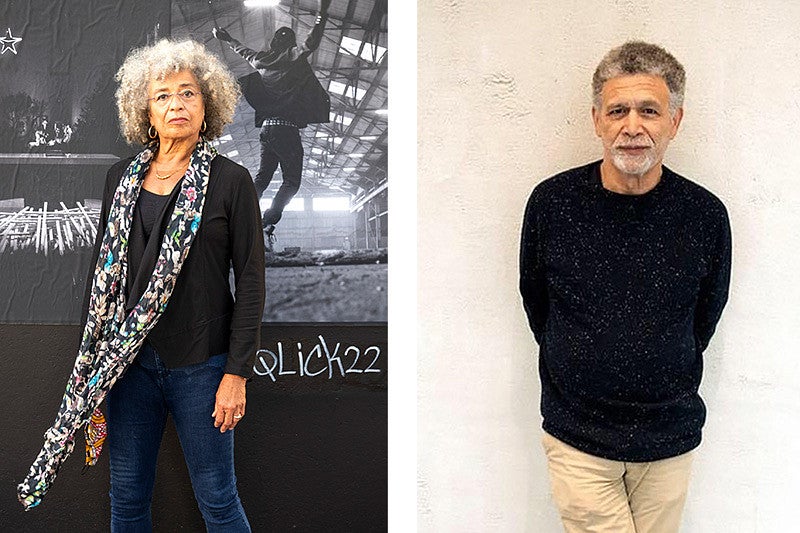
Above left: Angela Davis in Oakland, 2021, photograph by Lewis Watts. Above right: Lewis Watts in Cambridge, 2018, photograph by Lola Flash.
2020–21 Visiting Artist Lecture Series
Fall 2020
Thursday, October 29
Thursday, November 5
Thursday, November 12
Winter 2021
Thursday, January 14
Thursday, February 4
Thursday, February 11
Spring 2021
Thursday, April 8
Thursday, April 15
Thursday, April 22
Thursday, May 6
Thursday, May 20
Simon Starling
Davis Family Lecture
“Regarding Time”
Thursday, October 22
Watch a video of the Simon Starling lecture on the UO Channel.
With a particular focus on his activities as an exhibition maker, this richly illustrated talk will attempt to investigate the ways in which Simon Starling’s materially diverse art practice pushes and pulls at our understanding of time. From futuristic Zig-Zag chairs made of 45,000-year-old wood to the phantasmagorical effects of masquerades, from defunct craftsmanship to cutting-edge image production, from still photography to motion-control technology, this anachronic journey through the artist’s career will confront a uniform and absolute notion of time with possible divergent, convergent and parallel alternatives.
Simon Starling was born in Epsom, England, in 1967. He graduated from the Glasgow School of Art and was professor of fine arts at the Städelschule in Frankfurt from 2003 to 2013. His practice spans a wide variety of media, including film, installation and photography. Starling won the Turner Prize in 2005 and was shortlisted for the Hugo Boss Prize in 2004. He represented Scotland at the Venice Biennale in 2003 and has had solo exhibitions at Frac Ile-de-France, Le Plateau n Paris (2019), Musée regional d’art contemporain in Sérignan (2017), Japan Society in New York (2016), Museo Experimental El Eco in Mexico City (2015), Museum of Contemporary Art in Chicago (2014), Monash University Museum of Art in Melbourne (2013), Staatsgalerie Stuttgart in Germany (2013), Hiroshima City Museum of Contemporary Art in Japan (2011) and Massachusetts Museum of Contemporary Art in North Adams (2008). Starling lives in Copenhagen.
This lecture is made possible by the Davis Family Endowed Fund in Art.
John Mann
“The Walled Garden”
Thursday, October 29
Watch a video of the John Mann lecture on the UO Channel.
“My photographic images are highly influenced by my simultaneous interests in sculpture and drawing. By using the still life as a stage for the camera, I am interested in a conceptual and aesthetic building of the image. The camera ultimately lets me assign the eye to a fixed vantage point, where the resulting image both amplifies and denies the sculptural aspects of the work placed in front of the camera. These images use elements of drawing by requiring light to both reveal and obscure an object, or to use positive/negative forms to push and pull the image in the frame. I see this working process as a means to create images that are simultaneously easily understood and distinct abstractions of the subject itself.” - John Mann, 2020
John Mann is an artist who explores the visual complications of photography, the sequence and the still life though printed images, artist books and sculptural works. His artwork has been exhibited at venues such as Aperture, (NYC), Light Work (Syracuse, NY) Daniel Cooney Fine Art (NYC), Hyeres Festival of Photography (FR), Phillips de Pury (London), PDX Contemporary (Portland), Newspace Center for Photography (Portland), The Print Center (Philadelphia), Privateer Gallery (Brooklyn), and the Houston Center for Photography (TX). He has had artist residencies at Light Work (NY), The Visual Studies Workshop (NY), Virginia Center for Creative Arts (VA) and was a Research Fellow at the Lacoste School of the Arts (FR). He earned a BFA i(Studio Art) from Arizona State University and an MFA (Photography) from The University of New Mexico. He currently lives and works in Chicago and is a member of the Cake Collective photography network.
Jenna Sutela
“Many-Headedness”
Thursday, November 5
Jenna Sutela will share some of her ongoing artistic research on biological and computational systems. Sutela's talk will focus on an understanding of oneself as interconnected with the wider environment. It proposes a profound shift in subjectivity—one beyond anthropocentrism and individualism.
Jenna Sutela works with words, sounds, and other living media, such as Bacillus subtilis nattō bacteria and the “many-headed” slime mold Physarum polycephalum. Her audiovisual pieces, sculptures, and performances seek to identify and react to precarious social and material moments, often in relation to technology. Sutela's work has been presented at museums and art contexts internationally, including Guggenheim Bilbao, Moderna Museet, and Serpentine Galleries. She was a Visiting Artist at The MIT Center for Art, Science & Technology (CAST) in 2019-20.
Jess Perlitz
“I Don't Want to Live on the Moon”
Thursday, November 12
Grappling with how space gets articulated, Perlitz's work takes many forms - traversing performance, sculpture, and drawing. The work considers landscape and the ways in which define and seek to recognize ourselves within it.
Perlitz's work has appeared in a variety of venues such as playgrounds, fields, galleries, and museums, including the Institute for Contemporary Art in Philadelphia, Socrates Sculpture Park in NY, Cambridge Galleries in Canada, De Fabriek in The Netherlands, and aboard the Arctic Circle Residency. Born in Toronto, Canada, Jess is a graduate of Bard College, received her MFA from Tyler School of Art, and clown training from the Manitoulin Center for Creation and Performance. Jess is a 2019 Hallie Ford Fellow currently based in Portland, Oregon where she is Associate Professor of Art and Head of Sculpture at Lewis & Clark College. Jess was recently an artist in residence at the Bemis Center for Contemporary Art in Omaha, NE, and included in the 2019 American Academy of Arts & Letters Invitational Exhibition of Visual Arts in NYC. Her project, Chorus, is currently installed at Eastern State Penitentiary in Philadelphia, PA as part of the museum’s ongoing artists installation series.
Co-sponsored by the Jordan Schnitzer Museum of Art and the Department of Art and made possible by The Ford Family Foundation in conjunction with Hallie Ford Fellows in the Visual Arts (2017-19).
Caroline Woolard
“Art, Engagement, Economy: the Working Practice of Caroline Woolard”
Thursday, November 19
Watch a video of the Caroline Woolard lecture on the UO Channel.
Art, Engagement, Economy: the Working Practice of Caroline Woolard proposes a politics of transparent production in the arts, whereby heated negotiations and mundane budgets are presented alongside documentation of finished gallery installations. Audience members will follow the behind-the-scenes work that is required to produce interdisciplinary art projects, from a commission at MoMA to a self-organized, international barter network with over 20,000 participants. With contextual analysis of the political economy of the arts, from the financial crisis of 2008 to the COVID pandemic of 2020, this talk suggests that artists can bring studio-based sculptural techniques to an approach to art-making that emphasizes interdisciplinary collaboration and dialogue.
Caroline Woolard (b.1984) is an American artist who, in making her art, becomes an economic critic, social justice facilitator, media maker, and sculptor. Since the financial crisis of 2007-8, Woolard has catalyzed barter communities, minted local currencies, founded an arts-policy think tank, and created sculptural interventions in office spaces. Woolard has inspired a generation of artists who wish to create self-organized, collaborative, online platforms alongside sculptural objects and installations. Her work has been commissioned by and exhibited in major national and international museums including MoMA, the Whitney Museum, and Creative Time. Woolard’s work has been featured twice on New York Close Up (2014, 2016), a digital film series produced by Art21 and broadcast on PBS. She is the 2018–20 inaugural Walentas Fellow at Moore College of Art and Design and the inaugural 2019–20 Artist in Residence for INDEX at the Rose Museum, and a 2020-2021 Fellow at the Center for Cultural Innovation.
Fred H. C. Liang
“Convergence”
This lecture was made possible by the Gordon W. Gilkey Endowed Fund.
Thursday, January 14
Watch a video of the Fred H. C. Liang lecture on the UO Channel.
Much of Fred H. C. Liang’s recent work combines jianzhi, the folk art of cut paper, with porcelain to explore cultural exchanges between the East and West. The assemblage of his work explores the complex global exchanges and the subsequent dissemination, appropriation, and transformation of cultural ideas and peoples. Life is more bewildering than fiction, and hidden, historical narratives more beguiling than those preconceived.
In his work, Liang takes viewers down the rabbit hole of domestic and global events, where our collective understanding of history is disassembled and linked as unexpected chains of events—and descending through the burrow allows an alternate reality to reveal itself. In much of his work, he excavates familiar global narratives to illuminate the complexity of events that impact both Eastern and Western societies in unanticipated ways. Doing so encourages a visual dialogue that examines the intangibility of the past, present and future by considering the tangibility of personal rituals, cultural traditions and shared iconography. Such considerations expose the fragility and impermanence of things both large and small. Through forms and materials, Liang’s work re-contextualizes art and deconstructs cultural traditions from places far and near—reflecting societies’ cultural and economic exchanges.
Fred H. C. Liang received a BFA from the University of Manitoba and an MFA from Yale University. His honors include Massachusetts Cultural Council Arts Grants in both painting, printmaking and works on paper. Liang’s work is in numerous public and private collections including Fidelity, the Gund Collection, Addison Museum of American Art and the Rose Art Museum at Brandeis University. He recently exhibited work at the Currier Museum of Art in NH, Inside Out Museum in Beijing and the ICA, Boston. Liang’s most recent exhibitions include the Milwaukee Art Museum in Milwaukee, Wisconsin and Addison Museum of American Art in Massachusetts, XC.HuA Gallery in Berlin and Jerez de la Frontera Gallery at University of Cadiz. He just completed a residency at the Museo de Arte Contemporary in Sandiago de Chile and the Swatch Art Peace Hotel in Shanghai, China. His work was recently interviewed by Huffington Post, WBUR Open Studio and reviewed in The Boston Globe. Liang is a professor at the Massachusetts College of Art and Design in Boston, Massachusetts, USA where he is the Coordinator of the Printmaking Department. Liang is also a 2020 Joan Mitchell Foundation Grant recipient.
Jillian Mayer
“Time To Chill”
Thursday, February 4
Mayer shares her works and ideas that speak to the fluid nature of her process as an artist. Identity formation, experience, digital vs analog environments, value, legacy, and dependency are just some of the themes that will likely be discussed. Mayer hopes this will be somewhat entertaining.
Jillian Mayer’s practice—spanning videos, sculptures, painting, photography, performances, and interactive installations—reflects upon how new technologies affect our sociality, bodies, identities, and conceptions of self. Throughout her work, Mayer models how to subvert capital-driven modes of technological innovation. By investigating the points of tension between our physical and virtual worlds, Mayer makes work that seeks to inhabit the increasingly porous boundary between the two.
Mayer has exhibited internationally at venues including MoMA and the Solomon R. Guggenheim Museum. Her work has been featured in Artforum, Art in America, and The New York Times. She is an alum of the Sundance Institute's New Frontiers Lab and a recipient of the Creative Capital Fellowship.
Laura Fritz
“Mechanisms of Uncertainty”
Thursday, February 11
Watch a video of the Laura Fritz lecture on the UO Channel.
My installations meticulously cultivate the mechanisms and peculiarities of human cognition in response to uncertainty. They trigger embedded root sociological, anthropological, architectural and scientific cues through furniture, ergonomics, space, light and haunting animal activity. This stagecraft of untethering is designed to produce an expansive sense of empathy and investigation. Questions frame reality. What are the borders between science, nature and superstition? Is an object the cure or the disease? How do social protocols for the domestic, sacred or scientific intersect? Through these encounters with the unknown, viewers construct their understanding, a process psychologists call apophenia. — Laura Fritz, 2020
Laura Fritz is a Portland-based artist who works with a range of media, including, sculpture, video, and light. Her immersive installations explore the cognition of uncertainty. Her work Alvarium 2, currently on display in Laura Fritz/Rick Silva: Encounters at the Jordan Schnitzer Museum of Art (Eugene) presents a mysterious structure inhabited by a spectral swarm of bees. Recently, her Apex Series solo show at the Portland Art Museum explored surreal architecture, swarms, and the psychology of cognition. She has also exhibited at the Des Moines Art Center, Reed College, Portland; Soil, Seattle; Aljira Center for Contemporary Art, Newark, New Jersey; University of Oregon, Portland; and the Couture Stipend Series at the New American Art Union in Portland. Fritz received an Oregon Arts Commission Individual Artist Fellowship in the Visual Arts (2014). She holds a BFA from Drake University, and also attended the Pacific Northwest College of Art (CE program), Portland.
Co-sponsored by the Jordan Schnitzer Museum of Art and the Department of Art.
Hamza Walker with Mahfuz Sultan: Critical Conversations
Thursday, March 4
Watch a video of the lecture with Hamza Walker and Mahfuz Sultan on the UO Channel.
Hamza Walker is the director of the Los Angeles nonprofit art space LAXART and an adjunct professor at the School of Art Institute of Chicago. Prior to joining LAXART in 2016, he was director of education and associate curator at the Renaissance Society, a non-collecting contemporary art museum in Chicago, for 22 years where he organized numerous shows and public programming and wrote extensively on the field of contemporary art.
Notable shows at the Renaissance Society include “Suicide Narcissus” (2013), “Black Is, Black Ain’t” (2008) and “New Video, New Europe” (2004). In addition to his work at the Renaissance Society, Walker also co-curated the Made in L.A. 2016 biennial. He has won the Walter Hopps Award for Curatorial Achievement in 2014 and the prestigious Ordway Prize in 2010 for his significant impact on the field of contemporary art.
Mahfuz Sultan is an architect, writer, and founder of CLOCKS, a research and design practice based in Los Angeles.
The Visiting Artist Lecture Series is presented by the Department of Art and Center for Art Research. This lecture is made possible by the Critical Conversations program, a partnership between the Ford Family Foundation and the University of Oregon Department of Art's Center for Art Research.
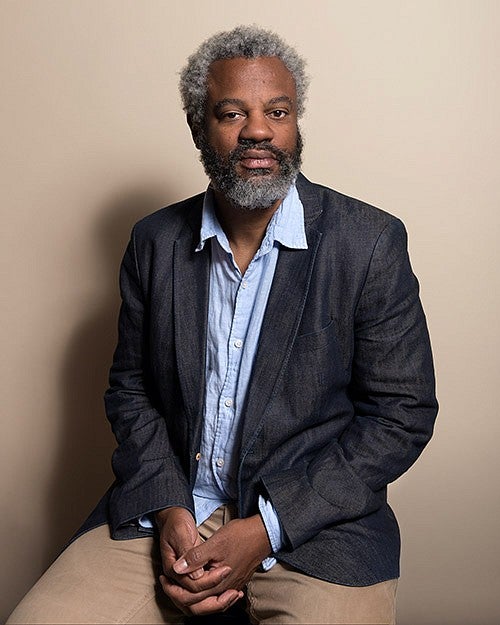
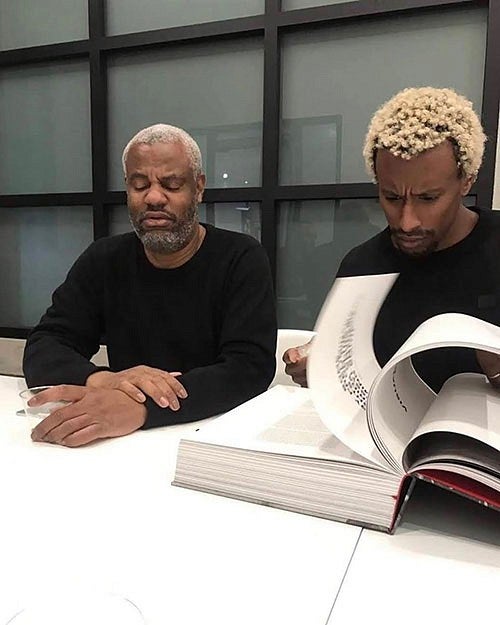
Hamza Walker and Mahfuz Sultan.
Glenn Adamson
“Craft in America: Real and Ideal”
Co-sponsored by the MFA Applied Craft + Design at PNCA
Thursday, April 8
Watch a video of Glenn Adamson's lecture
Drawing from his new book, Craft: An American History, Glenn Adamson will engage in conversation with Anya Kivarkis. They will discuss the implication of race, gender and class in US craft history, and focus particularly on the relationship between craft’s economic and material presence, and its rich symbolic dimension. There are important differences between real and ideal, yet each influences the other in a complex exchange.
Glenn Adamson is a curator, writer and historian based in New York. He has previously been Director of the Museum of Arts and Design; Head of Research at the V&A; and Curator at the Chipstone Foundation in Milwaukee. Adamson’s publications include Thinking Through Craft (2007); The Craft Reader (2010); Postmodernism: Style and Subversion (2011, co-edited with Jane Pavitt); The Invention of Craft (2013); Art in the Making (2016, co-authored with Julia Bryan-Wilson; and Fewer Better Things: The Hidden Wisdom of Objects (2018). His newest book is Craft: An American History, published by Bloomsbury, and he is co-host of the online interview series Design in Dialogue.
Alison Saar and Hank Willis Thomas
in conversation with Hamza Walker
Thursday, April 15
Watch a video of the Alison Saar and Hank Willis Thomas lecture
Alison Saar’s prints and paintings address issues of race, gender and spirit. She studied art and art history at Scripps College and received an MFA from the Otis Art Institute. Her awards include a John Simon Guggenheim Memorial Foundation Fellowship, National Endowment Fellowships, and the United States Artists Fellowship. Saar has exhibited at many museums, including the Hirshhorn Museum and Sculpture Garden and the Whitney Museum of American Art, Her art is represented in the collections of the Hirshhorn Museum and Sculpture Garden, the Metropolitan Museum of Art and the Whitney Museum of American Art. She currently resides in Los Angeles and is represented by L A Louver Gallery.
Hank Willis Thomas is a conceptual artist working primarily with themes related to perspective identity, commodity, media, and popular culture. His work is included in numerous public collections including the Museum of Modern Art in New York; the Solomon R. Guggenheim Museum, New York; the Whitney Museum of American Art, New York; the Brooklyn Museum, New York; the High Museum of Art, Atlanta, and the National Gallery of Art, Washington D.C. His collaborative projects include Question Bridge: Black Males, In Search Of The Truth (The Truth Booth), and For Freedoms, the first artist-run initiative for art and civic engagement. In 2017, For Freedoms was awarded the ICP Infinity Award for New Media and Online Platform. Thomas is also a recipient of the Guggenheim Fellowship (2018), the AIMIA | AGO Photography Prize (2017), the Soros Equality Fellowship (2017), and is a member of the New York City Public Design Commission. Thomas’ first comprehensive survey Hank Willis Thomas: All Things Being Equal…opened in the fall of 2019 at the Portland Museum of Art in Portland, OR and traveled to Crystal Bridges Museum of Art in Bentonville, AR (February 8 – July 13, 2020) and ended at the Cincinnati Art Museum in Cincinnati, OH (September 4–November 8, 2020).
Made possible by the Jordan Schnitzer Family Foundation and presented by the Department of Art, Center for Art Research, Jordan Schnitzer Museum of Art, and Ford Family Foundation Critical Conversations Program in conjunction with the exhibition of works by Hank Willis Thomas and Alison Saar from the Collection of Jordan D. Schnitzer at the JSMA, on view through June 14, 2021.

Alison Saar
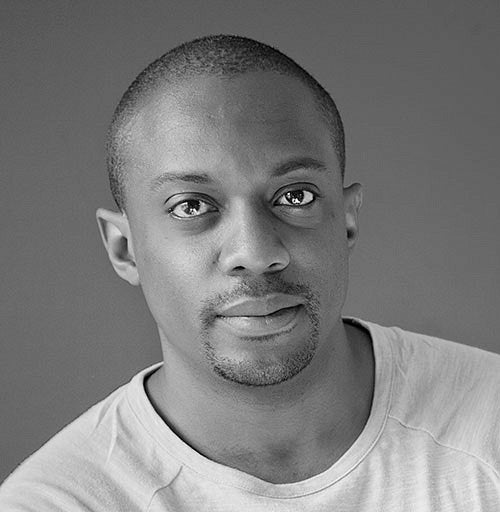
Hank Willis Thomas
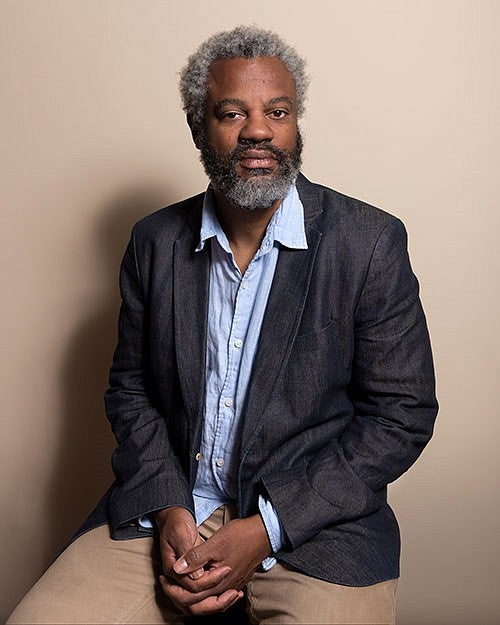
Hamza Walker
Rebecca Morris
“Artist Talk”
Thursday, April 22
Watch a video of the Rebecca Morris lecture
Rebecca Morris is an abstract painter whose work deeply investigates materials, form, processes, and outcomes. A showcase for her extensive arsenal of techniques and ideas, her ambitious large-scale canvases incorporate different manners of mark-making and inventively explore questions of frame dynamics and figure/ground illusions, often within a remarkably shallow pictorial space.
Rebecca Morris, b.1969 in Honolulu, Hawaii; lives in Los Angeles, California. BA, Smith College; MFA, The School of the Art Institute of Chicago; The Skowhegan School of Painting and Sculpture. She is a Professor in the Department of Art at the University of California, Los Angeles. Solo exhibitions include: Bortolami, NYC (2020); Blaffer Art Museum, Houston TX (2019); Mary Boone Gallery, NYC (2017); 356 S. Mission Rd, Los Angeles (2015); The Bonnefantenmuseum, The Netherlands (2014); Kunsthalle Lingen, Germany (2013); Galerie Barbara Weiss, Berlin (2017, 2013, 2009, 2006); Corbett vs. Dempsey, Chicago (2016, 2013); Harris Lieberman, New York (2012, 2010); The Renaissance Society, Chicago (2005); and Santa Monica Museum of Art (2003); forthcoming, ICALA, Los Angeles (2022). Group exhibitions include: “Made in LA” at the Hammer Museum, Los Angeles (2016); Whitney Biennial, NY (2014); Kunstmuseum St. Gallen, Switzerland; The Museum of Contemporary Art Los Angeles; Wexner Center for the Arts, Columbus, OH; Victoria Miro Gallery, London; Sammlung Goetz, Munich; David Zwirner Gallery, NYC; Galerie nächst St. Stephan, Vienna, Austria; The Hessel Art Museum at Bard College, Annandale-on-Hudson, NY; Museum of Contemporary Art, Chicago; Gavin Brown’s Enterprise, NYC; The Pit, CA. Morris was the recipient of a Guggenheim Fellowship, Tiffany Foundation; The California Community Foundation; The City of Los Angeles Individual Artist Award; The Durfee Foundation; Art Matters; and the Illinois Arts Council.
Amir Zaki
“Building & Becoming”
Thursday, May 6
Watch a video of the Amir Zaki lecture
Amir Zaki has an ongoing interest in the rhetoric of authenticity, as it is associated with photography as an indexical media. Simultaneously, he is deeply invested in exploring digital technology’s transformative potential to disrupt that assumed authenticity. However, his interest is not in utilizing digital trickery as illustration to undermine a photograph’s veracity. In fact, Zaki often creates hybridized photographs that carefully use the vocabulary of the documentary style so that the viewer’s belief in its veracity remains intact, at least initially. He constructs scenes that are somewhat off-register, ‘out of key’, and ever so slightly faux. He often uses the architectural and organic landscape of California as a subject, as it seems particularly appropriate to his process. This is largely because, either through media myth, reality or a combination of the two, the architecture and surrounding landscape in California is itself an evolving bastardization of styles and forms, in other words a pastiche. California is home to a collision of high modernist ideals, suburban McMansions, high-rise density, endless asphalt grids, deserts, mountains, beaches, Los Angeles urbanism, Inland Empire sprawl, Orange Curtain conservatism, the Crystal Cathedral, and the Integratron. It should be made clear that although Zaki is fascinated and inspired by this architectural and cultural entropy, his intention is not to record, replicate or simply document a preexisting postmodern pastiche. More precisely, his work begins with the familiar, by looking at objects, structures and locations that are often pedestrian and banal. And by capitalizing on the presumed veracity that photographs continue to command, along with the transformative, yet invisible digital alterations he employs, his images depict structures that that aspire to be added to the list of the hodge-podge built landscape that creates the California mythology.
Amir Zaki is a practicing artist living in Southern California. He received his MFA from UCLA in 1999 and has been regularly exhibiting nationally and internationally since. Zaki has had over 30 solo exhibitions at institutions and galleries including the Mak Center Schindler House, the Doyle Arts Pavilion, the Dalian Modern Museum (China), ACME gallery, Perry Rubenstein Gallery, James Harris Gallery, Edward Cella Art & Architecture, and Roberts Projects (formerly Roberts and Tilton). He has been included in over 50 group exhibitions in significant venues including The California Biennial: 2006 at the Orange County Museum of Art, the Whitney Museum of American Art in New York, Andreas Grimm Gallery in Munich, Germany, Harris Lieberman Gallery in New York, Flag Art Foundation in New York, Western Bridge in Seattle, Shane Campbell Gallery in Chicago, the California Museum of Photography, Museum of Photographic Arts in San Diego, the San Jose Museum of Art, and the Nevada Museum of Art. Zaki’s work is part of numerous public and private collections across the country including the Whitney Museum of American Art, New Museum of Contemporary Art, Los Angeles County Museum of Art (LACMA), UCLA Hammer Museum, the Henry Art Gallery in Seattle, Washington, the Orange County museum of Art, and the Santa Barbara Museum of Art. Zaki has three monographs, VLHV (2003), Eleven Minus One (2010) and California Concrete: A Landscape of Skateparks (2019). He has been included in a Phaidon Press anthology of contemporary photography called Vitamin Ph and contributed essays to LACMA’s groundbreaking text, Words Without Pictures. He has been included in both an Aperture anthology organized by Charlotte Cotton called Photography is Magic, which addresses a major technological shift in contemporary photographic practices, as well as the anthology entitled Both Sides of Sunset: Photographing Los Angeles.
Natalie Ball
“Power Objects”
Thursday, May 20, 4:00 p.m.
Natalie Ball was born and raised in Portland, Oregon. She has a Bachelor’s degree with a double major in Ethnic Studies and Art from the University of Oregon. She furthered her education in New Zealand at Massey University where she attained her Master’s degree, focusing on Indigenous contemporary art. Ball then relocated to her ancestral homelands to raise her three children. Her work has been shown nationally and internationally, including the Half Gallery, NY; Vancouver Art Gallery, BC; Blum & Poe, LA; Portland Art Museum, OR; Gagosian, NY; Seattle Art Museum, WA; Almine Rech Gallery, FR; and SculptureCenter, NY. Natalie attained her M.F.A. degree in Painting & Printmaking at Yale School of Art in 2018. She is the recipient of the 2020 Bonnie Bronson Award, 2020 Joan Mitchell Painters & Sculptors Grant, 2019 Pollock-Krasner Foundation Grant, and the 2018 Betty Bowen Award from the Seattle Art Museum.
Mario Ybarra Jr.
George and Matilda Fowler Lecture
“I Did It for Revenge!”
Thursday, May 27
Watch a video of the Mario Ybarra Jr. lecture
Mario will discuss some of his past projects and discuss the important role of the individual and collaborative artist in relationship to creating and in finding ways to tell one's family's stories and other marginalized narratives that have guided his artistic practice. He will engage audiences in creative strategies/tools for thinking and making Art.
Mario Ybarra Jr., is a visual and performance artist, educator, and activist who combines street culture with fine art in order to produce what he calls “contemporary art that is filtered through a Mexican-American experience in Los Angeles.” His work has been included in many group exhibitions, including Installations Inside/Out: Armory 20th Anniversary Exhibition, Armory Center for the Arts, Pasadena, California; San Juan Poly/Graphic Triennial of the Instituto de Cultura Puertorriqueña, San Juan, Puerto Rico; Phantom Sightings: Art After the Chicano Movement, Los Angeles County Museum of Art, Los Angeles, California; and Whitney Biennial, Whitney Museum of American Art, New York, New York (2008). He is co-founder of an artist run organization located in the Harbor area of Los Angeles, called Slanguage Studio (2002–present).
This lecture is made possible by the George and Matilda Fowler Endowment Fund.
The 2019–20 Department of Art Visiting Artist Lecture Series was made possible in part by the Davis Family Fund, the George and Matilda Fowler Endowment Fund, the Division of Equity and Inclusion, the Jordan Schnitzer Museum of Art, and Critical Conversations | Inside Oregon Art, a partnership between the Ford Family Foundation and the University of Oregon School of Art + Design Department of Art. Note: The Spring 2020 lectures were cancelled due to COVID-19.
Danny Orendorff
“Doing It Together: Queerness, Craft, Collectivity”
Thursday, October 10, 2019
Watch a video of the Danny Orendorff lecture
Surveying the past ten years of his curatorial work, Orendorff will explore the intersecting threads of DIY and/or craft-oriented cultural production, myriad histories of grassroots social-justice activism, and related theories of gender and sexuality that have together driven his research, exhibition and writing projects. From collectively-made queer videos and massive textile collaborations, to kink-inspired tableaux vivants and plein air paintings of banks on fire, Orendorff will detail past and present curatorial efforts that all pursue an aesthetic of non-normativity, cooperation, resistance and liberation.
Danny Orendorff is a curator and writer working as Executive Director of Vox Populi, a non-profit gallery, performance space and art collective in Philadelphia, PA. Founded in 1988, Vox Populi serves as an enduring model for how a radically independent and experimental arts organization can sustain itself through collective effort and constant evolution. Formerly, Orendorff was Curator of Public Programs for the Museum of Arts and Design in New York City and Program Director for non-profit Chicago gallery Threewalls. As an independent curator, Orendorff has organized large group exhibitions for such venues as DePaul Art Museum (Chicago, IL), The Center for Craft, Creativity & Design (Asheville, NC), SFCamerawork (San Franicsco, CA), and The Charlotte Street Foundation (Kansas City, MO), amongst others. He has taught in the Fiber & Material Studies Departments of The School of the Art Institute of Chicago and Tyler School of Art at Temple University.
Hank Willis Thomas
“All Things Being Equal...”
Monday, October 14, 2019
Watch a video of the Hank Willis Thomas lecture
Throughout his career, Hank Willis Thomas (American, born 1976) has addressed the visual systems that perpetuate inequality and bias in bold, skillfully crafted works. Through photographs, sculpture, video, and collaborative public art projects, he invites us to consider the role of popular culture in instituting discrimination and how art can raise critical awareness in the ongoing struggle for social justice and civil rights.
Hank Willis Thomas is a conceptual artist working primarily with themes related to perspective identity, commodity, media, and popular culture. His work is included in numerous public collections including the Museum of Modern Art in New York; the Solomon R. Guggenheim Museum, New York; the Whitney Museum of American Art, New York; the Brooklyn Museum, New York; the High Museum of Art, Atlanta, and the National Gallery of Art, Washington D.C. His collaborative projects include Question Bridge: Black Males, In Search Of The Truth (The Truth Booth), and For Freedoms, the first artist-run initiative for art and civic engagement. In 2017, For Freedoms was awarded the ICP Infinity Award for New Media and Online Platform. Thomas is also a recipient of the Guggenheim Fellowship (2018), the AIMIA | AGO Photography Prize (2017), the Soros Equality Fellowship (2017), and is a member of the New York City Public Design Commission.
This lecture is made possible by a grant from the Division of Equity and Inclusion, the Jordan Schnitzer Museum of Art and the Department of Art.
Nicholas Muellner
"Making Doubles"
Thursday, October 17, 2019
Watch a video of the Nicholas Muellner lecture
Muellner will present a scripted slide lecture based on the opening essay of his forthcoming book, “Lacuna Park: Essay and other Adventures in Photography”. Intertwining memoir, reportage, fiction and theory, Muellner’s newest work asks: what is existentially at stake today in the making and viewing of photographs?
Nicholas Muellner is an artist who operates at the intersection of photography and writing. Through books, exhibitions and slide lectures, his projects investigate the limits of photography as a documentary pursuit and as an interface to literary, political and personal narratives. His recent image-text books include The Photograph Commands Indifference (A-Jump Books, 2009) and The Amnesia Pavilions (A-Jump Books, 2011). His 2017 book, In Most Tides An Island (SPBH Editions, 2017), was shortlisted for the Aperture/Paris Photo Photobook of the Year Award, and he is a 2018 Guggenheim Fellow in Photography. He Co-Directs the Image Text MFA and Press at Ithaca College.
Angela Washko
“Poking the Hive: Interventions in Unusual Media Environments”
Thursday, November 14, 2019
Watch a video of the Angela Washko lecture
Artist and activist Angela Washko will present several different strategies for performing, participating in and transforming online environments that are especially hostile toward women. She will introduce her long-term performative intervention “The Council on Gender Sensitivity and Behavioral Awareness in World of Warcraft” alongside several interventions, interviews, performances, written works and video games works she has created about the manosphere and online men’s seduction communities. She will additionally introduce her newest project Workhorse Queen, a documentary film about drag queen and former RuPaul’s Drag Race contestant Mrs. Kasha Davis and her life and career post-reality-television.
Angela Washko is an artist, writer and facilitator devoted to creating new forums for discussions of feminism in spaces frequently hostile toward it. Since 2012, Washko has operated The Council on Gender Sensitivity and Behavioral Awareness in World of Warcraft, an ongoing intervention inside the most popular online role-playing game of all time. Washko's most recent project, The Game: The Game, is a video game in which professional pick-up artists attempt to seduce the player using their coercive and often dangerous signature techniques sourced from their instructional books and video materials. A recent recipient of the Impact Award at Indiecade, a Franklin Furnace Performance Fund Grant, and a Frank-Ratchye Fund for Art at the Frontier Grant, Washko's practice has been highlighted in The New Yorker, Frieze Magazine, Time Magazine, The Guardian, ArtForum, The Los Angeles Times, Art in America, The New York Times and more. Her projects have been presented internationally at venues including Museum of the Moving Image, Kiasma Museum of Contemporary Art, Los Angeles Museum of Contemporary Art, the Milan Design Triennale, the Shenzhen Independent Animation Biennial and the Rotterdam International Film Festival. Angela Washko is an Assistant Professor of Art at Carnegie Mellon University.
This lecture is made possible by the George and Matilda Fowler Endowment Fund.
Julie Rodrigues Widholm
Director and Chief Curator DePaul Art Museum, Chicago
"Expanding the Canon: A Call for Curatorial Activism in 21st Century Museum"
Critical Conversations | Inside Oregon Art
Thursday, November 21, 2019
Watch a video of the Julie Rodrigues Widholm lecture
Julie Rodrigues Widholm is Director and Chief Curator of DePaul Art Museum where she leads the strategic and artistic vision to promote equity and interdisciplinary education in art museums. Prior to taking the helm at DPAM in September 2015, she was Curator at the Museum of Contemporary Art. She has organized more than 100 solo and group exhibitions, including Julia Fish: bound by spectrum, Brendan Fernandes: The Living Mask, Barbara Jones-Hogu: Resist, Relate, Unite, Rashid Johnson: Message to Our Folks, Doris Salcedo, ;Unbound: Contemporary Art after Frida Kahlo, Escultura Social: A New Generation of Art from Mexico City, which have been presented at museums across the U.S. such as DePaul Art Museum, MCA Chicago, the Solomon R. Guggenheim Museum, Perez Art Museum Miami, the Nasher Museum at Duke University, MIT List Visual Arts Center, among others. She grew up in Brazil, Mozambique, Portugal, Germany, and across the U.S.
Namita Gupta Wiggers
“One Hundred Lifetimes and A Day”
Thursday, January 30, 2020
Watch a video of the Namita Gupta Wiggers lecture
“Research is both process and product, and I want to practice different ways of telling the story of how craft research fills my days—and lengthens my years—with you.
A colleague of mine showed me how he reads a forest, pointing out what shows itself now after 100 years of growth, and mapping a vision of what will come 100 years from now. It brought sculptor James Surls to my mind, who once said, "I make objects. It takes so long. It would take me a lifetime to build just what I can dream in one day. I want a hundred lifetimes and one day."
For a decade, my days were about making exhibitions in a craft museum. Today, my work is about research. I develop a low-residency graduate program focused on craft histories and theory, where a day’s work of teaching may not surface for years. Now, my writing lives mostly in words, not spatial essays—and is not so photogenic.”—Namita Gupta Wiggers, 2019
Namita Gupta Wiggers is a writer, curator, and educator based in Portland, OR. She is the Director of the recently launched Master of Arts in Craft Studies at Warren Wilson College, North Carolina. She is the Director and Co-Founder of Critical Craft Forum, and from 2004–14, Wiggers served as Curator and then Director and Chief Curator, Museum of Contemporary Craft, Portland, OR. Wiggers contributes regularly to online and in-print journals and books. She serves on the Editorial Boards of Garland magazine and Norwegian Crafts. Recent curatorial projects include: Across the Table, Across the Land with Michael Strand for the National Council on Ceramic Education in the Arts; Everything Has Been Material for Scissors to Shape, a textile-focused exhibition at the Wing Luke Museum of Asian American Experience, Seattle; a forthcoming publication with Wiley Blackwell Publishers; and Gender + Adornment, an ongoing research project with Benjamin Lignel. Wiggers is the Center for Art Research's inaugural writer-in-residence for 2019–20.
Julia Haft-Candell
“Building a Visual Vocabulary”
Thursday, February 20, 2020
Watch a video of the Julia Haft-Candell lecture
“I work intuitively and analytically, building from a conceptual groundwork that questions language, semiotics, identity and gender. Drawing influence from Philip Guston, Audre Lorde, Louise Bourgeois and Eva Hesse, my work uses humor and sensibilities of the handmade to critique systems of power and absurdities of existence. My most recent body of work expanded from a 2017 printed zine titled Glossary of Terms and Symbols in which I created personal definitions for historically symbolic forms, such as infinity symbols, arches and knots. The new sculptures refer to symbols of intersection, such as hands interlocking, a foot stomping on mud, or water slipping between fingers. They capture my reaction to current political situations, specifically feelings of frustration, struggle, and a search for empathy. I consider the trajectory of my work to be one continuous body evoking movement and motion through universal symbols to address an overarching primordial narrative.”
—Julia Haft-Candell, 2019
Julia Haft-Candell (b. 1982, Oakland, CA) received a BA from University of California, Davis before graduating from the MFA program at California State University, Long Beach in 2010. She spent a summer residency in 2016 at the Skowhegan School of Painting & Sculpture, Madison, ME, and has been awarded multiple grants from the Center for Cultural Innovation and most recently the California Community Foundation Fellowship in 2019. Haft-Candell has been included in numerous solo and group exhibitions nationally, and is represented by Parrasch Heijnen Gallery in Los Angeles.
Theo Triantafyllidis
“Escapism: The Boundaries of Virtual Space”
Thursday, March 5, 2020
In this lecture, artist Theo Triantafyllidis will present recent work together with a sneak peek in current projects and behind the scenes material. The focus of the presentation will be on the use of the game engine as an artistic tool and the construction of alternative realities, performative systems and open narratives.
Theo Triantafyllidis (b. 1988, Athens, GR) is an artist who builds virtual spaces and the interfaces for the human body to inhabit them. He creates expansive worlds and complex systems where the virtual and the physical merge in uncanny, absurd, and poetic ways. These are often manifested as performances, virtual and augmented reality experiences, games, and interactive installations. He uses awkward interactions and precarious physics to invite the audience to embody, engage with, and challenge these other realities. Through the lens of monster theory, he investigates themes of isolation, sexuality, and violence in their visceral extremities. He offers computational humor and AI improvisation as a response to the tech industry’s agenda. He tries to give back to the online and gaming communities that he considers both the inspiration and context for his work by remaining an active participant and contributor. He holds an MFA from UCLA, Design Media Arts and a Diploma of Architecture from the National Technical University of Athens. He has shown work in museums, including the Hammer Museum in LA and NRW Forum in Dusseldorf, DE and various galleries such as Meredith Rosen Gallery, the Breeder, Sargent’s Daughters, and Young Projects. He was part of Hyper Pavilion in the 2017 Venice Biennale and the 2018 Athens Biennale: ANTI-. Theo Triantafyllidis is based in Los Angeles.
2018–19 Visiting Artist Lecture Series
Fall 2018
October 11
October 18
October 25
November 1
November 6
Winter 2019
January 17
January 24
February 7
February 14
March 7
Spring 2019
Davis Family Lecture
April 25
Tuan Andrew Nguyen
“Not Seeing is Believing”
Thursday, October 4, 2018
Watch a video of Tuan Andrew Nguyen's lecture
Tuan Andrew Nguyen’s lecture will look at the idea of supernaturalisms as a form of resistance. Starting with a film he made with The Propeller Group called The Living Need Light, The Dead Need Music, Nguyen will trace this idea through two of his recent films and his newest film project for the Sharjah Biennial 2019.
Tuan Andrew Nguyen graduated from the Fine Arts program at the University of California, Irvine in 1999 and received his Masters of Fine Arts from The California Institute of the Arts in 2004. His work explores strategies of political resistance through ritual, the making of objects [both as testimony and as devotion], supernaturalism and the impact of mass media on these moments of resistance. In his continual attempts at reworking the power dynamics of public space and mass media in general, he initiated The Propeller Group in 2006, a platform for collectivity that situates itself between an art collective and an advertising company. He was also a co-founder and board member of Sàn Art, an artist-initiated exhibition space and educational program in Sai Gon, Viet Nam.
This lecture is made possible by the George and Matilda Fowler Endowment Fund.
This lecture is free and open to all.
Shana Moulton
“Welcome to Whispering Pines”
Thursday, October 11, 2018
Watch a video of Shana Moulton's lecture
Over the past 15 years Shana Moulton has been developing her ongoing video/performance series Whispering Pines, in which she plays the role of "Cynthia", both a fictional figure and the artist's alter ego. This talk will present a chronological-anecdotal outline of Moulton's work and forces that shaped it, with video and performance highlights.
Shana Moulton is a California born and based artist who works in video, performance, and installation. In 2002, she began the video series Whispering Pines, in which she performs as Cynthia, both an alter-ego and an avatar for the artist when she is alone. Moulton has had solo exhibitions at the Palais De Tokyo, Yerba Buena Center for the Arts, Fondazione Morra Greco, Kunsthaus Glarus, and a retrospective of work at The Museum of Fine Arts in St. Petersburg. She has performed and screened videos at MoMA, The New Museum of Contemporary Art, Performa 2009, The Kitchen, Art in General, The Andy Warhol Museum, SFMOMA, The Hammer Museum and Cricoteka, among many others. Her work is distributed by Electronic Arts Intermix and she is a featured artist on Art21’s New York Close Up.
This lecture is free and open to all.
Daniel Canty
“Extracts from Patience”
Thursday, October 18, 2018
Watch a video of Daniel Canty's lecture
Every work evolves a form. In this artist presentation, Daniel Canty will attempt to untangle some of the threads that course through his works. Mapping imbricated orbits, tracking transformations of scale, he will endeavour, through the telling, to expose the lines of force of his poetics, which takes the wonders of the written word as its starting point, and modulates their wavelength into a host of living forms. There will be talk of the fidelity to images, of mise en livreand electric art, naïve science and chains of chance, of the aesthetics of friendship and a very loose doctrine of cycles. He will try to expose how the poetics of language, of taking one thing for another, and coming up with something else, can lead one back into the thick of things, to touch the texture of time.
Daniel Canty is a writer, director and artist living in Montréal, Québec. He started producing works on the cusp of the new century. His directorial debut was an online adaptation of Alan Lightman’s fiction,Einstein’s Dreams, his first book, a history of automata in 19th century American literature. Since then, he has been creating a host of living forms, working at the crossroads of literature and bookmaking, film and theatre, the visual arts and design. His practice, which stems from the poetics of writing, and the ethics of directing, extends the written word’s wavelength to encompass a vast range of possibilities. He is fond of works that invent their own form. Over the years, he has written and devised an astonishing array of books and films, interfaces and exhibitions, and collaborated on such improbabilities as “transfrontier odysseys” or librettos for automata. He is steadfastly mapping a universe where the enchantments of language assert their import in the weave of time.
This lecture is free and open to all.
Shannon R. Stratton
“Meditations on Unmaking”
Thursday, October 25, 2018
Watch a video of Shannon R. Stratton's lecture
Shannon R. Stratton will present a lecture on work as a curator, founder of a visual arts not-for-profit and co-creator of multiple visual arts platforms. With a studio art background in fiber, Stratton will talk about how her craft training has informed her work as a curator/producer/administrator and how sometimes platforms need to be un-made in order to discover a new use-value.
Shannon R. Stratton is the William and Mildred Lasdon Chief Curator at the Museum of Arts and Design in New York. She has worked in the visual arts as an artist, writer, curator, professor, publisher and arts administrator with an emphasis on artist-run initiatives and concepts in contemporary craft. After completing her MFA in 2003 she co-founded the artist-run organization, Threewalls (Chicago), where she was artistic and then executive director for 12 years. At Threewalls, she organized exhibitions with over 100 artists; created The Propeller Fund award in collaboration with Gallery 400 for artist’s self-organizing; conceived and published 4 volumes of PHONEBOOK, a national guide to grass-roots and artist-run organizations across the US; and co-organized the first Hand-in-Glove conference which would lead to the founding of Common Field, a national organization in support of artist-focused organizations. In 2015 she left Threewalls to assume the role of Chief Curator at The Museum of Arts and Design in New York and pursue her interest in the future of craft. At MAD she has reimagined the artistic vision of the institution, programming the exhibition calendar, including curating eight exhibitions, from fall 2015 until present. She continues to organize exhibitions independently, with a particular research interest in expanded concepts of the self-taught and grass-roots cultural production.
This lecture is free and open to all.
Ebitenyefa Baralaye
“Fragments: Deconstructed Narratives, Forms, and Contexts”
Thursday, November 1, 2018
Watch a video of Ebitenyefa Baralaye's lecture
Narratives, objects and spaces are processed and understood through their parts. Whether deconstructing a life, a city, a tool, or a sentence, the fragmented nature of things both proceed and conclude cycles of identity and meaning. Ebitenyefa Baralaye will discuss his work and shifting narratives around the things we build, use, and break. Baralaye’s work explores overlaps in personal, spiritual, and cultural semiotics and considers how material, form, and context together mediate our sense of social and psychological presence.
Ebitenyefa Baralaye is a ceramist, sculptor, and designer. His work explores cultural, spiritual, and material translations in form/objects, text, and symbols interpreted through a diaspora lens and abstracted around the aesthetics of craft and design. Baralaye received a BFA in Ceramics from the Rhode Island School of Design and a MFA in Ceramics from the Cranbrook Academy of Art. Baralaye was an Emerging Artists Program recipient at the Museum of the African Diaspora in 2017 and recently an AICAD Teaching Fellow at the San Francisco Art Institute.
This lecture is free and open to all.
Alexandria Eregbu
“Finding Ijeoma: Entering the Marvelous Journey”
Tuesday, November 6, 2018
Watch a video of Alexandria Eregbu's lecture
For this lecture, Alexandria Eregbu walks us through her creative process as a multidisciplinary artist. She begins with her middle name, ‘Ijeoma’ an Igbo name that is traditionally given from Nigerian fathers to their daughters, meaning ‘safe or good journey.’ Here, Eregbu draws connections between personal, familial, and diasporic histories that have emerged within her artistic practice. In doing so, Eregbu further examines the role that origin stories and community storytelling have played in her commitment to narrative/world building—forums which the artist believes, lead to the preservation and empowerment of the individual and collective spirit. Topics addressed in this lecture include: 1.) Materiality + Textile Studies 2.) Visual Communication + Design in Nature 3.) West African Performance, Art, + Philosophy 4.) Surrealist Discourse + The Marvelous.
Alexandria Eregbu is a visual artist and independent curator. At her core, Alexandria is most passionate about re-imagining 21st century possibilities for creative practice through service and support structures that promote sustainability and accessibility for artists and communities engaging the arts. As an artist, her practice has illuminated pathways globally, nationally, and throughout the Midwest. She has held fellowships with ACRE (Steuben, WI); HATCH Projects, Stony Island Arts Bank, (Chicago, IL); The Center for Afrofuturist Studies (Iowa City, IA), Independent Curators International (New Orleans, New York City, Martinique); and The Camargo Foundation/3Arts Residency (France). Among her curatorial projects includes du monde noir, an artistically run collective which seeks to identify contemporary evidences of Surrealist activity produced by visual artists and writers of the African diaspora in the U.S. and abroad. Forthcoming projects include Oh, Heavenly Father, Mother Ocean, and Cosmic Seed…! her solo show at Ditch Projects in Eugene, OR.
This lecture is made possible in part by the Fibers Foundation. This lecture is free and open to all.
Julia Bryan-Wilson
“Bruce Nauman: Queer Homophobia”
Critical Conversations | Inside Oregon Art
Thursday, November 8, 2018
Julia Bryan-Wilson is the Doris and Clarence Malo Professor of Modern and Contemporary Art at the University of California, Berkeley; she is also the Director of the UC Berkeley Arts Research Center. She is the author of Art Workers: Radical Practice in the Vietnam War Era (2009); Art in the Making: Artists and Their Materials from the Studio to Crowdsourcing (2016); and Fray: Art and Textile Politics (2017), which was awarded the 2018 Robert Motherwell Book Prize. Bryan-Wilson’s influential writings on feminist and queer theory, craft histories, and contemporary art in the Americas have been widely published in venues that include Afterall, Artforum, Art Bulletin, Bookforum, differences, Grey Room, October, Oxford Art Journal, and Parkett, and she is the cocurator of the traveling exhibition Cecilia Vicuña: About to Happen.
Steffani Jemison
“Plant You Now, Dig You Later”
Thursday, January 17, 2019
Watch a video of Steffani Jemison's lecture
“I am an interdisciplinary artist who uses time-based, photographic, and discursive platforms to examine ‘progress’ and its alternatives. My current work uses transparency and opacity as material and metaphor, with a particular focus on the politics of privacy. Plant You Now, Dig You Later is a black vernacular phrase meaning ‘see you soon;’ it connects my interests in language, the archive, faith, and the future.” - Steffani Jemison, 2018
Steffani Jemison’s work has been exhibited nationally and internationally, including solo exhibitions and commissioned performances at MASS MoCA, Nottingham Contemporary, Jeu de Paume, the Museum of Modern Art, LAXART, the New Museum of Contemporary Art, and others. Her work is in the public collections of the Museum of Modern Art, the Whitney Museum, the Brooklyn Museum, the Studio Museum in Harlem, and Kadist. Jemison has completed many artist residencies and fellowships, including a Radcliffe Institute Fellowship at Harvard University, the Rauschenberg Residency, the Sharpe-Walentas Studio Program, Studio Museum in Harlem AIR, the Core Program at the Museum of Fine Arts Houston, and the Skowhegan School of Painting and Sculpture. Jemison holds an MFA from the School of the Art Institute of Chicago and a BA in Comparative Literature from Columbia University. She is an Assistant Professor at Mason Gross School of the Arts, Rutgers University and lives and works in Brooklyn, NY.
Megan Foster
“Illuminating”
Thursday, January 24, 2019
Watch a video of Megan Foster's lecture
Megan Foster’s work suggests a narrative by presenting a frozen moment in time. She aims to preserve and give authority to the everyday experience through a mix of art, architecture, design and science. Using appropriated images, film stills, magazine clippings and staged photographs as a starting point, she depicts banal scenes that have the potential to be spectacular and fantastic. She portrays often-overinflated expectations of the way we live and how we try to better ourselves from previous generations.
Megan Foster earned her BFA from RISD and her MFA from Columbia University. Her work has been included in exhibitions at Black and White Gallery, Brooklyn, NY; Mixed Greens Gallery, NYC; PS1 Contemporary Art Center, Long Island City, NY; Inside-Out Art Museum, Beijing, China; and the San Jose Museum of Art, San Jose, CA, among other venues. Before joining the faculty at RISD in the fall of 2016, Foster taught at The City College of New York where she was the head of Printmaking and director of the MFA program. She was also master printer at the LeRoy Neiman Center for Print Studies and is the co-founder of Moonlight Editions.
Whitney Hubbs
“Trials, Errors, and Some Successes!”
Thursday, February 7, 2019
Watch a video of Whitney Hubbs's lecture
With a 20-year history of picture making, Whitney Hubbs explores both straightforward and uncertain modes of image production. Educated as a traditional documentary photographer and as a conceptual artist examining the role of photographs, Hubbs brings a rigorous approach to her work. Her subject matter has included staged poems to the landscape, the figure in the landscape, self-portraits, and literal and abstract examinations of the female body.
Born and raised in Southern California with a brief stint in Portland, Oregon, Whitney Hubbs was involved in the punk rock riot grrrl community from a young age, where she made fanzines, organized art shows, participated in performances and worked as an activist. She later received her BFA from the California College of Arts in 2005 and an MFA at UCLA in 2009.
Hubbs has participated in group exhibitions at The J. Paul Getty Museum, Gallery Luisotti, and Shulamit Nazarian Gallery in Los Angeles, CA; The California Museum of Photography, Riverside, CA; Ballroom Marfa, Marfa, TX; Yancey Richardson Gallery, Fresh Window Gallery, and Situations Gallery in New York City, NY. Her book, Body Doubles, was published by Hesse Press (Los Angeles) in 2016, and in 2019 she will publish a book with Self Publish Be Happy. Hubbs is represented by M+B Gallery in Los Angeles and Situations Gallery in New York City. Hubbs is an Assistant Professor of Photography at Alfred University, Alfred, New York and lives and works in New York State.
Amy Franceschini
“Provisions… for Situations Yet to Come”
Thursday, February 14, 2019
Watch a video of Amy Franceschini's lecture
In this lecture, Amy Franceschini will present the work of Futurefarmers, an international group of artists, activists, farmers and architects with a common interest in creating frameworks of participation that recalibrate our cultural compass. She will discuss how their work uses various media to enact situations that disassemble habitual apparatus. Through public art, architecture, museum installations, publications and temporary educational programs inside institutions, they have transformed public policy, urban planning, educational curricula and public transportation plans. Futurefarmers’ work often creates relational sculptures and tools for audiences to gain insight into deeper fields of inquiry- not only to imagine, but also to participate in and initiate change in the places we live.
Amy Franceschini (b. 1970 Patterson, CA, US) lives and works in San Francisco and Gent, Belgium and is the founder of Futurefarmers. Amy received her BFA from San Francisco State University in 1992 and her MFA from Stanford University in 2002. Amy has taught as an adjunct and visiting professor in the graduate programs in art at California College for the Arts, Stanford University and San Francisco Art Institute since 2003. Her work has been exhibited at the Guggenheim Museum in New York, the Whitney Biennial in New York, MOMA, San Francisco Museum of Modern Art, The Canadian Center for Architecture in Montreal, the 2014 Venice Architectural Biennale, the 2017 Sharjah Biennale, the 2018 Taipei Biennale and she is the recipient of a 2010 Guggenheim Fellowship, 2017 Herb Alpert Award for Visual Arts and a 2019 Rome Prize Fellow in Design.
This lecture is made possible in part by the Departments of Art, English/Moore Fund, and Landscape Architecture.
Shadi Harouni
“Of Myth and Monument”
Thursday, March 7, 2019
Shadi Harouni will consider the metaphysics of hope alive in contested bodies, forbidden objects and forgotten histories. Her lecture looks at mountain and monument, both erected and imagined, as sites of humor and resistance, forgetting and despair. She will discuss the development of her practice and recent completed, ongoing and failed projects.
Shadi Harouni is an artist based in New York and Tehran. Harouni's practice ranges from site-specific interventions and sculptures, to printmaking, photography and film. Her research is centered on disavowed and marginalized histories of dissent and resistance, chiefly in the Middle East. Harouni’s projects have been exhibited at Queens Museum (NY), Kunstmuseum Bonn (DE), Prague City Gallery (CZ), University of Toronto (CA), Fondazione Ratti (IT), Elizabeth Foundation for the Arts (NY). Her work has been featured in Art Forum, The New York Times, The Guardian, Flash Art and Mousse, among others. She has been awarded a Gattuso Prize for Outstanding Exhibition, Harpo Foundation Grant for Artists, AIR Fellowship, residencies at Skowhegan (ME), SOMA (MX), LES Printshop (NY). Harouni holds an MFA from NYU (2011) and a BA from University of Southern California (2007). She serves as Visiting Assistant Professor and Director of the Undergraduate Program in Studio Art at New York University, Steinhardt.
Pope.L
Davis Family Lecture
"Until Now"
Thursday, April 25, 2019
Pope.L will present a compact survey of several strands in his art practice to-date. Pope.L (b. 1955, Newark) is a visual artist and educator whose multidisciplinary practice uses binaries, contraries and preconceived notions embedded within contemporary culture to create art works in various formats, for example, writing, painting, performance, installation, video and sculpture. Building upon his long history of enacting arduous, provocative, absurdist performances and interventions in public spaces, Pope.L applies some of the same social, formal and performative strategies to his interests in language, system, gender, race and community. The goals for his work are several: joy, money and uncertainty— not necessarily in that order.
Pope.L is represented by Mitchell-Innes & Nash, Susanne Vielmetter Los Angeles Projects, University of Chicago, Chicago
This lecture is made possible by the Davis Family Endowed Fund in Art.
2017–18 Visiting Artist Lecture Series
Fall 2017
October 5
October 12
October 19
October 26
November 14
Winter 2018
January 18
February 8
February 22
March 8
Spring 2018
April 12
To Be Rescheduled
April 26
May 10
May 17
May 24
James Lavadour
“The Properties of Paint and Painting as a Ledger of Time”
October 5, 2017
Watch a video of James Lavadour's lecture
This lecture is made possible in part by the the Gordon W. Gilkey Endowed Fund and co-hosted by the Department of the History of Art and Architecture.
“Every morning I walk to the studio before the sun comes up. Five years ago, on that walk, a meteorite streaked overhead and lit everything like day. It was a terrifying and wonderful moment. Painting is that same experience. The bits and details of that flash of brilliant clarity would pass by if not for the practice of painting. A painting is a structure for the extraordinary and informative events of nature that are otherwise invisible.” – James Lavadour, 2013
Born in 1951, James Lavadour is one of the Northwest’s most revered living painters. Lavadour’s family are descendants of the Walla Walla tribe of the modern day Confederated Tribes of the Umatilla Indian Reservation. He has lived his life in Northeastern Oregon where he is an enrolled tribal member and has lived and worked on the reservation for the past 38 years. His sense of service and commitment to the tribal community have lead him to work for the tribal government in education, housing, alcohol and drug treatment, and natural resource management. In 1993 Lavadour and a group of supporters founded Crow’s Shadow Institute for the Arts, a not for profit print studio/arts organization that provides a creative conduit for social, economic, and educational opportunities to Native Americans through artistic development.
James Lavadour’s work was featured as one of only 102 artists selected for the Crystal Bridges Museum of American Art’s seminal survey exhibition, State of the Art: Discovering American Art Now and at the 55th Venice Biennale in Personal Structures.
His works are included in the collections of the Smithsonian National Museum of the American Indian, Washington DC; the Crystal Bridges Museum of American Art, Bentonville, AK; the Seattle Art Museum, Seattle, WA; the Portland Art Museum, Portland, OR; the Tacoma Art Museum, Tacoma, WA; the Boise Art Museum, Boise, ID; the Eiteljorg Museum, Indianapolis, IN; the Hallie Ford Museum, Salem, OR; the Hood Museum, Hanover, NH; Bank of America, San Francisco, CA; the Microsoft Corporation, Redmond, WA as well as numerous private collections.
William Powhida
“After the Contemporary”
October 12, 2017
Watch a video of William Powhida's lecture
William Powhida will discuss his recent show “After the Contemporary” at the Aldrich Contemporary Museum of Art. The exhibition was the artist’s first museum solo show and offered a fictive survey of The Contemporary, a period of art history from 2000–2025 defined by the expansion of the art market. The exhibition also included a retrospective of the artist’s works from 2004–2047, made possibly by the 2050 setting of the exhibition. The lecture will cover works included in the show as well previous exhibitions and projects that informed “After the Contemporary”.
William Powhida makes fun of the art world to highlight the paradoxes and absurdities of economic and social value systems that keep the sphere of visual art afloat on a tide of inequality. His work relies on research and participation to diagram, list, perform and critique the forces that shape perceptions of value. He is responsible or partly responsible for exhibitions including "Overculture" at Postmasters Gallery, "Bill by Bill" at Charlie James Gallery, "POWHIDA" at Marlborough Gallery and "#class" at Winkleman Gallery.
Powhida is also an infrequent contributor to ArtFCity and Hyperallergic on issues that alarm him. His complicit criticism has been rewarded with gallery representation, numerous exhibitions and critical debate. He was born in 1976 in upstate New York and still lives and works in New York City despite the crushing cost of living and working. He is represented by Postmasters Gallery in New York, Charlie James Gallery in Los Angeles, Gallery Poulsen in Copenhagen, and Platform Gallery in Seattle.
Stanya Kahn
George and Matilda Fowler Lecture
October 19, 2017
Stanya Kahn is an interdisciplinary artist working primarily in video with a practice that includes performance, writing, sound, drawing, painting and ceramics. Humor, pathos and the uncanny emerge as central modes in a hybrid media practice that seeks to re-work relationships between fiction and document, the real and the hyper-real, satire and sincerity, narrative time and the synchronic time of impulse.
Kahn is a 2012 Guggenheim Fellow in Film/Video. Recent exhibitions include Marlborough Contemporary, NY; Susanne Vielmetter, Los Angeles; Weiss Berlin; Cornerhouse, Manchester, UK; the New Museum, New York, NY; and the Brooklyn Academy of Music, New York. She has shown at the Hammer Museum, Los Angeles; the Museum of Contemporary Art, San Diego, CA; the2010 California Biennial; and Rodeo, London, UK recently. Her collaborative work with Harry Dodge has shown at Elizabeth Dee Gallery, New York; the 2008 Whitney Biennial; the Sundance Film Festival; the Museum of Contemporary Art, Los Angeles; the Museum of Modenr Art, New York; ZKM Karlsrühe; among others. She was a contributing writer, performer and costumer on the feature film By Hook or By Crook. Her writings and drawings are in multiple publications including Die Laughing (2nd Cannons Publications), It's Cool, I'm Good (Cornerhouse Publications), Abstract Video (University of California Press), among others.
Nancy Shaver
“50 Years: Learning to Be an Artist”
October 26, 2017
Watch a video of Nancy Shaver's lecture
“I am an artist, and collector of visual sensation. Observation, for me, is a critical tool for identifying spaces between mass culture and the individual. Daily errands, chores, and daily exchanges for carrying out getting from A to B are the vehicle for examination. For me, art takes place in these gaps. Specific gaps which define a present situation, personal or global which is always moving. Moving fast, out of grasp, constant flowing information, changing always. Art, for me, happens in conjunction with decoration, and is always fighting decoration. The activity of the agreement of art and decoration, or the battle of it are truly engaging for me.” - Nancy Shaver
Nancy Shaver is faculty at the Milton Avery School of Graduate Studies, Bard College. Shaver's work was presented in a solo show at Derek Eller Gallery in summer 2016. She has been part of the Greater New York show 2015 MoMA PS 1, Queens, NY as well as in Robert Gober's "The Heart Is Not a Metaphor" at MoMA, New York, NY. She currently has work in VIVA ARTE VIVA! the 57th Venice Biennale 2017. She has received a Guggenheim Foundation Fellowship, Louis Comfort Tiffany Award, and Anonymous Was A Woman award. She has been in collaboration with Maximilian Goldfarb and Allyson Strafella to present art in an experimental viewing station in Hudson, New York called Incident Report for the last 10 years.
Shaver lives and works in Jefferson and Hudson, New York.
Jan Verwoert
“Live Through This: The Fate of Public Voices”
November 14, 2017
Watch a video of Jan Verwoert's lecture
Jan Verwoert will address the existential condition of critical writing. "The model of one person passing judgment on others has become ridiculous,” he says. "Art, life, politics—we're in it together after all, even and especially now that societies are forcefully split. What does it take for a voice to articulate intuitions and observations in a manner that allows for very different people to relate to a public thinking process? Urban satire can do it. Is this because laughing at the state of the world awakens a sense of grotesque, yet fateful connectedness?"
Jan Verwoert is a critic and writer on contemporary art and cultural theory, based in Berlin. His writing has appeared in different journals, anthologies and monographs. He teaches at the Piet Zwart Institute Rotterdam. He is a professor for theory at the Oslo National Academy of the Arts and guest professor at the UdK Graduate School, Berlin. He is the author of Bas Jan Ader: In Search of the Miraculous, MIT Press/Afterall Books 2006, the essay collection Tell Me What You Want What You Really Really Want, Sternberg Press/Piet Zwart Institute 2010, together with Michael Stevenson, Animal Spirits — Fables in the Parlance of Our Time, Christoph Keller Editions, JRP, Zurich 2013, a second collection of his essays Cookie! published by Sternberg Press/Piet Zwart Institute 2014 and editor of the anthology on artistic knowledge No New Kind of Duck — Would I know how to say what I do?, Diaphanes & UdK Graduate School, Zurich-Berlin 2016.
Jenni Sorkin
"California Soul: The Vessel Tradition in the Work of Peter Voulkos and June Schwarcz”
January 18, 2018
Watch a video of Jenni Sorkin's lecture
Jenni Sorkin is Associate Professor of Contemporary Art History at University of California, Santa Barbara. She holds a PhD in the History of Art from Yale University.
Sorkin writes on the intersection between gender, material culture, and contemporary art. Her book, Live Form: Women, Ceramics and Community was published by University of Chicago Press in 2016. She has also published widely as an art critic, and her writing has appeared in Artforum, Art Journal, Art Monthly, NU: The Nordic Art Review, Frieze, The Journal of Modern Craft, Modern Painters, and Third Text. She has written numerous in-depth catalog essays on feminist art and material culture topics, and lectures nationally and internationally.
Special thanks to the Department of the History of Art and Architecture for their support.
Wendy Red Star
“A Selection of Works”
February 8, 2018
Watch a video of Wendy Red Star's lecture
Artist Wendy Red Star will present a chronological look at major past works starting in 2006 to 2017. Red Star works across disciplines to explore the intersections of Native American ideologies and colonialist structures, both historically and in contemporary society. Raised on the Apsáalooke (Crow) reservation in Montana, Red Star’s work is informed both by her cultural heritage and her engagement with many forms of creative expression, including photography, sculpture, video, fiber arts, and performance. An avid researcher of archives and historical narratives, Red Star seeks to incorporate and recast her research, offering new and unexpected perspectives in work that is at once inquisitive, witty and unsettling. Intergenerational collaborative work is integral to her practice, along with creating a forum for the expression of Native women’s voices in contemporary art.
Red Star has exhibited in the United States and abroad at venues including the Metropolitan Museum of Art, Fondation Cartier pour l’ Art Contemporain, Domaine de Kerguéhennec, Portland Art Museum, Hood Art Museum, St. Louis Art Museum, and the Minneapolis Institute of Art, among others. She served a visiting lecturer at institutions including Yale University, the Figge Art Museum, the Banff Centre, National Gallery of Victoria in Melbourne, Dartmouth College, CalArts, Flagler College, Fairhaven College, and I.D.E.A. Space in Colorado Springs. In 2015, Red Star was awarded an Emerging Artist Grant from the Joan Mitchell Foundation. In 2016, she participated in Contemporary Native Photographers and the Edward Curtis Legacy at the Portland Art Museum, and recently mounted a solo exhibition as part of the museum’s APEX series. Red Star holds a BFA from Montana State University, Bozeman, and an MFA in sculpture from University of California, Los Angeles. She lives and works in Portland, OR.
This lecture is made possible in part by the Gordon W. Gilkey Endowed Fund, the Department of Art, the Department of the History of Art and Architecture, and the Jordan Schnitzer Museum of Art.
Stanley Wolukau-Wanambwa
“Scenes from ‘One Wall a Web’”
February 22, 2018
Stanley Wolukau-Wanambwa will lecture about intersections between pictures and words. Wolukau-Wanambwa is a photographer, writer and teacher based in New York City. He is the former editor of the contemporary photography website The Great Leap Sideways (2011—2017), contributed essays to catalogues and monographs by Vanessa Winship, George Georgiou, and Paul Graham, was an artist-in-residence at Light Work, guest edited the Aperture Photobook Review, and wrote for Aperture, FOAM magazine and The Photographer’s Gallery.
Wolukau-Wanambwa has a BA in Philosophy & French from Oxford University, UK and an MFA in Photography from Virginia Commonwealth University. His photographic work addresses questions of patriarchy, race, history, and identity.
Karthik Pandian
“Language as Sneeze”
March 8, 2018
Karthik Pandian will touch on the involuntary in art and how it has inflected his work from monument to animal choreography. Pandian makes works in moving image, sculpture and performance. He has held solo exhibitions at the Whitney Museum of American Art; Bétonsalon, Paris, Midway Contemporary Art, Minneapolis and White Flag Projects, St. Louis, amongst others.
His work was featured in the inaugural LA Biennial at the Hammer Museum and La Triennale: Intense Proximity at the Palais de Tokyo as well as in group exhibitions such as Adventures of the Black Square: Abstract Art and Society 1915-2015, at Whitechapel Gallery; Film as Sculpture at Wiels Contemporary Art Centre, Brussels; and the 4th Marrakech Biennial, Higher Atlas. He has recently been touring his first stage performance – a collaboration with choreographer Andros Zins-Browne – at theaters throughout the US and Europe.
Pandian holds an MFA from Art Center College of Design and a BA from Brown University. In 2011, he was the recipient of a Louis Comfort Tiffany Foundation Award. Pandian is currently Assistant Professor of Visual and Environmental Studies at Harvard University, Cambridge, MA.
Mike Andrews
“Weird Wars and Other Battles”
April 12, 2018
Watch a video of the lecture by Mike Andrews
Mike Andrews is an Adjunct Professor in the Department of Fiber and Material Studies at the School of the Art Institute of Chicago and is the Executive and Creative Director at the Ox-Bow School of Art and Artists’ Residency. Andrews received a BFA from SAIC and MFA from Cranbrook Academy of Art.
Fueled by dynamic relationships between bright and dull colors, hard and soft materials and a range of scale, his sculptures and tapestries pointedly occupy the gallery. His work is informed by the grandeur of historical tapestries, non-representational abstract painting, and the delirium of home craft. His tapestries simultaneously function as both object and image.
Shana Moulton
“Welcome to Whispering Pines”
Due to unforeseen circumstances, this lecture has been canceled. We apologize for the inconvenience.
Over the past 15 years Shana Moulton has been developing her ongoing video/performance series Whispering Pines, in which she plays the role of "Cynthia", both a fictional figure and the artist's alter ego. This talk will present a chronological-anecdotal outline of Moulton's work and forces that shaped it, with video and performance highlights.
Shana Moulton lives and works near Yosemite, California. Moulton has had solo exhibitions or performances at The New Museum, SFMOMA, MoMA P.S.1, Performa 2009, The Kitchen, Electronic Arts Intermix, Art in General, The Andy Warhol Museum, The Migros Museum in Zurich, The Palais de Tokyo in Paris and the Times Museum in Guangzhou. Moulton's work has been reviewed in the Village Voice, Artforum, the Brooklyn Rail, the New York Times, Artnet Magazine, Frieze Magazine, Art Review, Artpress and Flash Art. She is a featured artist at Electronic Arts Intermix and Art21.
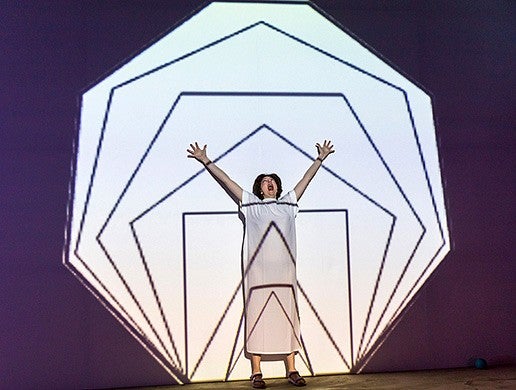
Parcours Night, Office approx 21 x 14 cm-ABB17, Shana Moulton, PR, 0018, Courtesy of Art Basel.
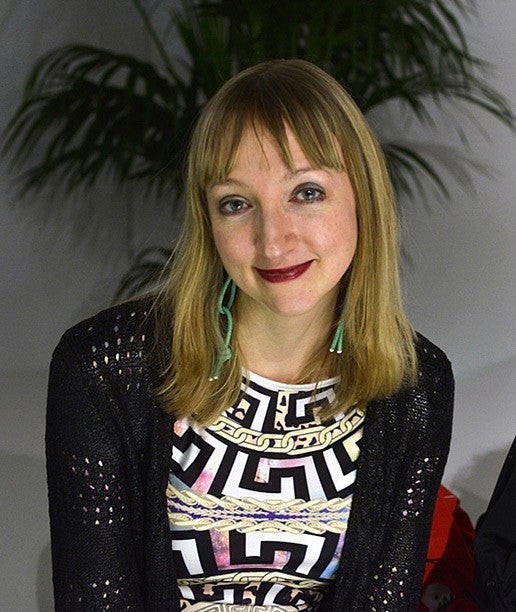
Shana Moulton
Anna Sew Hoy
Davis Family Lecture
“Psychic Body Grotto and Sculpture Outdoors”
April 26, 2018
Anna Sew Hoy lives and works in Los Angeles. She has produced solo projects at the Aspen Art Museum in 2015 and the San Jose Museum of Art in 2011. She has exhibited at the Hammer Museum, LAXART, and Various Small Fires, Los Angeles; Koenig & Clinton, NY; and the 2008 California Biennial among others. Her work is in the collections of the Hammer Museum, SFMOMA, LACMA, and the Museum of Contemporary Art in San Diego. Sew Hoy was awarded a Creative Capital Grant for Visual Arts in 2015, the California Community Foundation Grant for Emerging Artists in 2013 and the United States Artists Broad Fellowship in 2006.
Sew Hoy received her MFA from Bard College in 2008.
This lecture is made possible by the Davis Family Fund.
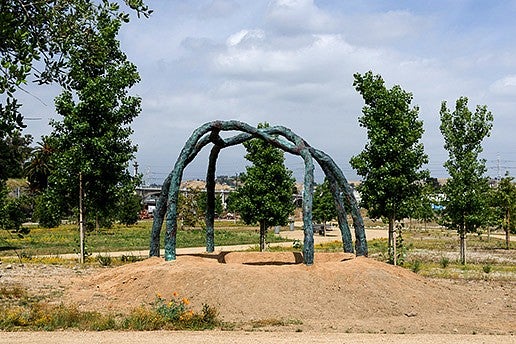
Psychic Body Grotto, 2016, Credit: Photo by Jeff Mclane.

Anna Sew Hoy. Photo by Hedi Slimane.
Crystal Z Campbell
“Lost and Found: The Work of Art in the Age of Digital Regret”
May 10, 2018
Watch a video of Crystal Z Campbell's lecture
Crystal Z Campbell considers the internet as the site in which everything and nothing can be erased––prompting questions about what stories these digitally curated remains can reveal for progeny. Campbell's creative practice uses found footage or historical references, often gleaned from both tangible archives and internet sources. These narratives of yesteryear are often processed through film, light, sound, performance, installation, ceramics, painting, writing, and community projects to interrogate present notions of justice and the politics of witnessing. Most recently, Campbell has investigated Henrietta Lacks' immortal cell line, the 1921 Tulsa Race Massacre, and gentrification. Campbell uses art as a tool for transmitting historical memory, time-travel, and proposing social change.
Crystal Z Campbell is an interdisciplinary artist and writer of African-American, Filipino & Chinese descents. Campbell's work has been exhibited and screened internationally: ICA Philadelphia (US), Artericambi (IT), Artissima (IT), Studio Museum of Harlem (US), Futura Contemporary (CZ), Project Row Houses in Texas (US), Children's Museum of San Diego (US), Art Rotterdam (NL), de Appel Arts Centre (NL) and SculptureCenter (US) amongst others. Selected honors and awards include Pollock-Krasner MacDowell Colony Fellow, Skowhegan School of Painting and Sculpture, Rijksakademie van beeldende Kunsten, Whitney Museum's Independent Study Program Van Lier Fellowship, Sommerakademie Paul Klee, Amsterdam Fonds voor de Kunst, Mondriaan Fonds, Fondazione Ratti and a recent Smithsonian Fellowship. Campbell is a currently a second-year Tulsa Artist Fellow in Tulsa, Oklahoma.
Morehshin Allahyari
“On Digital Colonialism and Monstrosity”
May 17, 2018
Morehshin Allahyari is an artist, activist, educator, and occasional curator. She is the recipient of the leading global thinkers of 2016 award by Foreign Policy magazine. Allahyari was born and raised in Iran and moved to the United States in 2007. Her work deals with the political, social, and cultural contradictions we face every day. She thinks about technology as a philosophical toolset to reflect on objects and as a poetic means to document our personal and collective lives struggles in the 21st century.
Allahyari is currently an artist in residence at Eyebeam’s one-year Research Residency (2016–2017) in NYC where she is developing a new body of work on Digital Colonialism and ‘re-Figuring’ as a Feminism and de-colonialism practice, using 3D scanners and 3D printers as her tools of investigation. Researching dark goddesses, monstrous, and djinn female figures of Middle-Eastern origin, Allahyari devises a narrative through practices of magic and poetic-speculative storytelling, re-appropriation of traditional mythologies, collaging, meshing, scanning, and archiving.
Allahyari has been part of numerous exhibitions, festivals, and workshops around the world including Venice Biennale di Archittectura, Museum of Contemporary Art in Montreal, Tate Modern, Queens Museum, Pori Museum, Powerhouse Museum, Dallas Museum of Art, Jeu de Paume, Contemporary Arts Museum of Houston, Museum für Angewandte Kunst. She has been an artist in residence at BANFF Centre (2013), Carnegie Mellon University’s STUDIO for Creative Inquiry (2015), Autodesk Pier9 Workshop in San Francisco (2015), and the Vilém Flusser Residency Program for Artistic Research in association with Transmediale, Berlin (2016). Her work has been featured in the New York Times, Huffington Post, Wired, National Public Radio, Parkett Art Magazine, Frieze, Rhizome, Hyperallergic, and Al Jazeera, among others.
Sabrina Ratté
“Machine for Living”
May 24, 2018
Watch a video of Sabrina Ratté's lecture
“The lecture will focus on my most recent video work contextualized within the evolution of my process over the years. I will present an overview of different inspirations, discuss my approach with analog and digital video, reflect on the potential extension of video in the context of presentation, and I will talk about the different themes contained into my work such as architecture, utopia and dystopia, the real and the virtual.” - Sabrina
Sabrina Ratté is a video artist based in between Montreal and Paris. Her practice investigates virtual environments generated by analog technologies. Electricity, as raw material, is sculpted, transformed and altered digitally to be reborn as luminous and vibrating architectures. Her videos exist between abstraction and figuration, utopia and dystopia, architecture and landscape.
Her works include installations, prints, sculptures and live performances. Previous exhibitions: Dolby Gallery (San Francisco), Young Project Gallery (Los Angeles), Whitney Museum of Art (NYC), Paddles On! 1st Digital Art Auction at Phillips (New York), HEK (Basel), EMPAC (Troy), Museum of the Moving Image (New York), International Digital Arts Biennal - Bian (Montreal), PHI Center (Montreal), Arsenal (Mtl), the Lampo series (Chicago), Atonal Festival (Berlin), Elektra, MUTEK (Mtl, Mexico, Barcelona). She is represented by the Laffy Maffei Gallery in Paris.
Special thanks to the Department of Cinema Studies for their support.
2016–17 Visiting Artists
October 6
October 13
October 20
October 27
November 3
November 10
November 17
January 17
January 26
February 2
February 9
February 16
February 23
February 27
March 9
Ruby Neri
"Ceramics"
Thursday, October 6, 2016
Watch a video of Ruby Neri's lecture
In her sculptural practice, Ruby Neri embraces a broad spectrum of figuration, drawing upon idiosyncratic 20th century West Coast traditions as well as a global catalogue of art historical and anthropological modes. Over the course of the last two decades she has moved fluidly from one material to another, including plaster, metal, and paint, to generate highly personal works of emotional immediacy often focused on the representations of the female form. Highlighting the tactility of clay, she builds each sculpture's curvaceous silhouette by hand, forming irregular walls and organic extensions. Her figurative airbrushed glazing, introduces lightness and improvisation to forms that otherwise display physical density and permanence, as well as recalls the street art she produced as a leading member of the San Francisco-based Mission School in the early 2000s and connects a 21st century urban art form to the archaic power of pre-historical wall-painting and object-making.
Ruby Neri (b. 1970, San Francisco) has participated in numerous exhibitions, including most recently Villa of Mysteries, Los Angeles Museum of Art (2016); Napa Valley Collects, Napa Valley Museum, Yountville, California (2016); NO MAN'S LAND: Women Artists from the Rubell Family Collection, Rubell Family Collection, Miami (2015); Fertile Ground: Art and Community in California, Oakland Museum of California in collaboration with the San Francisco Museum of Modern Art (2014); The Oracle, The Underground Museum, Los Angeles (2014); Energy That is All Around: Mission School, Grey Art Gallery, New York University, and San Francisco Art Institute (2013-14); The Possible, Berkeley Art Museum and Pacific Film Archive, University of California (2014); Busted, High Line Art, New York (2013); and Made in L.A. 2012, Hammer Museum, Los Angeles (2012). Neri lives and works in Los Angeles.
Stephanie Syjuco
"Practicing in Public: Artistic Agency within Global Collaborative Contexts"
Thursday, October 13, 2016
Watch a video of Stephanie Syjuco's lecture
Stephanie Syjuco creates large-scale spectacles of collected cultural objects, cumulative archives, and temporary vending installations, often with an active public component that invites viewers to directly participate as producers or distributors. Using critical wit and collaborative co-creation, her projects leverage open-source systems, shareware logic, and flows of capital, in order to investigate issues of economies and empire. This has included starting a global collaborative project with crochet crafters to counterfeit high-end consumer goods, presenting parasitic art counterfeiting events, and developing alternative vending economies. She will present several key projects that activate both global and national contexts, and touch on social practice as a means to promote public knowledge sharing in an era of increased privatization.
Born in the Philippines, Syjuco received her MFA from Stanford University and BFA from the San Francisco Art Institute. She is the recipient of a 2014 Guggenheim Fellowship Award and a 2009 Joan Mitchell Painters and Sculptors Award. Her work has been shown nationally and internationally, and included in exhibitions at MoMA/P.S.1, the Whitney Museum of American Art, The San Francisco Museum of Modern Art, ZKM Center for Art and Technology, the California Biennial at the Orange County Museum of Art, The 12th Havana Bienal, The 2015 Asian Art Biennial (Taiwan), among others. A long-time educator, she has taught at Stanford University, The California College of the Arts, The San Francisco Art Institute, Carnegie Mellon University, and most recently joined the faculty at the University of California at Berkeley in January 2014 as an Assistant Professor in Sculpture. She lives and works in Oakland, California.
Benjamin Levy
"Technically Conceptual / Conceptually Technical: Stanley William Hayter and the Atelier 17"
Thursday, October 20, 2016
Watch a video of Benjamin Levy's lecture
Calder, Miró, Kandinsky, Masson, Picasso, Nevelson, Bourgeois, Pollock. These are just a few of the names of the myriad artists associated with the Atelier 17, the collaborative print workshop founded by Stanley William Hayter in 1927 in Paris. Hayter would come to have an enormous effect on modern printmaking through not only his own work, but also through the workshop. The story of the Atelier 17 bridges the gap between pre- and post-WWII art, encompassing Surrealism and Modernism through Abstract Expressionism and beyond. The Atelier moved with the art world to New York from Paris, bringing with it an international and intergenerational group of artists. This melting pot of creative minds innovated and experimented both conceptually and technically with a profound emphasis on collaboration. Hayter was the nucleus around which artists investigated ideas, pedagogy, and technical innovations, and whose legacy paved the way for the post-war print boom.
Benjamin Levy is a curator, print scholar, and printmaker. He is currently the Assistant Curator of Collections and Academic Programs at the Henry Art Gallery at the University of Washington. Previously he was in the Prints, Drawings & Photographs Department at the Baltimore Museum of Art. While in Baltimore he co-directed the Baltimore Fair for Contemporary Prints and was a contributor to BmoreArt Magazine. A graduate of the Maryland Institute College of Art in Printmaking and Book Arts, he trained as a collaborative master printer. He is a contributor for Art in Print, sits on the board of the Tamarind Institute of Lithography, and is currently involved with a catalog and traveling exhibition of the work of Stanley William Hayter and his workshop, the Atelier 17.
John Divola
"The Landscape and Things in the Way"
Thursday, October 27, 2016
Watch a video of John Divola's lecture
John Divola is a contemporary visual artist who works in photography, describing himself as exploring the landscape by looking for the edge between the abstract and the specific. Although the physical subjects that Divola photographs range from buildings to landscapes to objects in the studio, his concerns are conceptual: they challenge the boundaries between fiction and reality, as well as the limitations of art to describe life. Divola is from Southern California, and his imagery often reflects that locale by including urban Los Angeles or the nearby ocean, mountains, and desert. He currently lives and works in Riverside, CA. Divola has taught photography and art at numerous institutions including California Institute of the Arts (1978-1988), and since 1988 he has been a Professor of Art at the University of California, Riverside.
Sam Moyer
"Stone Hinge"
Thursday, November 3, 2016
Watch a video of Sam Moyer's lecture
Sam Moyer’s sculptural objects, paintings, and structures draw from an impulse to release the pathos within utilitarian material. Through counterposing objects such as broken marble slabs, bronze, and muted fabrics, Moyer’s works undulate in both their sense of materiality and history. In contextualizing the materials into the language of painting, Moyer not only fuses painting and sculpture, but in doing so, allows for the raw materials to resonate as minimalist forms. Once components of functioning structures, these compressions become formal works: emphasizing their form and color, layered metaphors of an architectural space.
"Moyer manages to fold the space of painting and sculpture together to form a single object that embodies the literal qualities of material form and the optical sensuality of surface. No longer separated into sculptural or pictorial zones, the ground and floor plane all become viable spaces for her sculpture-painting objects. The effect for the viewer is a hybrid phenomenal experience produced by an intimate material object, akin to some kind of Minimalist alchemy." - Howie Chen, "Stone Mirrors" 2016
Sam Moyer has exhibited her work at The Drawing Center (New York, NY), The Bass Museum (Miami, FL), University of Albany Art Museum (Albany, NY), The Public Art Fund (New York, NY), White Flag Projects and The Contemporary Art Museum St. Louis (St. Louis, MO), LAND (Los Angeles, CA), Tensta konsthall (Stockholm, SW), Cleopatra’s Greenpoint (Brooklyn, NY), and Société (Berlin, DE). She has also participated in "Greater New York" and “Between Spaces” at PS1 Contemporary Art Center, Queens. Exhibitions of her work have also been shown at Rachel Uffner Gallery, Galerie Rodolphe Janssen (Brussels, BE), Venus over Manhattan (New York, NY), Autocenter (Berlin, GE), and Artists Space (New York, NY) among other venues. She received her BFA from the Corcoran College of Art and Design and her MFA from Yale. She lives and works in Brooklyn.
Ruba Katrib
"Sculpture as Substance"
Critical Conversations | Inside Oregon Art
Thursday, November 10, 2016
Watch a video of Ruba Katrib's lecture
Following artists who explore the malleability of materials and their implications—from the scientific to the social and political—this talk responds to the emergence of new material concerns in current art, grounding the discussion in the works of a key group of historical and new artists who use active substances in their works. The inclusion of living materials and sensory elements in contemporary artworks reflects a blurring of boundaries within the field of sculpture that challenges its definition in terms of site and scale, and focuses less on the subject depicted or content engaged, and more on the potential of its material makeup.
Ruba Katrib is curator at Sculpture Center in Long Island City, New York, where she has produced the group shows The Eccentrics (2015), Puddle, Pothole, Portal (2014) (co-curated with artist Camille Henrot), Better Homes (2013) and A Disagreeable Object (2012). Recent solo shows include exhibitions with Rochelle Goldberg (2016), Anthea Hamilton, Gabriel Sierra, Magali Reus, Michael E. Smith and Erika Verzutti (all 2015). Katrib’s previous post was as associate curator at the Museum of Contemporary Art (MOCA), North Miami, she organized several acclaimed solo and group exhibitions.
William Wylie
"Site as Archive"
Thursday, Novmeber 17, 2016
Watch a video of William Wylie's lecture
William Wylie’s photographs and videos have been shown both nationally and internationally. His work can be found in the permanent collections of the Metropolitan Museum of Art, National Gallery of Art, Smithsonian American Art Museum, The Philadelphia Museum of Art, Virginia Museum of Fine Art, and Yale University Art Museum, among others. He has published four books of his work: Riverwalk (University Press of Colorado, 2000), Stillwater (Nazraeli Press, 2002), Carrara (Center for American Places, 2009), and Route 36 (Flood Editions, 2010) and has his fifth title, Prairie, scheduled for publication Fall 2017. His awards include a Guggenheim Fellowship in 2005, a VMFA Professional Fellowship in 2011 and the Yale Museum’s Doran / LeWitt Fellowship in 2012 and 2014. He lives in Charlottesville where he teaches photography at the University of Virginia.
This lecture is sponsored by the Jordan Schnitzer Museum of Art in conjunction with the exhibition “Scrimmage: Football in American Art from the Civil War to the Present" on view through December 31, 2016 in the Barker Gallery.
Benjamin Bratton
"George and Matilda Fowler Lecture"
Tuesday, January 17, 2017
Watch a video of Benjamin Bratton's lecture
Benjamin H. Bratton's work spans Philosophy, Art, Design and Computer Science. He is Professor of Visual Arts and Director of the Center for Design and Geopolitics at the University of California, San Diego. He recently founded the school's new Speculative Design undergraduate major. He is also a Professor of Digital Design at The European Graduate School and Visiting Faculty at SCI_Arc (The Southern California Institute of Architecture)
In The Stack: On Software and Sovereignty (MIT Press, 2016. 503 pages) Bratton outlines a new theory for the age of global computation and algorithmic governance. He proposes that different genres of planetary scale computation -smart grids, cloud platforms, mobile apps, smart cities, the Internet of Things, automation- can be seen not as so many species evolving on their own, but as forming a coherent whole: an accidental megastructure that is both a computational infrastructure and a new governing architecture. The book plots an expansive interdisciplinary design brief for The Stack-to-Come.
Dispute Plan to Prevent Future Luxury Constitution (e-flux/ Sternberg Press, 2015. 196 pages) is a collection of short fictions on architecture and political violence. The book weaves fact and fiction to dramatize the symmetries and complicities between designed violence and the violence of design: their plots, schemes, utopias and dystopias.
His current research project, Theory and Design in the Age of Machine Intelligence, is on the unexpected and uncomfortable design challenges posed by A.I in various guises: from machine vision to synthetic cognition and sensation, and the macroeconomics of robotics to everyday geoengineering.
This lecture is made possible by the George and Matilda Fowler Endowment Fund.
Marianne Fairbanks
"Impractical Weaving Suggestions"
Thursday, January 26, 2017
Watch a video of Marianne Fairbanks' lecture
Fairbanks’s work explores structures and effects embedded in the intersections of cloth that, because of their small scale, often go unseen and unconsidered. By inflating the scale, embedded layers of labor and sophisticated math-based systems are exposed. Wall weaving installations made out of fluorescent flagging tape display the magnified structures in a radical palette of neon plastic material that feels electric and loud. Through drawings and jacquard weavings, Fairbanks poses questions around value, labor, and time more quietly. Fairbanks’s approach to color, process, and material offers a fresh and witty point of entry into the dialogue and tension that persists between high vs low, and industrial vs handmade.
Marianne Fairbanks is a visual artist, designer, curator and Assistant Professor of Design Studies at the University of Wisconsin-Madison. She received her MFA from the School of the Art Institute of Chicago in Fibers and Material Studies and her BFA from the University of Michigan in Fibers. Her work has been shown nationally and internationally in venues including The Museum of Art and Design, NY, The Museum of Contemporary Art in Chicago, The Smart Museum of Art, Chicago, and Museum London, Ontario. Fairbanks is a founding member of Mess Hall, an experimental cultural space in Chicago, and co-founder of Noon Solar, a small business that made wearable solar technology to charge personal electronics. For 10 years she was part of the collaborative art group, JAM. Additionally, she is conducting collaborative research with a chemist to create a solar textile.
Julia Bradshaw
"Photographic Projects: Context"
Thursday, February 2, 2017
Watch a video of Julia Bradshaw's lecture
Julia Bradshaw’s current creative research projects center on the material and production properties of photography and also flatness and abstraction in contemporary photography. Her talk will focus on her most recent work; which centers on using photographs as malleable material and an interest in making work concerned with the technical properties of photography. Unable to separate the theoretical and the creative in her art practice, Bradshaw will describe her projects in context of the work of other photographers and theorists engaged with similar concerns.
Julia Bradshaw is Assistant Professor of Photography and New Media Communications at Oregon State University. British-born she spent nine years living and working in Munich, Germany prior to moving to the United States. These international moves, second-language and cultural experiences are often the fodder for her artworks. Her creative projects make use of photography and video to problem-solve and comment on issues of the everyday; such as language, social-issues, or being an artist.
As a writer, Julia Bradshaw published several reviews in Afterimage: The Journal of Media Arts and Criticism and wrote over twenty articles for online arts blogs. Her research essay on the photography in the Fresno Feminist Art Program was published in Exposure, the journal of the Society for Photographic Education. And as a curator, she has assembled exhibitions at venues in California and Oregon.
Michelle Grabner
"Davis Family Lecture"
Thursday, February 9, 2017
Watch a video of Michelle Grabner's lecture
Artist/curator Michelle Grabner will discuss her own work, the 2014 Whitney Biennial, and the 2016 Portland Biennial.
Michelle Grabner is an artist and writer. She is the Crown Family Professor of Painting and Drawing at the School of the Art Institute of Chicago. She has also taught at The University of Wisconsin-Madison, Cranbrook Academy of Art; Yale Norfolk; Milton Avery Graduate School of Arts - Bard College; Yale University School of Art; the University of Pennsylvania; and Skowhegan School of Painting and Sculpture, Maine. Her work is represented in New York City by James Cohan Gallery. In the Midwest she is represented by the Green gallery, Milwaukee. She co-curated the 2014 Whitney Biennial and the 2016 Portland Biennial.
This lecture is made possible by the generosity of Mr. and Mrs. Gay and Judi Davis and the Davis Family Endowed Fund in Art.
Nora Naranjo Morse
"Always Becoming"
Thursday, February 16, 2017
Watch a video of Nora Naranjo Morse's lecture
"Always Becoming" is a living art piece made of organic material. The five sculptures of AB are ephemeral and were installed outside of the National Museum of the American Indian on the Smithsonian Mall in Washington D.C. The sculptures are inspired by indigenous architecture. The sculptures reflect culture, environment and community. These living art pieces created community among people who helped build the sculptures. The original crew consisted of nine people–a 75 year old indigenous man from Mexico, his family and several members of my own family who work in adobe construction. The process of creating indigenous inspired sculptures against the backdrop of Washington D.C. is layered with symbolism explored in both documentaries–but even more so in the AB longer film version.
Stewardship of the pieces have become even more important now that the environment has begun playing a crucial role in these organic forms. The idea of stewardship is now a central theme in "Always Becoming." Questions concerning stewardship of culture and environment play an important role in the "Becoming" of this art piece. In addition, animal life has increased on these two "Always Becoming" plots of earth that sit by one of the busiest streets in Washington D.C. Birds nest in the crevasses of the sculptures and Mason bees have burrowed homes in the mud surfaces of the sculptures. This piece has become a refuge for many small animals. Finally, "Always Becoming" at its core is about cultural knowledge playing a role for indigenous people even today. The ideas and issues of stewardship for land and culture and, the role humans play in creating a sustainable life that is always becoming.
The shorter documentary focuses on the original "Always Becoming" piece on the Smithsonian Mall–materials, construction, crew and dedication of the "Always Becoming" sculptures.
Nora Naranjo Morse is a sculptor, writer, and producer of video films that look at the continuing social changes within Pueblo Indian culture. An artist best known for her work with clay and organic materials, she has been trained in the Pueblo clay work tradition of the Southwest. Her installation exhibits and large-scale public art speak to environmental, cultural, and social practice issues. Beyond New Mexico, her work can be seen at the Heard Museum in Phoenix, the Minneapolis Institute of Art, and the Smithsonian's National Museum of the American Indian, Washington, D.C. She studied at the College of Santa Fe, where she received her B.A. degree in 1980, and is the recipient of an honorary degree from Skidmore College. In 2014 Naranjo Morse was awarded a Native Arts and Cultures Foundation Artist fellowship. She is the author of two books: a poetry collection, Mud Woman: Poems from the Clay, and a children's book, Kaa Povi.
There will be a 28-minute documentary film screening followed by a lecture and discussion. This event was made possible by the following co-sponsors:
- Alpha of Oregon Chapter of Phi Beta Kappa
- University Housing
- Division of Undergraduate Studies
- Native Studies
- School of Architecture & Allied Arts
- Ethnic Studies
noranaranjomorse.squarespace.com
Jeremy Bailey
"Pinch to Zoom"
Thursday, February 23, 2017
Watch a video of Jeremy Bailey's lecture
Hello, I’m famous new media artist Jeremy Bailey. What makes me famous? One: everyone is famous on the internet, and two: I’ve solved some of the world’s biggest problems using technology and creativity. In many ways I'm more like inventor or entrepreneur than an artist, I bring radical new ideas to life that change the world. Please join me for an intimate and inspiring conversation about my life and practice.
Jeremy Bailey is a Toronto-based self-proclaimed Famous New Media Artist. "Since the early noughties Bailey has ploughed a compelling, and often hilarious, road through the various developments of digital communications technologies."(Morgan Quaintance, Rhizome) Bailey has performed and exhibited all over the world, from bathrooms in Buffalo to museums in Moscow.
Erkki Huhtamo
"Screenology, or Media Archaeology of the Screen"
Interdisciplinary Lecture
Monday, February 27, 2017
Watch a video of Erkki Huhtamo's lecture
Media screens are both present and absent, both well known and unknown. Pervasive use makes them ‘vanish.’ We look through them, not at them. Even cracked smartphone screens do not attract attention to their wounded surfaces. The users read messages and “realities” through the cracks which they barely notice. Screens not only disguise themselves; they hide the history of their own becoming. The media archaeologist’s task is to make the screens visible again and to excavate the cultural contexts where they have been used and given meanings - even hundreds of years ago. This lecture is based on the author’s forthcoming book Screenology, or Media Archaeology of the Screen. It demonstrates one possible way of researching screens, suggesting a new approach for media studies.
Erkki Huhtamo is known as a founding figure of media archaeology. He has published extensively on media culture and media arts, lectured worldwide, given stage performances, curated exhibitions, and directed TV programs. He is a professor at the University of California Los Angeles (UCLA), Departments of Design Media Arts, and Film, Television, and Digital Media. His most recent book is Illusions in Motion. Media Archaeology of the Moving Panorama and Related Spectacles (The MIT Press, 2013).
This 2nd annual A&AA Interdisciplinary Lecture is sponsored by the School of Architecture & Allied Arts with special thanks to History of Art and Architecture Department, Product Design Department, Art and Administration Program, and Art and Technology Program for their support.
Sandow Birk
"American Qur’an"
Thursday, March 9, 2017
Watch a video of Sandow Birk's lecture
Sandow Birk will discuss his general art practice and specifically his project American Qur’an. Throughout his career, Birk’s work has dealt with contemporary American life and social issues, from surfing and skateboarding, to graffiti, urban violence, prisons, war, and religions. Sparked by extensive travel and world events, he spent nine years creating an illuminated manuscript of the Holy Koran, transcribing the entire English language text in a font inspired by graffiti and illustrating every page with metaphorical scenes of life in the United States.
Sandow Birk is a graduate of the Otis College of Art and Design. His work largely concerns itself with issues pertinent to the politics of contemporary life and he borrows liberally from art history for his work’s compositional and conceptual framework. Birk works across media, and his projects are often expansive in scope, taking on great works of literature, religion, and law. His quest is for subjects that are challenging and germane to cogent political topics and have included urban violence, graffiti, the war in Iraq, prison growth, water rights in California, manifest destiny, morbid disease in America, surfing, and skateboarding. Single-handedly creating a hand-transcribed and illuminated manuscript of the Holy Qur’an since 2001, Birk’s American Qur’an is a consideration of the holy text against the backdrop of scenes from contemporary American life.
This lecture is sponsored by the Jordan Schnitzer Museum of Art in conjunction with the exhibition Sandow Birk: American Qur’an on view January 21, 2017 to March 19, 2017.
Julie York, Tim Berg, and Rebekah Myers
Julie York: “Under the Influence”
Tim Berg & Rebekah Myers: “Glimpses”
Friday, March 17, 2017
These lectures are made possible in part by the Robert C. James Endowed Fund in Ceramics.
Watch a video of these lectures
Julie York
The work that I produce is driven from a philosophy that is rooted in an active studio practice that grows out of inquiry and investigation. I am a maker who is interested in creating work that is both visual and contemplative.
The research in my work encompasses an inquiry into materials, alchemy, skill, labor, tools, and physical ways of seeing. I am intrigued by the connections between objects and their images (both physical and mental) and the ways in which we perceive and understand them. The work presents itself in a way that intends to challenge the understanding of how and what one sees. The lecture, “Under the Influence”, will focus on my artistic practice in relation to what informs and guides the work. This artist talk will provide examples of the creative research that has driven various bodies of work created over the past decade. It also will address ideas told from the perspective of a maker within the discipline of ceramics in the 21st century.
Julie York is an artist who works in traditional craft materials using non-traditional approaches. She is one of many recognized makers currently redefining the use of ceramics. York received the Pew Fellowship in the Arts, the Independence Foundation Fellowship and many Creative Production Grants from the Canada Council for the Arts. Her work has been included in numerous shows nationally and internationally including shows in New York, Chicago, Philadelphia, Miami, and Vancouver. Her work has been included in many permanent and private collections including The Museum of Fine Arts, Boston and The Racine Art Museum, Wisconsin. York is an Associate Professor of Audain School of Visual Arts at Emily Carr University of Art and Design in Vancouver Canada. She received her BFA from Emily Carr Institute of Art and Design and her MFA from New York State College of Ceramics at Alfred University. Subsequently, she has held fellowships and residencies at Shigaraki, Japan, Maryland Institute College of Art, Baltimore, The Clay Studio, Philadelphia, and International Ceramic Research Centre, Denmark.
Tim Berg & Rebekah Myers
In this lecture we will discuss the core themes and questions that run through our work, giving the audience glimpses into into our methodology, conceptual concerns and material explorations. In particular we will address notions of fortune, overabundance, authenticity, disappearance, value and the anthropocene.
Tim Berg and Rebekah Myers are a studio art collaborative based in Claremont, California. Berg and Myers have participated in multiple solo exhibitions including On the Bright Side... at Faulconer Gallery at Grinnell College in Grinnell, IA (2016), Site Unseen at the American Museum of Ceramic Art in Pomona, CA (2014); Honest to Goodness at Santa Barbara City College (2014); An embarrassment of riches at Dean Project Gallery in New York, NY (2013); and As Luck Would Have It at Nääs Konsthantverk Galleri in Göteborg, Sweden (2009). Over the years Berg and Myers have also participated in numerous group exhibitions in the US, Mexico, South Korea, Qatar and Kuwait. Their work is included in many private and public collections including The Betty Woodman Collection at the University of Colorado and the Biedermann Museum in Germany. Berg additionally works as an Associate Professor of Art at Pitzer College in Claremont, California.
MK Guth
"Interaction and the Social Landscape"
Thursday, April 13, 2017
Watch a video of MK Guth's lecture
Positioned around the rituals and sites of social interaction, my work calls special attention to the overlooked narratives in our everyday experiences. How we orient ourselves in the larger social and spatial landscape, marks a continuation of this theme in my practice. Visitors are prompted to question where exactly the artwork exists, whether it is in the object, the performance, or somewhere more liminal in the context of the gallery space, which functions simultaneously as the site of presentation, performance, dining hall, or even a tavern.
An alumna of the New York University graduate school of fine arts, MK Guth has exhibited her work internationally at numerous museums, galleries and festivals including, The Whitney Museum of American Art, The Yerba Buena Center for the Arts, The Melbourne International Arts Festival, Nottdance Festival, England, The Contemporary Art Center, Cincinnati, Boise Art Museum, Gallery-Pfeister, Gudhjem Denmark, Franklin Parrasch Gallery NYC, Cristin Tierney, NYC, Elizabeth Leach Gallery, PDX, Swiss Institute, NYC, White Columns, NYC, The Frye Art Museum, and The Henry Art Gallery at the University of Washington. Guth is a founding member of the RED SHOE DELIVERY SERVICE, a collaborative performance project with artists Molly Dilworth and Cris Moss. She is the recipient of several awards including, the Betty Bowen Special Recognition Award, administered by The Seattle Art Museum, and a Ford Family Foundation Fellowship.

